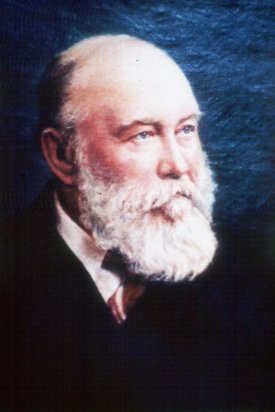
William Thomas Sugg 1832 – 1907
Welcome to my Web site!
Hello, my name is William Thomas Sugg and I was born on 17th October 1832. I died on 28th February 1907 more than 100 years ago and I have entrusted my great grandson, Christopher, with telling you something about my life… This is Christopher demonstrating various gas lighting burners at the Royal Institution in 2005 —- plus ca change, plus c’est la meme chose —–
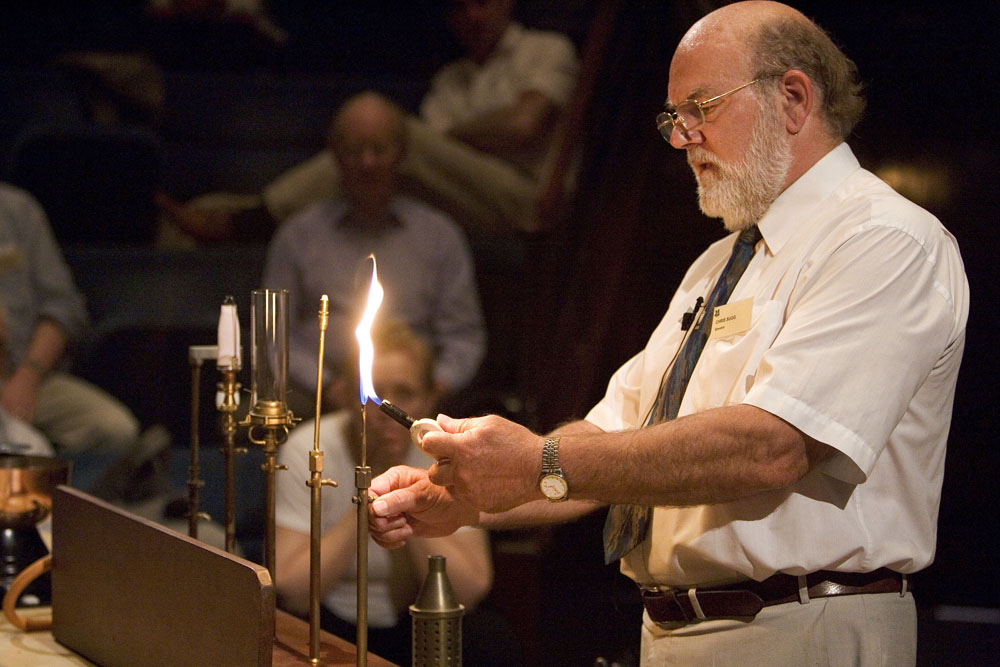
(This History section has now been split into a number of sub sections to make it easier to comprehend.) CS
Section 1. Family History, the earliest connection with gas and the point at which WTS took over on the death of his Father.
Section 2. The growth of the business under the leadership of William Thomas Sugg as sole trader during the Victorian era.
Section 3. The formation of the Limited Company and its growth up to the death of WTS in 1907.
Section 4. 20th Century growth of the Company, two world wars and finally the takeover.
Section 1
Family History, the earliest connection with gas and the point at which WTS took over on the death of his Father.
I was born 4th into a family that eventually reached 10 children. Mind you, that’s nothing because in my time I had 15 children! Of course things were very different in those days. My father was also called William and he gave me two names so we didn’t get muddled but I always wanted to be just William so after Father died I stopped signing myself W.T.Sugg and reverted to William. Of course I didn’t realise just how difficult it could make things for future researchers but at least no-one could mistake William Sugg & Co as being anything but my company!
Our family had lived in Somerset for generations but it was great grandfather John who made the big step away from rural life to the Metropolis. Unfortunately it was because he had failed in business as a grazier and bleacher in Crewkerne! He had, however, one big asset in his young wife. She was one of three sisters of the Faulkner family also from Crewkerne. One sister married a Mr Gibson of Fenchurch Street and the other married a Mr Price of York Street, Westminster, so when things went wrong you can just imagine the three sisters getting together and how John might have been persuaded to follow the others “to seek his fortune”. We are talking of a date in the last quarter of the 18th century – around, say, 1785 when John would already have been 55. They remained a close knit family as we find that two of John’s children worked for their uncles in London at various stages. The one we are going to follow is my grandfather, Thomas, who was the youngest born in 1771 and, like the other three, lived in Crewkerne before the move to London.
My grandfather, Thomas, must have been a remarkable man. On the basis of the date above he would have been only about 14 when the family moved to London and you can just imagine the excitement for a young person arriving in London. The numbers of people, the noise, the traffic compared with their country life. Of course he would have been expected to work for the family’s joint living and it seems that he got a job with Uncle Price in Westminster who was a “tinman”. This title was given to craftsmen who worked in metal and produced products of a wide range. In later centuries you would call them “tinsmiths” or “sheet metal workers”. As his skills developed he became a fully fledged “ironmonger” and moved to High Street, Hoxton where he set up shop at No.55. Many of you reading this would only know an ironmonger as a shop full of pre-packed nuts and bolts and loads of practical items but, as you might guess if you thought about the name, an ironmonger was a man who dealt in all things metal and practical and made anything that was needed.
By now Thomas had a wife, Sarah, who he married in St John the Evangelist, Millbank in June 1793. Life must have been really tough for the young married couple because when they had their first son Henry, in 1794, they simply could not afford to keep him. It may seem unlikely in your century where so much support is available but, if you had no money then, you didn’t eat and an extra mouth could push you over the edge. Fortunately, families were very close in those days and little Henry was adopted by second cousin Sarah who was married to Henry Hatchard and I believe could not have children of her own. They never forced him to change his surname and in due course on the death of his adoptive parents he became the owner of their business – Carpenter & Undertaker of 95, York Street, Westminster. He also became a well respected member of the community, as a collector of taxes and churchwarden of St Margaret’s, Westminster.
But I digress! After Henry had been adopted it was another two years before Thomas and Sarah had their second child. Exactly when Thomas made the move to Hoxton I am not sure but it wasn’t until he was 36 in 1807 that he laid the foundation of what was to inspire ‘my’ business.
(The 1841 Post Office London Directory has the entry; Sugg Thomas, gas fitter and meter maker, 55 High Street, Hoxton) C.S.
There are a number of people who lay claim to having been the inventor of gas lighting, Friedrich Albrecht Winzer (later anglicised to Frederick Albert Winsor) born in Germany in 1763, was certainly one of them – despite the fact that he had gained his knowledge from Philip Lebon in Paris. What Winsor did through a number of advertisements and pamphlets was to attract public attention to a series of experiments and lectures at The Lyceum Theatre in London from about 1803, on the subject of “Gas Light”. Here he described the advantages, its freedom from sparks which so often caused fires with other sources, the absence of smoke and the intensity and steadiness of the flame. It does sound as if everyone in London began to talk about gas lighting and it seems very likely that grandfather Thomas Sugg decided to go and have a look for himself. It is barely 3 miles from Bacchus Walk in Hoxton to Pall Mall and I suspect that once he had seen what Winsor was up to, Thomas offered his very practical services to assist in the demonstrations, especially in the manufacture and installation of the pipes to carry the gas from Mr Winsor’s house in Pall Mall a considerable distance to the wall of Carlton House Terrace. According to contemporary accounts, the pipes were of tinned iron with soldered joints with the long pipe being 1.1/2″ diameter. The contemporary account of the first public demonstration in the Monthly Magazine of July 1807 states that it took place on 4th June 1807 to coincide with the birthday of His Majesty King George IV.
(A complete transcript of the article in the Monthly Magazine has been added as a blog dated April 2017)
I don’t intend to tell you any more about the early development of the gas industry other than through the products of William Sugg & Co, as it is well documented elsewhere. However, you now have the link between Sugg and gas. Grandfather Thomas went on to have 10 children with Sarah and unfortunately died in one of the outbreaks of cholera in 1832, his 60th year, the same year that I was born.
(The 1852 Post Office London Directory has ‘Sugg Thomas, meter maker and gas fitter at 168 Hoxton Old Town’. We know, however that Thomas died in 1832 so the most likely explanation is that Thomas’s third son who was also called Thomas may well have been working with his father and being 34 at the time of the latter’s death, continued the business and moved it to the Old Town address. ‘Son’ Thomas died in 1874 and there is no entry in the 1884 directory.) C.S.
My father, William, was Thomas and Sarah’s fifth child and he was born on 23rd July 1803, so he was only 3 years old when his father got involved with gas. It is clear that there was a huge amount of interest in the developing industry and, with the practical nature that seems to run through our family he went to work for “Edges”, a meter maker in Great Peter Street, Westminster – no doubt encouraged by his father who as we have seen also made meters. At the end of 1837 he ‘started for himself’ at 19 & 20 Marsham Street, Westminster where he worked until he died.
(The same 1841 directory that lists ‘Sugg, Thomas’ also carries “Sugg, Pywell & Co, gas meter manufacturers, brassfounders and gas fitters, 19 & 20 Marsham Street”) C.S.
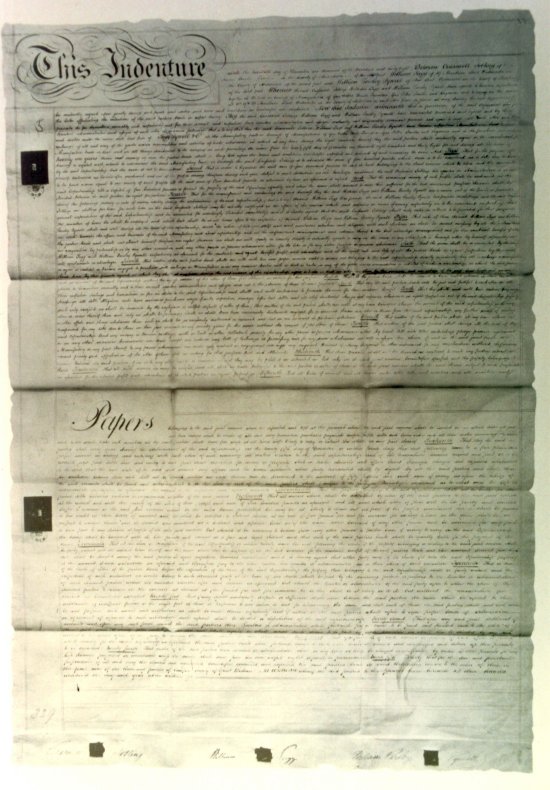
The Original Co-Partnership Agreement of 1837?
(The reason for the question mark is that the agreement date so far as I can read – from the copy of the document – says 20th December 1838. The Centenary booklet, however states 1837 and the centenary definitely took place in 1937 – not 1938! Further research is needed!) C.S. (Further down in the prospectus for the sale of the Company in 1881 it states that the well known business of Mr Sugg has been established since 1838 and the picture taken on the roof of Vincent works ‘to mark the Jubilee of the House in 1937’ is actually dated 1888!)
The original partnership agreement shows that Father entered into an agreement with two of his contemporaries:
“To carry on the trade and business of Manufacturers of Gas Meters, Brass Founders, Gas Fitters, Smiths and Engineers.”
Father was to receive £3 per week, William Parsley Pywell, 50 shillings per week and Craswell P.Jobling one shilling per hour, presumably to ensure that he took his position seriously! I feel sure that these two partners brought practical skills to the business and Father decided that they should have a status as originators of the business whilst still making it clear who was the boss! It was not to last long.
(We know from official records, that “the partnership was dissolved by mutual consent between Craswell Jobling, William Sugg, and William Parsley Pywell trading as Sugg, Pywell, and Co. brass founders engineers and gas fitters of no 19 and 20 Marsham Street Westminster – 18th December 1840”. So it would seem that the phrase “started for himself” was something of a misnomer as the business began as a partnership (at the end of 1837 or was it 1838?) called Sugg, Pywell and Co not becoming William Sugg & Co until the end of 1840. For the purposes of this history I believe it reasonable to consider the business as dating from 1837 as the premises remained the same. It would seem likely, however, that there might well have been rivalry, if not competition, between the William Sugg company and the Thomas Sugg business, by then run by his brother!) C.S.
William Sugg 1803 – 1860, The Founder.
This picture of William is the one that appeared in the Centenary booklet that I think has been somewhat gentrified. A pair of miniatures illustrating both William and his wife may provide a closer indication of a hard working man!
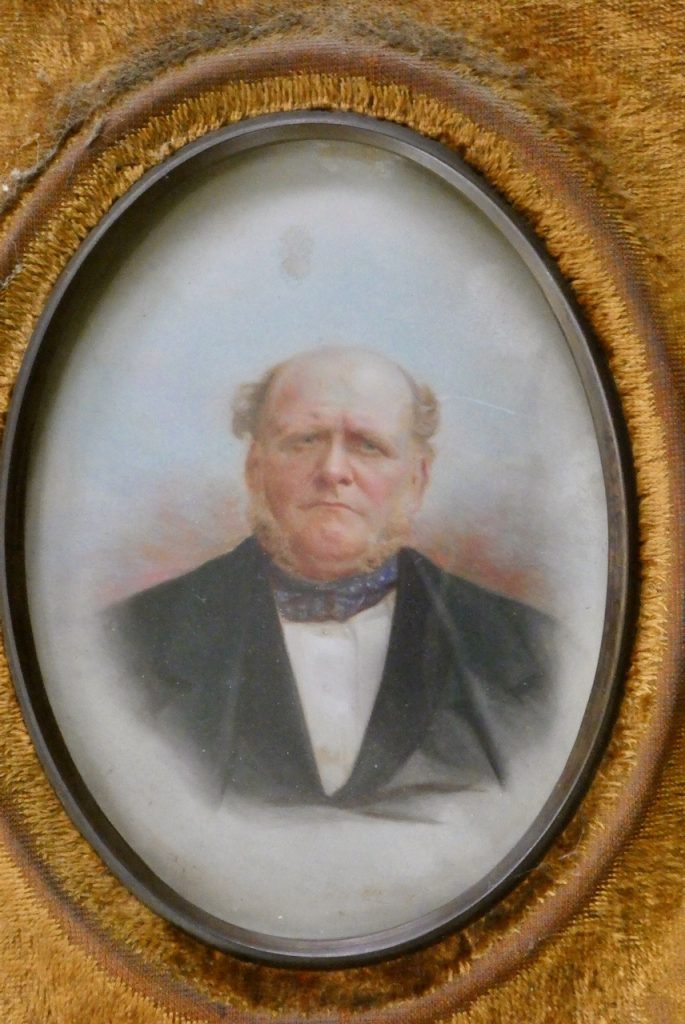
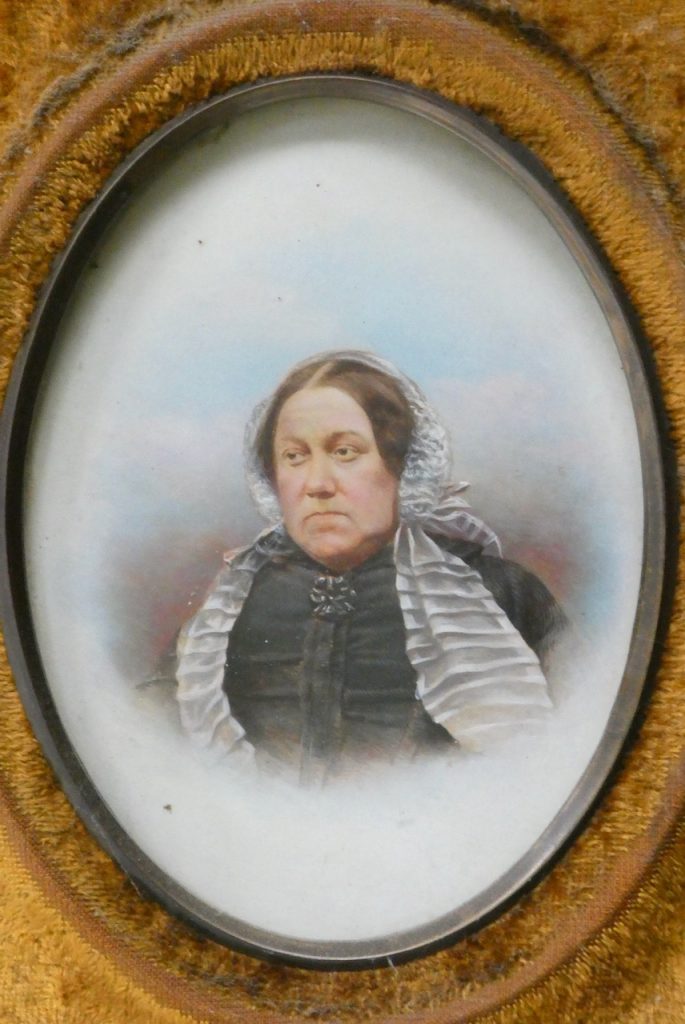
My mother was Elizabeth Aincham and she and father married in 1826 when father was just on 23. In no time the family began to grow, Robert in 1827, Susannah in 1829, Elizabeth in 1831 and then me, William Thomas, in 1832! I won’t bore you with names and dates any further but suffice it to say that my next brother and two of my sisters all died very young, leaving just 7 of us.
The very first issue of the magazine “The Builder” dated 31st December 1842 carries the following advertisement:
“William Sugg & Co., No.19 Marsham Street. Brass and Iron Founders, Gas Engineers and Fitters, Makers of Improved Patent Gas Meters, Manufacturers of every description of plain and ornamental bronze, brass and iron work for OIL or GAS. Fan lights, passage and lantern, plain or ornamental, Wholesale, Retail, and for Exportation. Casting for the Trade.”
You can see from this that only 2 years after the partnership was dissolved, Father had his sights set high! What it doesn’t show you is just how badly things had been going! Of course I didn’t know anything about this at the age of 10, although I am sure the atmosphere between my parents was sometimes not very comfortable! What I hadn’t realised until some time later was that Father had set the business up as a partnership and must have become very unhappy with the result as less than three months after the dissolution of the partnership there is a further agreement which both Father and Mr Pywell – despite no longer being a partner – sign and seal.
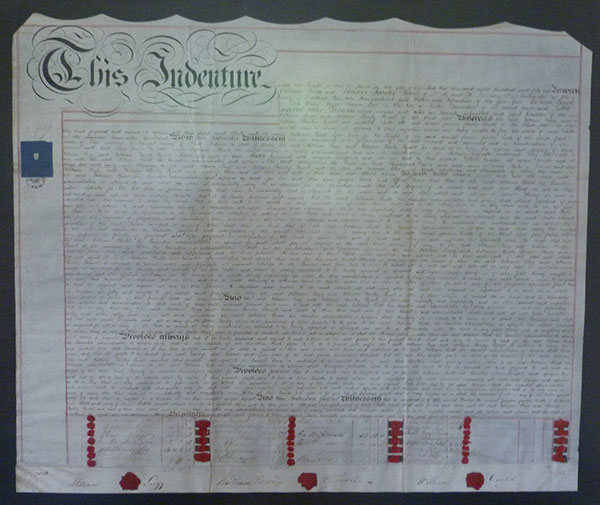
An accountant, Mr William Gould, the third party to this agreement dated 9th March 1841, indicates that he was prepared to take on the responsibility for the Company debts against everything the remaining two partners owned! In addition, the 26 creditors are listed at the bottom of the agreement with their names and the sums that each is owed, varying from 14 shillings right up to 290 pounds 7 shillings and 5 pence to the aforementioned Mr William Gould! The two other signatories are Father and Pywell. The lowly paid Mr Jobling would clearly not add a lot of security to the agreement and he was discounted. In fact Mr Pywell is also not heard of again and may well have been frightened off by thoughts of the poor house. Father, on the other hand was made of sterner stuff and his advert in the Builder, above, less than two years after this agreement tells us that he was going to trade out of the problems. Exactly how they got into such a situation in only four years was never clear but it would be familiar to many small businesses even in your age, especially as the age of banking had yet to provide ‘working capital’. When I joined the business it was all over and I don’t even know what happened to Mr Gould. My job was to help the business to succeed.
My father had arranged for me to work at the South Metropolitan Gas Company under Thomas Livesey where I learned all about gas supply and appliances. What interested me was the design and technology, the detail of the business. It was clear to me very soon after joining Father that nobody really knew much about how things worked and why. I spent a great deal of time experimenting with how gas burned and why. It seems our efforts began to turn the business around as in 1847, the same year as our last and surviving brother was born, Father took a house in Hanwell so that we no longer lived ‘over the shop’. The business actually remained in the original premises for nearly 30 years.
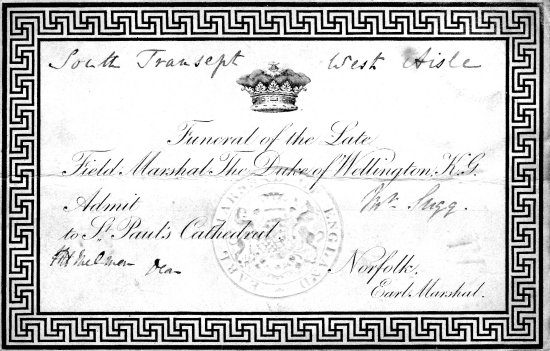
Amongst the more unusual items to survive the passing of the years is this invitation to ‘Mr Sugg’ to attend the state funeral of The Duke of Wellington which was held on 14th September 1852. (CS)
Section 2
The growth of the business under the leadership of William Thomas Sugg as sole trader during the Victorian era.
Sadly my father died of cholera when he was only in his 57th year in the May of 1860 when I was still 27. However by then I had really got my feet under the table and the business passed to me without any complaint! Now was my chance to really do something in this fast accelerating industry.
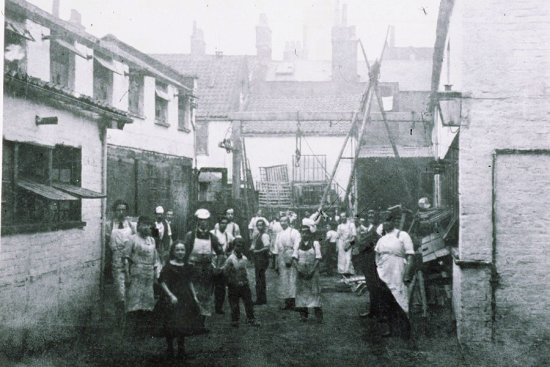
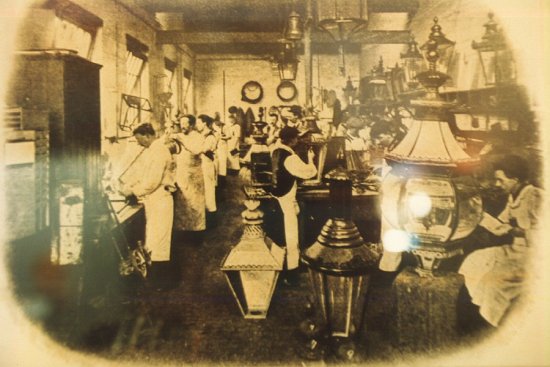
The Marsham Street Factory
Of course I cannot proceed further without a little more personal history because the family is so intertwined with the Company. By the time I took over the business I had been married for 5 years and we had one son, David William who was 5, one daughter, Lizzie, 4 and my wife, Jane, was pregnant with what was to be our second son, Walter John, who became known as Jack. So you see I married not long after my 20th birthday — and it turned out to be a big mistake. I have to admit that Jane Parker was one of those women who is a young man’s dream. She was a barmaid and I was tempted. I am not going into the details here but I will tell you that David was born just 4 months after we were married. Unfortunately, my choice of Jane as a wife showed a lack of judgement for a long term relationship. I was eventually forced to use a private detective to obtain evidence of her unfaithfulness. In those days it was only a few years since it had required an Act of Parliament to obtain a divorce and so it was necessary to collect the evidence very carefully. I still have the account from the detective in which he lists all the details of his time and the costs. It did cost me a fortune but in the end I was granted a divorce in 1862 with the co-respondent being named as a Charles Moore.
As you might imagine, I was very upset and frankly put off the whole marriage business. I buried myself in my work and, funnily enough – or maybe understandably, this was one of my most productive periods. It was to be another 9 years before I ventured into the marriage stakes again at the age of 38 in 1871 and, what is more, I have my work to thank that I met Marie Jenny Fleurot!
One of the important features of my company was our apprenticeship arrangements. In common with many apprenticeships the term was for a period of 7 years and as can be seen in the indenture for one James Connor who commenced his apprenticeship on the 5th September 1869 he was paid 5/- (25p) per week for the first year. The pay progressed by 1/- (5p) per week each year until 1873 when it increased by 2/-per week each year until the 5th September 1876 and as you can see I signed him off as “having served his full time to my entire satisfaction.”
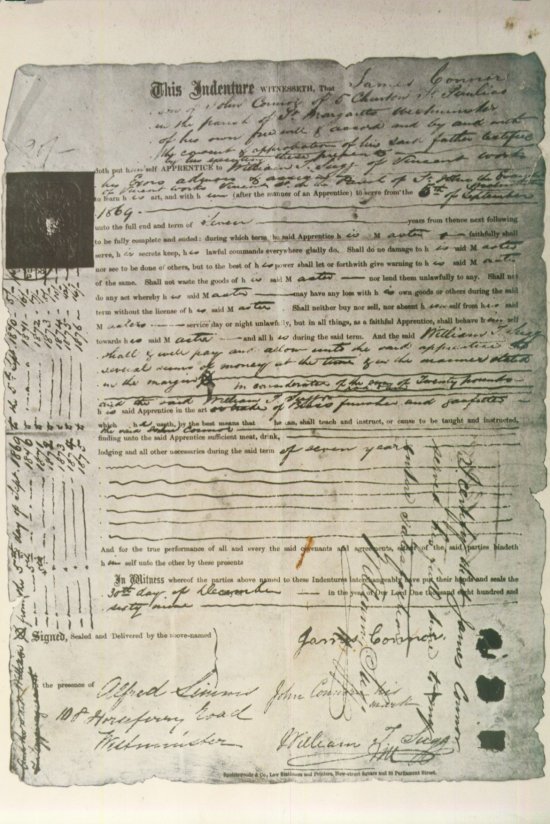
By 1866 the Marsham Street works was unable to cope with the amount of business that was coming in and, fortunately, I was able to secure some new premises close by in Regency Street between Page Street and Vincent Street. As you can see from the illustration below I called the premises Vincent Works and this became the heart of the business for nearly a century, albeit with several enlargements.
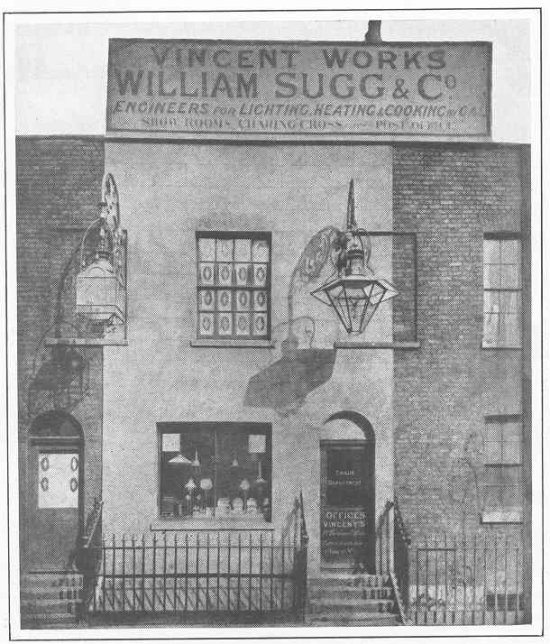
Vincent Works 1866 (The eventual extension to the factory was to the right of this frontage which appears to have remained almost untouched apart from the level of the road.)
The sign indicates the location of our showroom in Charing Cross – ‘nearby the Post Office’, a description that would mean a lot more in those days than in the 21st century! 1 & 2 Grand Hotel Buildings was just a stones throw from Trafalgar Square and provided a fabulous central location for our friends in the various Gas Company’s and the householder who wished to familiarise himself with the latest labour saving products and lighting designs. Trafalgar Square was a great showroom in itself with numerous Sugg lamps mounted on the surrounding walls and on posts at the junctions of several of the major roads where they joined the Square. At the end of the 20th century during the refurbishment of Trafalgar Square, three original William Sugg lamps still in their original positions were refurbished by Sugg Lighting and re-mounted on new cast lamp posts erected back in the Square, whilst a set of slightly smaller scaled versions were designed and manufactured and fitted around the Square on the walls from which the originals had been removed. It has to be admitted that all these fixtures are now operating with electric lighting sources but it is more important that the original Sugg designs can still be seen (even if they are not recognised by the millions who pass through the Square each year.) Let us hope that this website will help to educate just some of those millions!! (Installing a lamp post in Trafalgar Square is in itself a problem as much of the Square is over the Underground station! The ‘new’ Sugg posts are bolted to 1 metre diameter steel plates just below the original stone slabs! CS.)
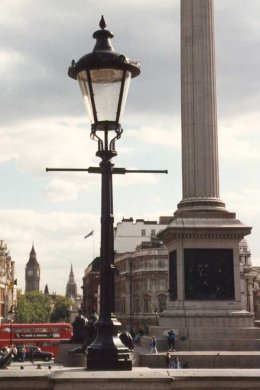
This is one of the new smaller scaled lanterns placed on the original pedestals around the wall of Trafalgar Square . They are based on 3 original Sugg Lanterns which were refurbished and repositioned on new posts within the square.
See also Location Pictures.
Reverting back to 1866 and the move to Vincent Works, I had been working hard with the “Argand” burner, designed originally by monsieur Argand as an oil burner with a circular wick. Having worked previously on plain gas jets, I felt that if I could achieve a circular ring of gas flame with combustion air passing up the centre as well as around the outside in a controlled fashion I would be able to produce a perfect, controllable, luminous bright flame. Many experiments later I achieved my goal and in 1869 the Gas Referees were persuaded by the result to adopt my “London” Argand as the Standard Test Burner for the Metropolis. In my promotional material I was allowed to quote their statement that:
“This burner of Mr Sugg’s excels all others.”
(The Gas Referees were a body set up to assure the quality of gas production from the hundreds of gas manufacturing plants around the country. Because the variety of coal mined in various parts of the country varied, it was important to be able to check that the gas produced was of a suitable and preferably equal quality which would provide the customers with good quality lighting. To do this the Referees needed a burner which would provide a basis for comparison when burning the different gases. The ‘London’ Argand was initially adopted for the Metropolis and subsequently is quoted as “prescribed in most Gas Companies’ Acts of Parliament.)
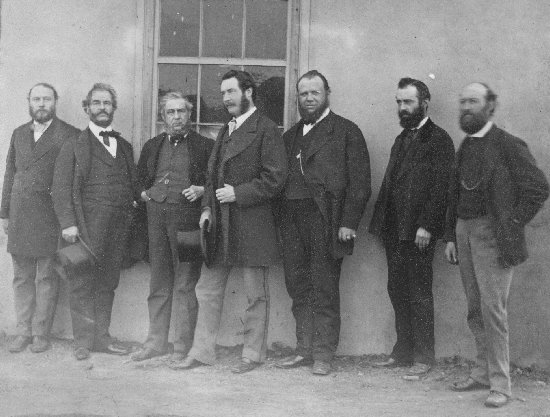
This picture is one of a pair taken during a visit to the Beckton Gas Works and is dated May 23rd 1870. Fortunately it carries the names of the gentlemen involved and in one case his job. From left to right it reads William Sugg, T.Page, Evans, Patterson R.H. (Gas Referee), Friedleben, Trewby and Wyatt.
BUT see below the next picture for later information on those in this picture.
(The Beckton Gas Works became the largest gas works in the world located on the north of the Thames not far from the location of the Millennium Dome – now the O2 Arena.)
Apart from Mr Patterson in the middle who clearly likes to cut a dash in his important position as Gas Referee, the name Friedleben rang a strong bell! My family records showed that William Sugg’s first daughter known as Lizzie married a Friedleben so this cannot be just a coincidence! However the gentleman in the picture must be at least as old as William so cannot be the Friedleben who married Lizzie in 1882. It was then that I met Claire, whose mother was born Friedleben making her a great great grandchild of William and his first wife Jane Parker. Claire has done a huge amount of family research and discovered that this Friedleben is Christoph, the father of Carl who married Lizzie, what’s more Claire discovered that Christoph was the Director of the gas works in Offenbach, Germany. C.S.
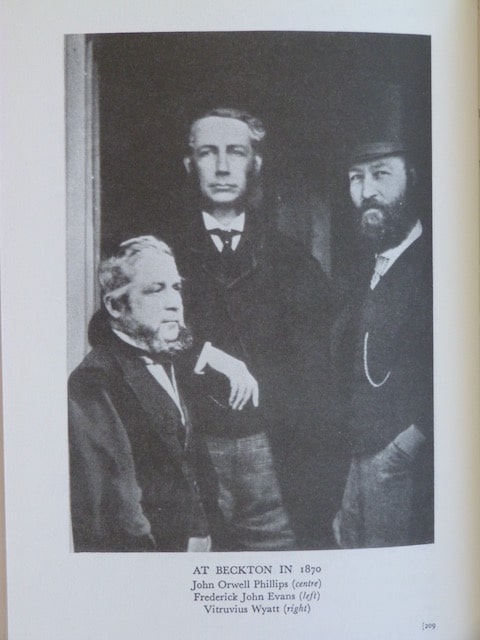
I was reading Stirling Everard’s book, on the History of The Gas Light & Coke Company when I came across this picture which looked familiar and realised that not only is it the same year 1870, but that two of the men are in my picture, Evans and Wyatt. This of course allowed me to discover that Phillips was the Secretary to the GLCC, Evans was Chief Engineer and Wyatt his right hand man as Constructing Engineer. Trewby, from my picture, would have just become Superintendent of Beckton. Mr Page in my picture is not listed in the book but then, neither is William Sugg!
Another family connection provides an extraordinary coincidence with the Beckton Gas Works and the picture with William Sugg above. One of William’s daughters, Berthe married into the Duquenoy family and in 2009 I was contacted by Simon Duquenoy who was researching his family history. During our correspondence Simon said that he had a box with an interesting plaque and sent me the following photos:
The plaque says: “This box is made from wood obtained 25 feet below the surface of the ground in digging the foundation for the gas works at Beckton, North Woolwich. Wood supposed to be yew.1869”
It is possible that William was presented with this box at the same time as the visit in which he is photographed above. If the wood was only dug up in 1869 for the foundations their visit in May 1870 must have been during construction.
Since this last comment, Claire who is mentioned above and whose mother was a Friedleben, has found that Mr Evans in the picture was the chief engineer of the Chartered Gas Company who was building the Gas Works. The ‘Gas Magazine’ reported that “on Thursday June 9th 1870, 180 members and friends went by steamer to visit the new gas works in course of erection at Beckton. Met by Mr Evans he showed them drawings and over the site then entertained them to luncheon. A hearty repast was enjoyed and a toast given to the company.”
So it looks as if the small group picture which is just 17 days before this major visit must have been a much more personal one and adds weight to the possibility of the presentation of the yew box.
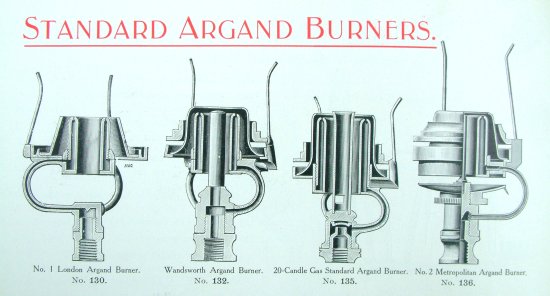
The Argand Burner is described and illustrated in the Lighting Section – Burners – Christiania & Argand.
This success spurred me on especially in the field of photometrics which is the science of the measurement of light. It is all very well to burn gas to produce light but without knowing what that means there is no way to make comparisons or improve efficiency.
Many years ago I realised that it was necessary to establish a unit for the measurement of light and in 1862, when I had been working on the lighting of the Grand Committee Room of the House of Commons, I decided on an observational experiment. I made some pencil markings on a piece of paper and took half a dozen men to read the paper at whatever distance they found convenient. The answer was one ft candle, i.e. one candle at a distance of one foot. This provided me with a basis of comparison for all other measurements of light and, indeed, became the unit in common use.
This commentary is drawn from a paper read to the ‘Civil’s’ by Alexander Pelham Trotter in 1892 on ‘The distribution and measurement of illumination’ which was attended by William. In the following discussion Mr W.J.Dibden said that Mr Sugg first proposed the ft candle thirty years ago as the unit for illumination. WTS then added several observations from which the one above is drawn. He also commented that the room in question was the only room where he had been able to feel satisfied in the lighting. (This important reference was found for me by Geoff Brundrett – a co-member of the CIBSE Heritage Panel who had remembered reading it on some occasion and finally unearthed it! CS)
Eventually we had an excellent lighting laboratory which was not improved until my grandson Crawford Sugg joined the Company in the 1930’s and designed the very clever ‘mirror head’ device – about which more later! By the turn of the nineteenth century, however, the Company was able to provide a huge range of scientific technical equipment as part of their sales effort and this is illustrated in the Technical Section.
Whilst working on the Argand burner I had not forgotten the flat flame burner. In my mind there was always room for both types of burner. The Argand was always going to be more complicated and thus more expensive than the flat flame burner and was likely to require more maintenance. The glass chimneys were always going to suffer from breakage where the flat flame had none. I decided that the best approach for interior lighting was to design a range of fixtures which could use either burner in a common structure and apply careful aesthetic design to the whole. So it was, in 1869, the same year as the London Argand was adopted that my “Christiania” flat flame burner sold in huge numbers. (Look in the Lighting Section – Burners – Christiania & Argand for more information on these important products.)
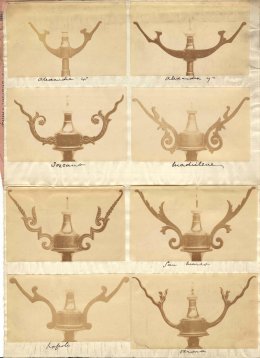
Original photographs of a selection of Christiania burners. A larger version of this photo is included in Lighting Section – Burners – Christiania & Argand
One of the features that made the Christiania fixtures popular was the beautiful hand painted glassware that I obtained from France.
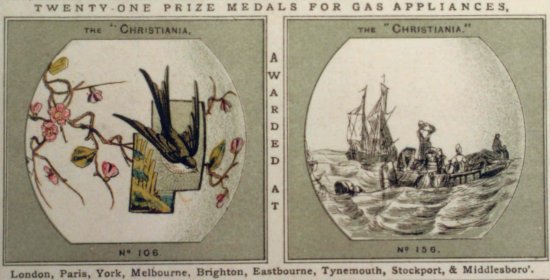
This was not my only connection with France, as gas lighting was in demand all over the developed world. Paris had adopted gas lighting in 1820 and by the 1870’s our burners and fixtures were being used so widely that I decided to open an office in that beautiful city. Unfortunately, the Franco Prussian War which led to the four month Siege of Paris 1870 – 1871 was a major problem! It did however lead to my meeting Marie Jenny Fleurot. (Frances Robinson, granddaughter of William & Jenny who remembered her grandmother well, told me in 1987 that Jenny was actually rescued by William during the siege and she was left with nothing. The siege ended on 27th January 1871 but there were continuing problems and it may well have been after the signing of the armistice but before the arrival of the Paris commune with its own trials and tribulations. CS.) To cut a long story short, we were married in July 1871 just before Jenny’s 21st birthday – when I was 38!
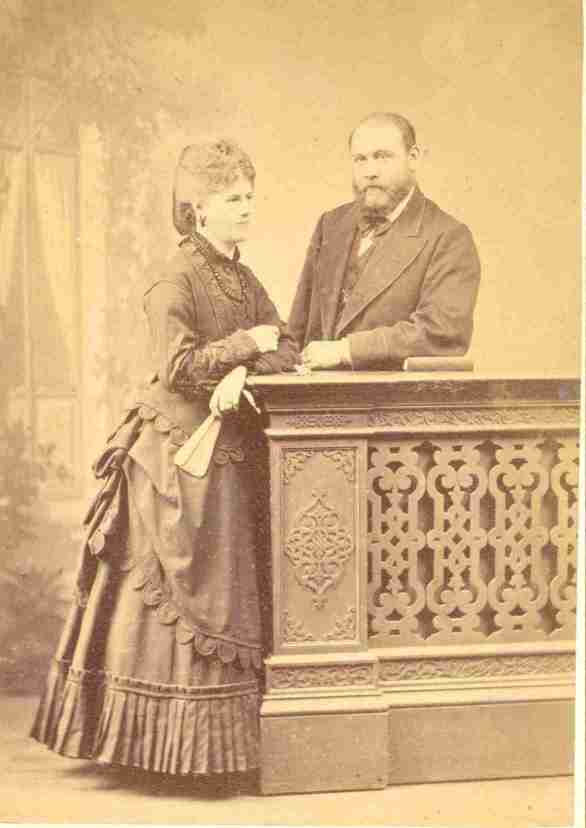
Marie Jenny Fleurot and William Thomas Sugg the day before they married July 1871
We were married twice, once in Paris and once in London to satisfy all sides! Jenny, as she was known to everyone was a very special lady. Of course my French improved enormously and all our children were bilingual. In fact Jenny would chat away in French to her daughters in particular and, when there was anything of importance she would always speak or write in her native language. In due course I became the translator on the many trips that I took to France with the Gas Institute and other groups!
Our family grew, along with the business and we were blessed with 12 children and only poor Robert Pierre died after only 8 months. Our last child was born in 1888 when I was 56.
Jenny remained in contact with her family in Paris and many of our children have the same French names as her family. (Another confusion for the genealogist!) Because Jenny was so much younger than me it was clear that she would live many years beyond me and her family, as well as our own family, were very important to her.
Great grandson Christopher has a substantial computer based family genealogy archive which he started as a card index back in 1969. Much of the early information had been collected by my first cousin John Walter Sugg who was born in January 1835 a little over two years after me (not to be confused with Walter John mentioned earlier). He also married one of my sisters, Rebekah Ann so we were very close. (Yes, his first cousin). John was the son of the Henry I mentioned earlier who was adopted by the Hatchard family and became the owner of their business as carpenter and undertaker. John followed that side of the family and I suspect that his interest in the family history is connected to both his father’s adoption and his calling! He carried a small notebook in which he listed all the family members and cousins and second cousins and more that he could record. Fortunately it survived and provided a major starting point for the family archive.
Wages book 1877 – 1882
(One of the few company record books with names that has survived is a hard back wages book dating from Friday August 17th 1877 with 13 names to Friday 30th June 1882 with 30 names. I think this is just the office staff. CS)
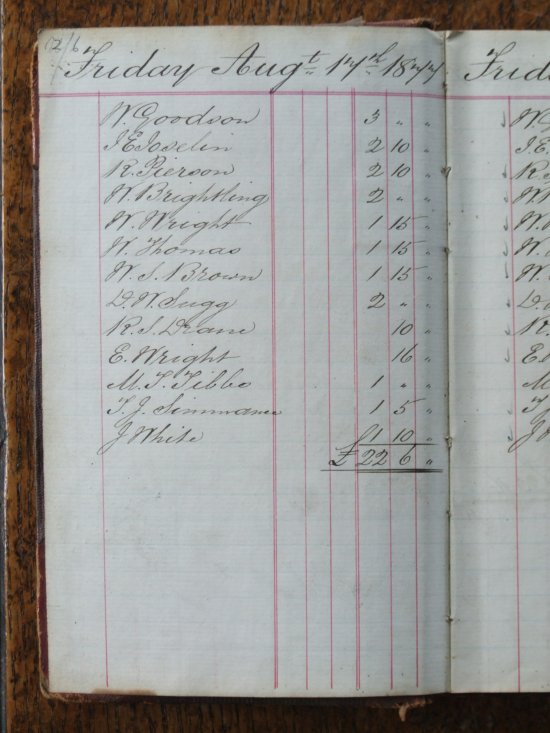
(Note the entry for DW Sugg and also for both W Wright and E Wright. This list somewhat disguises the fact that, according to my records at this date Edwin Wright is 17 whilst his younger brother, Walter, is only 11 but apparently earns more than his older brother. David William Sugg, William’s first child is 24.CS)
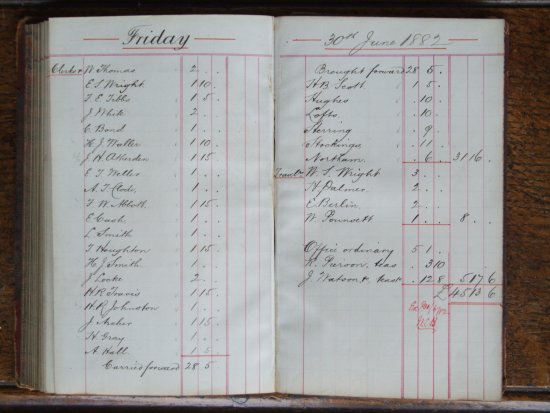
(At this date, 5 years later, there are no Suggs but both of the Wright names have gained an ‘S’ i.e. ES Wright and WS Wright and this is because they are both the children of Simeon Wright and William’s elder sister, Susannah Amelia Sugg, and they became known as the Sugg-Wrights! It is notable that Edwin has gone from 16/- to £1:10s whilst Walter has advanced from £1:15s to £3, retaining his lead over his older brother! Walter was perhaps the more outgoing as, against his name and the three below him is the word ‘Travellers’ who are the Company Representatives. He still seems exceptionally young as he will be only 16 in 1882.
It was Edwin, however, who was eventually to succeed William on his death which you can read about further down. CS)
I was always determined to record the progress of my inventions by giving lectures and publishing both these and a number of books setting out the development of the many products over the years. The aim was to educate and of course provide both the Industry personnel and the interested private user with the added confidence that leads to increased sales! For the same reason we showed our wares at many national and international exhibitions and won many medals (which also survive into the 21st century.) They were often used in our advertising as another means of confidence building for our customers.
My 1880s headed paper looked like this
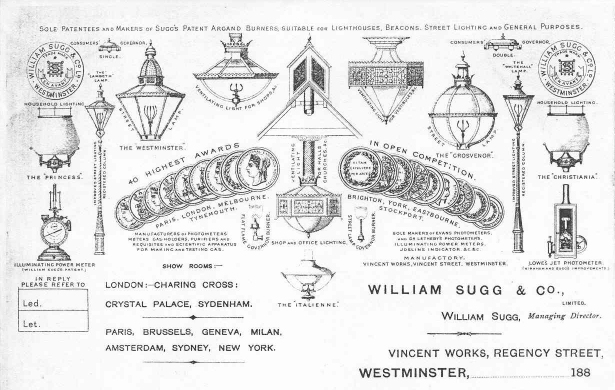
An example of its use is shown below, sent to me by Robyn Byrne, nee Turnbull, the great great granddaughter of Alfred Ernest Turnbull who it seems was laid off and decided to try his luck in Australia. She added:
“Edward arrived in Australia in 1887 with this reference and a letter form J. Coates & Co. Engineers giving him the address of their business in Melbourne. I am not sure if he followed employment up there or not. His life in Australia was only short-lived as he died in 1897. His occupation at the time was recorded as a blacksmith.”
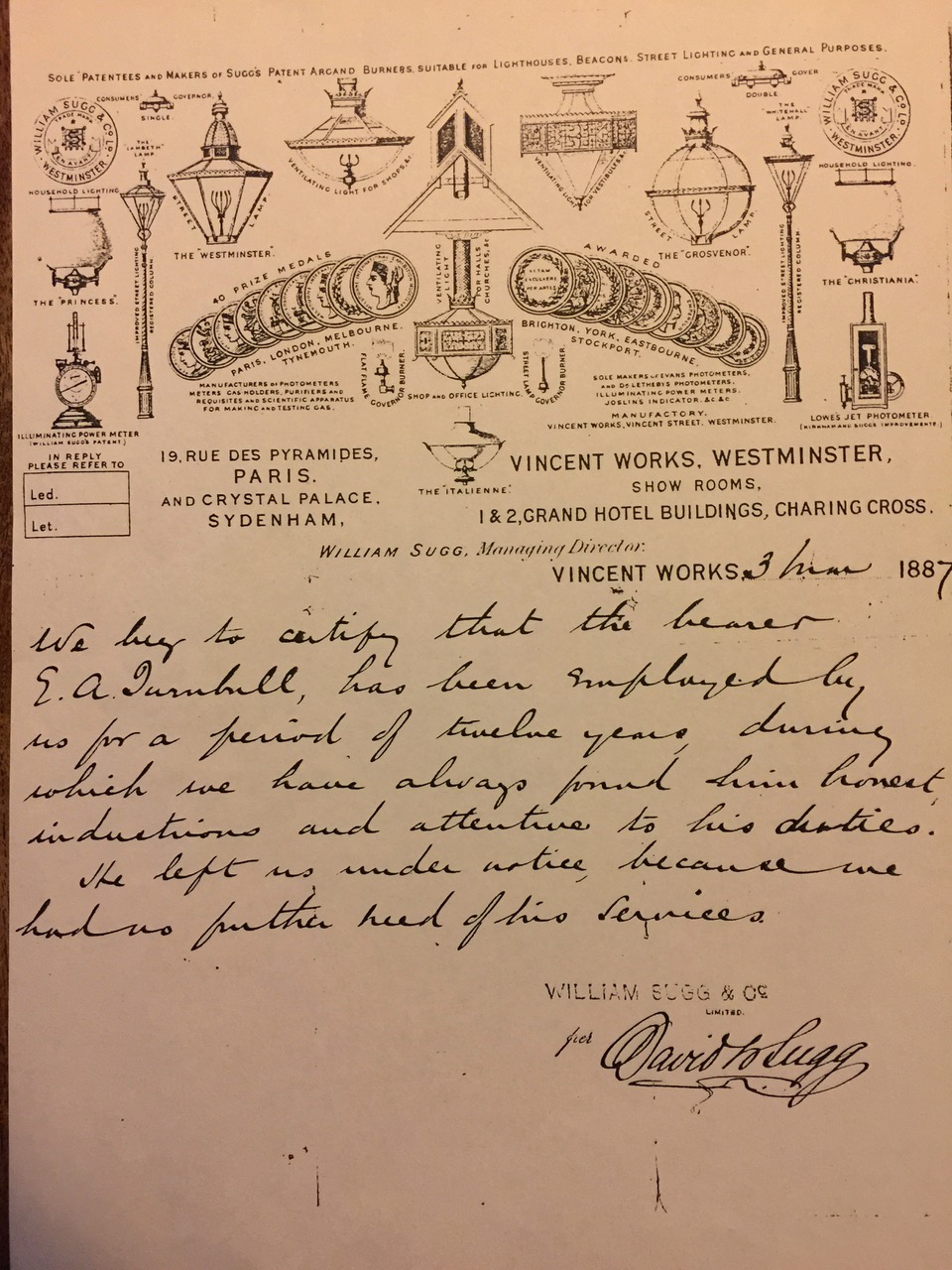
MEDALS WON BY WILLIAM SUGG & CO BETWEEN 1862 & 1913.
The following list of medals is made up from two original lists which vary only slightly in content. One, however, starts in 1862 and runs to 1906 describing what the award was for, whereas the other was started on 30th June 1888 and continued being updated until 1913 with ‘comments’ obviously intended to clarify the whereabouts of the medals in 1906. With the death of William in 1907 it may have been that medals were not considered to be so important or that the whole world of exhibitions was becoming an expense that the Company no longer wished to bear. Exhibitions as far away as Melbourne (twice) and Calcutta must have been a considerable drain on the Company’s fortunes.
| Place | Year | Award | Comment! |
|---|---|---|---|
| London | 1862 | 2 Bronze Medals (Highest) | 1 only had, in safe |
| for Gas Burners, Photometers and Gas Apparatus | |||
| Paris | 1867 | 2 Bronze (Highest) | 1 only had, in safe |
| for Gas Burners and Photometrical Apparatus | |||
| London | 1871 | Diploma (Highest) | |
| for Improved Jet Photometers | |||
| Paris | 1878 | 2 Gold Medals (Highest) | 1 only had, in safe |
| for Gas Burners, Governors, Illuminating Power Meter & Photometrical Apparatus | |||
| York | 1879 | 1 Bronze (Highest) | In safe |
| for Gas Burners and Fittings | |||
| Melbourne | 14th Mar 1881 | 2 Silver (Highest) (See extract from Melbourne Argus in Street Lighting/Large Lanterns) | 1 only had |
| for Gas Burners, Shadowless Lamps and Photometrical Apparatus | |||
| Glasgow | 1880 | 1 Bronze (Highest) | In hand of Sotors? Re Nelson |
| for Gas Governors | |||
| Eastbourne | 1881 | 1 Silver (Highest) | In safe |
| for Gas Governors and Burners | |||
| Brighton | 1881 | 1 Bronze (Highest) | In safe |
| for Gas Burners and Fittings | |||
| Tynemouth | 1882 | 1 Silver (Highest) | In safe |
| for Gas Burners and Shadowless Lamps | |||
| Stockport | 1882 | 3 Silver (Highest) | In safe |
| for Gas Burners, Shadowless Lamps and improved "Colchester" Sun Burners | |||
| Stockport | 1882 | 1 Bronze | In safe |
| for Consumer's Governors | |||
| Middlesbro’ | 1883 | 5 Silver (Highest) | Diplomas only had |
| for Gas Burners (Ordinary & with Governors), Street Lamp Governors, Patent "Vincent" Light and High Power Street Lamps | |||
| Crystal Palace | 1883 | 5 Silver (Highest) | In safe |
| for Gas Burners, High-Power Gas Lamps, Heating Stoves and Patent "Therma" or Instantaneous Water Heater | |||
| Calcutta | 1884 | 1 Silver (Highest) | In safe |
| for Gas Burners, Lamps etc | |||
| Falmouth | 1884 | 1 Silver (Highest) | In safe |
| for Sugg's Patent "Taj" Lamps for lighting Churches, Halls, etc | |||
| Crystal Palace Intl. | 1884 | Dipl. of Honour (Highest) | |
| for Gas Burners, Lamps, etc | |||
| International Health | 1884 | 1 Gold (Highest) | In safe |
| for Gas Burners, High-Power Lamps, etc | |||
| International Health | 1884 | 1 Silver | In safe |
| for "Charing Cross" Gas Fires, Gas Kitcheners etc | |||
| Intl. Inventions | 1885 | 1 Gold (Highest) | In safe |
| for the "Cromartie" Gas Lamp, Photometrical Apparatus etc | |||
| Intl. Food & Cookery | 1885 | 1 Silver (Highest) | In safe |
| for Dining-Room Lights, "Christiania" Gas Burners etc | |||
| Berkhamsted | 1886 | 1 Silver | In safe |
| for Gas Burners, Lamps etc | |||
| Liverpool | 1886 | 2 Gold (Silver gilt) | |
| for Gas Burners "Cromartie" Lamps etc | |||
| 1 Silver | In safe | ||
| for Dock and Harbour Lamps | |||
| Edinburgh | 1886 | 1 Silver | |
| for Gas Lamps and Burners | |||
| Univl Food & Cookery | 1888 | 1 Gold (Silver gilt) | |
| for Gas Kitcheners | |||
| Melbourne | 1888 | Silver, First Order of Merit (Highest) | In safe |
| for Patent Lamps, Burners etc | |||
| Royal Polytechnic Society, Falmouth | 1889 | 1 Bronze (Highest) | |
| for Gas Burners | |||
| Univl Cookery & Food | May 1889 | 1 Gold (Highest) | |
| for Gas Kitcheners, Grillers and Hot Plates | |||
| Paris | 1889 | 1 Gold (Highest) | In safe |
| for Patent Ventilating and other Gas Burners, Lamps, etc. | |||
| Intl. Food & Cookery | Nov 1889 | 1 Gold | |
| for Gas Kitcheners, Grillers, Hot Plates, Gas Fires. etc. | |||
| Intl. Cookery & Food | 1890 | 2 Gold (Highest) | |
| for "Westminster" and other Gas Kitcheners, Hot Plates, etc | |||
| Amsterdam | 1890 | 1 Bronze (Highest) | In safe |
| for Lighting and Cooking Apparatus | |||
| Sanitary Institute | May 1892 | Medal of The Institute | In safe |
| for Cromartie Lamp | |||
| Univl. Cookery & Food | May 1892 | Dipl. of Honour (Highest) | |
| for Gas Cooking Apparatus | |||
| Hague Health | Aug. 1892 | 4 Prizes of Hon (Highest) | 1 list has a medal in safe |
| for Gas Burners, Ventilators, Cooking, Lighting and Heating Apparatus | |||
| Health, Portsmouth | Sept 1892 | Certificate of Merit | |
| Highest award for Gs Cooking Appliances for "Westminster" Gas Kitcheners | |||
| Gonda Gas Exhibition | Oct 1892 | 3 Gold (Highest) | I list has 1 silver in safe |
| for Gas Lighting Apparatus, Gas Stoves and Burners | |||
| Sanitary Institute | 1893 | Certificate of Merit | |
| for Gas Kitcheners | |||
| Univl. Cookery & Food | 1893 | Gold (Highest) | I list, 1 Silver Gilt in safe |
| for "Westminster" Gas Kitchener | |||
| Intl Bakery, Amst'dam | 1894 | Gold Medal & Dip of Hon. | I list, 1 Silver Gilt in safe |
| for Gas "Confectioner" Ovens etc | |||
| Univl. Cookery & Food | 1895 | Gold (Highest) | I list, 1 Silver Gilt in safe |
| for Gas Cooking Appliances | |||
| Univl. Cookery & Food | 1896 | Gold (Highest) & Silver | I list, 1 Silver Gilt in safe |
| for Gas Kitcheners | |||
| Univl. Cookery & Food | 1897 | Prix d'Honneur (Highest) | I list, 1 Silver Gilt in safe |
| for Gas Cooking Appliances | |||
| Institute of Cookery & Food | 1899 | 1 Silver Gilt | Does not exist on one list. In safe on other |
| Univl. Cookery & Food | 1903 | Prix d'Honneur (Highest) | I list, 1 Silver Gilt in safe |
| for Gas Cooking Appliances | |||
| Univl. Cookery & Food | 1904 | Dipl. of Honour (Highest) | |
| for Gas Cooking Appliances | |||
| Intl. Gas Exhibition | 1904 | 1 Silver | Does not exist on one list. In safe on other |
| Sanitary Institute | 1905 | 3 Bronze | In safe |
| for High-Pressure Incandescent Gas Light for Street Lighting, Gas Cooker & Billiard- Table Light | |||
| Univl. Cookery & Food | 1906 | Gold (Highest) | I list, 1 Silver Gilt in safe |
| for High-Pressure Gas Cooking Stove | |||
| Antwerp | 1913 | 1 Silver Gilt | Does not exist on one list. In safe on other |
As you can see several exhibitions are in European cities, one in India and two in Australia – a long way to go in 1881 especially as it seems they only ‘had’ one of the two silver medals awarded! C.S.
The following extract from the Journal of Gas Lighting reports the trial of several Sugg lamps in St Louis, Mo in October 1881 in competition with electric lamps. “The Sugg lamps fulfilled all expectations and are continued on the principal street by the Gas Company”
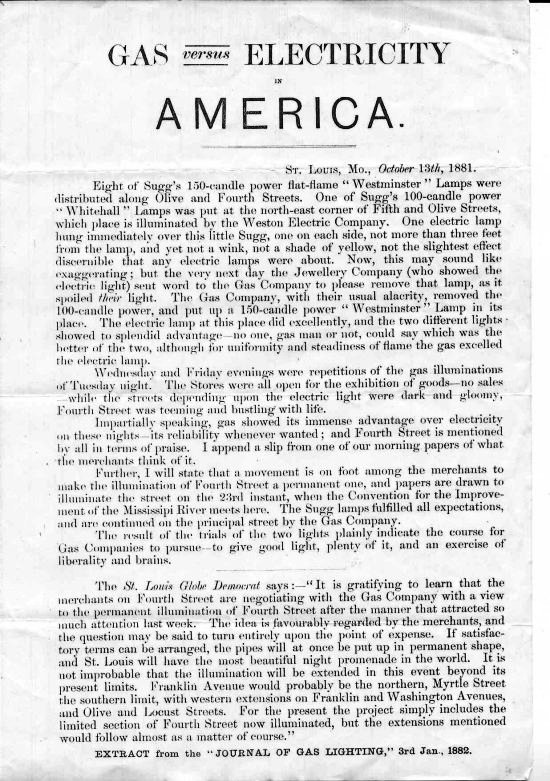
To help my staff gain skills in the areas of design I sent many of them to study design at the college in South Kensington and the result can clearly be seen in the aesthetic balance of the many hundreds of lighting products that poured out of the factory some of which can be seen particularly in the Lighting Section – Interior Lamps. Even practical products can be made to look attractive and by displaying them to their best will always sell to the discerning customer even over less expensive products. (See Lighting Section – Burners – Open Flame for a burner display case for example)
Very Early Full Colour Advertising Illustrating the Improvement Obtained Using Sugg Christiania Burners.
CLICK TO ENLARGE so that you can read the paper being read in both pictures by the gent alluding to the gas referees report and to other Sugg products. Never waste an opportunity!
I did spend a lot of money on advertising and promotion and was convinced that this was an essential element of the progress of the Company associated with the production of quality products. Apart from the offices at 19 rue des Pyramides in Paris I also opened offices at Crystal Palace, 33 Bold Street, Liverpool and 409, Keizersgracht, Amsterdam.
I was equally keen that the works staff had as good a life as possible and I think you will agree that these wonderful pictures of the men and the women of the works which were taken by one of the staff with a pin-hole camera and found by Christopher, illustrate a workforce who enjoyed their work. The pictures seem to have been taken at lunch time as you can see the men’s sandwiches!
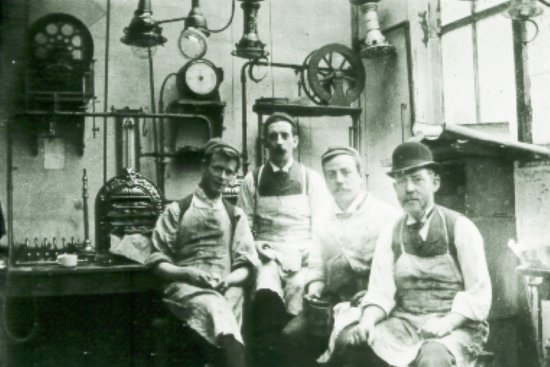
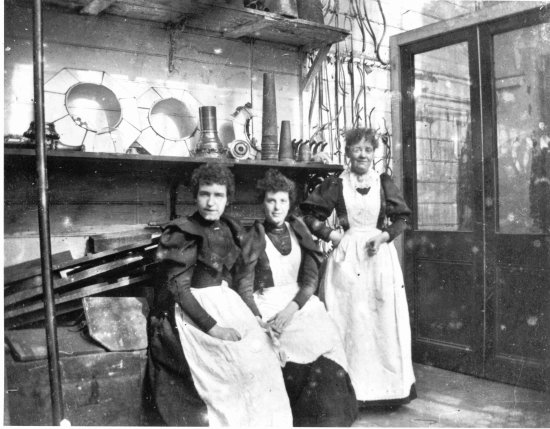
Men and Women of the Sugg Workforce surrounded by products
probably photographed with a pin-hole camera by a colleague about 1880.
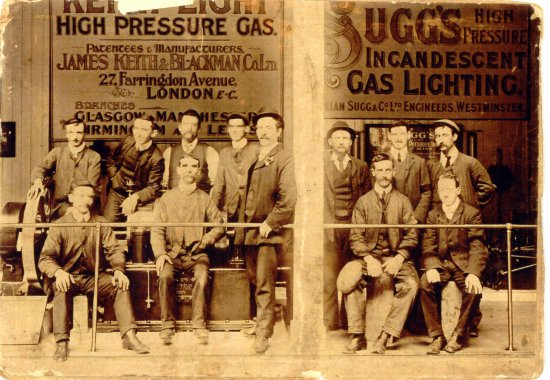
Irish gas workers in Dublin in front of contemporary advertisements.
Picture provided by Noel William Sugg, another of my great grandsons – born in the same year as Christopher. The Irish branch of the Sugg family started when my son, Jack, by my first wife decided to leave London for Dublin to take up a managerial post with the then Dublin Alliance and Consumer Gas Company where he worked until he retired. Jack, whose full names were Walter John had 11 children several of whom became officers in the merchant navy and one, Walter Reginald was the advertising manager with the Dublin Evening Mail for nearly 40 years.
Business was hugely exciting, we were now truly famous for quality and attention to detail of all my products. Typical of a third party comment came from Charles Dickens, Jr in his ‘Dictionary of London’
Victorian London – Directories – Dickens’s Dictionary of London, by Charles Dickens, Jr., 1879 – “Illuminations”
GAS BURNERS.—The argand and fishtail burners, made by Sugg, of Westminster, and supplied by all respectable gasfitters, are unquestionably the best. It is often supposed that if a good fishtail or flat flame burner is employed, it burns equally well whatever shape of globe be used; this is not the case, the best form of globe is spherical, with a large opening, say 3 ¼ in. at the bottom, and 3 ½ in. at the top. Melon or pine shaped globes are bad, saucer shaped are still worse. For reception and bedrooms the opal Christiania shade or globe, with a No: 4 or 5 flat flame steatite burner, gives the best and most agreeable result with the least consumption of gas. The Bronner burner is economical, but must not he used in places exposed to much draught. For basement offices the No. 4 flat flame burner will answer every purpose. The constant complaint of consumers about the “bad gas” either means that the supply of gas is deficient or that it is improperly consumed: with deficient supply it must rest either with the gas company, whose service pipe may be stopped, or with the consumer, whose fittings may be choked up or too small: in the case of bad burners the remedy is an easy one. The comparison on the same chandelier of a No. 5 flat flame burner with 7 ½ .in. Christiania shade, will at once show whether the old burners and globes are or are not of the right kind. And when a good, burner and globe are obtained it is necessary to keep them free from dust, by using a soft duster for the former, and by washing the latter twice a week. It should always be remembered that what the consumer wants and pays for is so much light rather than so many cubic feet of gas. And while the quality of the gas supplied in London does not appreciably vary, it is only by using the best burners, fitted in the best and most intelligent manner that satisfactory results can be obtained.
Charles Dickens (Jr.), Dickens’s Dictionary of London, 1879
Section 3
The formation of the Limited Company and its growth up until the death of WTS in 1907.
The Formation of William Sugg & Co. Ltd 1881
It became clear that to continue at this level of enterprise the business would require more capital to expand. We had connections all over the Empire and in the New World and, as sole proprietor I had to hold the whole thing together. Of course I had good and faithful staff but it became clear that there was only one course and that I would have to give up the proprietorship of my Company and the expansion would have to be funded by selling shares and converting to a Limited Liability Company. Obviously I had considerable misgivings about this step but I was getting no younger and was persuaded that this would ensure the future of the name and the resulting new Company to be known as “William Sugg & Co Ltd.”
The Prospectus for the sale of the business reads as follows:
WILLIAM SUGG & COMPANY
LIMITED
VINCENT WORKS, Vincent Street, Westminster; GRAND HOTEL BUILDINGS Charing Cross, SW
and RUE DES PYRAMIDES, Avenue de l’Opera, Paris
Engineers, and Manufacturers of Apparatus for Lighting, Heating and Cooking by Gas
Mr William Sugg’s business with its Goodwill, Stock-in-Trade, Plant and Machinery, Leases of Premises, and Patents, have been valued by Mr R.P. Spice, CE., at £80,000. The Directors have arranged that the Vendor shall transfer the same to the Company for £40,000 in Cash , and half the net profits after £7 per cent. has been paid to the Shareholders. The other half of the net profits being paid to the shareholders in addition to the said £7 per cent.
It is intended to apply to the Committee of the Stock Exchange for a quotation
———————————-
CAPITAL £150,000, IN 15,000 SHARES OF £10 EACH
———————————-
FIRST ISSUE OF 10,000 SHARES
THESE 10,000 SHARES ARE NOW OFFERED TO THE PUBLIC AT PAR, PAYABLE AS FOLLOWS: –
£0 10 0 – – On Application
£0 10 0 – – On Allotment
£1 0 0 – – In one month after Allotment
The remainder in Calls, not to exceed £2 each Call, with intervals of three months between each Call. It is not anticipated that more than £6 per Share will be required.
———————————-
DIRECTORS.
CAPTAIN GIFFARD, Chairman, Director of The Gaslight and Coke Company,
53, St George’s Square, SW
HY.LAWRENCE HAMMACK, Esq., CC., Director of the Commercial Gas Company,
59, Bishopgate Street, EC
N.E.B. GAREY, Esq., Director of The Continental Union Gas Company and the Cie L’Union des Gaz, 60, Anerley Park, SE.
S.E. ILLINGWORTH, Esq., J.P., 9, Norfolk Crescent, W., and Borough Court, Winchfield.
R.H.JONES., J.P., F.S.S., Vice-President of The Gas Insitute, The Briars,
Sydenham, S.E.
MANAGING DIRECTOR and ENGINEER
WILLIAM SUGG, Esq., A.I.C.E.
BANKERS.
THE BANK OF ENGLAND, BURLINGTON GARDENS.
AUDITORS.
To be elected by the Shareholders at the General Meeting
SOLICITORS.
Messrs. ARGLES & ARGLES, 85, Gracechurch Street, and at No. 10, Rue Louis le Grand Avenue de l’Opera, Paris.
TEMPORARY OFFICES.
85, GRACECHURCH STREET, EC., AND
1, GRAND HOTEL BUILDINGS, CHARING CROSS, S.W.
——————————–
The object of this Company is to take over, and, by largely extending the important works of Mr. Sugg, to furnish the public with the best means and appliances for burning gas, not only for lighting, but for heating, and cooking purposes, for which the demand is much on the increase.
The well-known business of Mr. Sugg has been established since the year 1838. From that time to the present it has continued to grow until it is becoming inconveniently large for the resources of the present owner, and sufficiently extensive to justify its conversion into a Joint Stock Company. Its customers are to be found in every Country to which the use of Gas has been extended, and agencies are established in most of the principal cities of the world.
The Directors are largely interested in the prosperity of Gas undertakings, and possess a knowledge of the wants of the present time in that respect.
A contract has therefore been entered into on behalf of the Company, for the purchase of Mr. Sugg’s business, both in England and France, as a going concern, together with the Patents of his several Inventions, the Leases of the Premises, the Plant and Machinery, and the Stock-in-Trade, for the sum of £40,000, and half the net profits after £7 per cent. has been paid to the Shareholders.
(Inflation charts indicate that this figure in 1881 equates to £4m in 2012.)
The amount of the purchase-money has been based upon a valuation made by Mr. Robert Paulson Spice, M.I.C.E., of Parliament Street, Westminster, the particulars of which are stated in his Report, a copy of which accompanies this Prospectus.
The net profit will, therefore, be divided as follows:-
First. — Set aside £1,000 per annum as a Reserve Fund.
Second. — 7 per cent. per annum amongst the Shareholders.
Third. — Any surplus of the net profits over 7 per cent to be equally divided for 21 years between Mr. Sugg and the Shareholders; after 21 years the whole to go to the Shareholders.
(The original document then goes on to mention medals won by Mr Sugg at various exhibitions all over the world and then an interesting paragraph as follows:)
The most recent demonstration of the value of his arrangements for street lighting, is in Parliament street, Westminster, extending from the foot of Bridge Street to and including Trafalgar Square; this may be referred to as the best lighted street and square in London, the latter having been carried out by order of H.M.Office of Works.
Mr Sugg’s inventions are patented in England , and some in France and Belgium. All these patents will become the property of the Company. The latest inventions are only provisionally registered at present.
Page 3 of the prospectus carries the valuation of the Company by Mr Spice. It starts by illustrating the steady development of the Company by the returns for the last 10 years as follows:-
| 1871 | £16,102 16 11 |
| 1872 | £18,492 5 6 |
| 1873 | £21,104 13 8 |
| 1874 | £23,658 10 2 |
| 1875 | £26,430 11 2 |
| 1876 | £26,314 1 7 |
| 1877 | £32,344 9 9 |
| 1878 | £31,189 10 1 |
| 1879 | £41,610 12 0 |
| 1880 | £50,913 8 4 |
Mr Spice continues:-The profits for 1879 and 1880 appear in Mr Sugg’s accounts, which have been well kept , as £7,267 and £7,382 respectively; which is £3000 more than is required to pay 7 per cent. on the amount proposed to be called up, and the capabilities of the undertaking are far from being fully developed.
(One might wonder why the ‘profits’ in the last 2 years have only increased by a little over £100 whilst the ‘returns’ have increased by nearly £10,000?)
In valuing the entire undertaking as a going concern, and dealing with the results realised , I am of opinion, that , for the goodwill, plant, machinery, and tools, leases of all the premises in London and Paris, the stock-in-trade, and the several Patents awarded to Mr. Sugg for his inventions, the sum of £80,000 is a fair price.
The following are the details of the valuation:-
The Patents, which are 30 in number, some of them being of great value £25,000
Goodwill £20,000
Stock-in-trade, at a discount from net cost £20,000
The Leases of the several Premises in Vincent Street, Grand Hotel
Buildings, and in Paris. £10,000
And Plant, Machinery and Working Tools of all kinds £5,000
£80,000
He finishes by saying that he appends a certificate verifying the profits for the last two years “and I have only to observe that these profits would have been greater but for the application of revenue to capital purposes.”
—————————————–
—————————————–
An agreement was drawn up and signed on 29th June 1881 between me, William Sugg on the one hand and James Combs Giffard, Henry Laurence Hammack, Napoleon Edward Byron Garey, Stonhewer Edward Illingworth and Robert Hesketh Jones as Trustees for a Company on the other hand, whereby it was agreed that:-
“The said William Sugg should sell, and the Company, or the said Trustees on its behalf, should purchase, the Letters patent , business, hereditaments and other property therein specified for the considerations and on the terms therein contained.”
The following day, 30th June 1881, the first ‘Subscribers’ – or shareholders as they would eventually become known drew up the following document:
(Transcribed from the original to simplify reading. Question marks indicate difficulty in transcription!)
We the several persons whose names and addresses are subscribed, are desirous of being formed into a Company in pursuance of this Memorandum of Association, and we respectively agree to take the number of Shares in the Capital of the Company set opposite our respective names.
| Names, Addresses and Description of Subscribers | Number of Shares Taken by each Subscriber |
|---|---|
| William Sugg Vincent Works, Vincent Street, Westminster, Gas Engineer | One thousand |
| Henry Lawrence Hammack, 59, Bishopsgate, City of London. Architect | One Share |
| Napoleon Edward Byron Garey 60, Anerley Park, Surrey No occupation | One hundred |
| Alfred Hersee 1, ?everley Road, South Penge Park, Surrey Gentleman | One Share |
| Robert Paulson Spice? 21, Parliament Street, Westminster Civil Engineer | Fifty Shares |
| David William Sugg, Vincent Works, Vincent Street, Westminster Gas Engineer | Fifty shares |
| William Stevens Brown 122 Benerley Rd, Wandsworth Common, Surrey Accountant | Five shares |
| Richard Peison? 112, Charham? Road, Wandsworth Common, Surrey Gas Engineer | Five Shares |
| John Coppen Ashford House, Ashford, Middlesex Gentleman | One hundred |
Dated this 30th day of June 1881(Total 1312 shares of £10 each)
Witness to the above signatures
Ernest S Coulson, Solicitor
And clerk to Messrs Argles & Argles
Solicitors, 85, Gracechurch Street, London
So the Company was sold – or that is how it felt to me! Shares were registered in the Register of Members from June 30th 1881.
As you can see from the subscribers list I was the major shareholder and all that time spent building the business was suddenly translated into wealth! Of course this was not relevant to me – money was never the top of my priorities except in so far as it allowed me to invest in the development of my – the – Company. My new position was Managing Director, a position I retained for a further 26 years!
(Share No.1 was never sold and still exists along with the share certificate printing plate which is beautifully engraved in copper.) C.S.
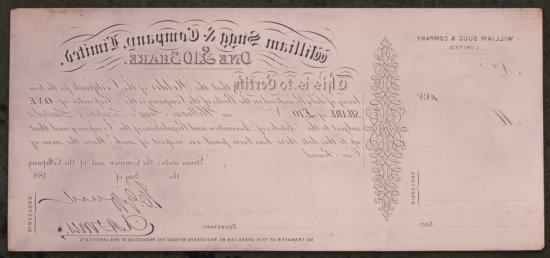

The following document was produced as part of what we would now certainly call the ‘due diligence’ information for valuing the business of Mr William Sugg. Entitled ‘The First Schedule’ it would have been considered particularly important because the value of a Company was largely in its ‘rights’ which in this case means the Patents taken out by William Sugg over a period of 13 years.
This copy is taken from a poor photocopy in which occasional numbers are not clear. These have been marked with a question mark.
The First Schedule
Mr William Sugg’s Patents
| No. of Patent | Date | Description | Expire |
|---|---|---|---|
| 438 | February 8, 1868 | Second Filling Vase | 1882 |
| 3133 | October 13, 1868 | Second Lamp Governor Patent | 1882 |
| 831 | March 8, 1869 | London Burner | 1883 |
| 2844 | October 24, 1871 | Railway Valve Mercury Swivel | 1885 |
| 2841 | September 26, 1872 | Third Lamp Governor Patent | 1886 |
| 1584 | My 5, 1874 | Christiania Regulator | 1888 |
| 4227 | December 9, 1874 | Improvements in London Burners and Circular Slit Hollow Top | 1888 |
| 3 834? | September 24, 1875 | Illuminating Power Meter (English and French) | 1889 |
| 970 | March 6, 1876 | Casting Burners etc | 1890 |
| 971 | March 6, 1876 | Street Lamp Meters | 1890 |
| 3153 | August 9, 1878 | Gas Regulators Metal Discs | 1892 |
| 2007 | May 20, 1879 | Self Ventilating Light | 1893 |
| 3826 | September 23, 1879 | Coupling for Gas, Air or Water Pipes | 1893 |
| 5267 | December 24, 1879 | Westminster and “City of London” Lamps | 1893 |
| 282 | January 22, 1880 | Combination of Flat Flame Burners | 1894 |
| 1545 | April 15, 1880 | Table Top Burner and Lantern with Inlet at ? (bottom?) | 1894 |
| 1854? | May 6, 1880 | Steatite Float Governor | 1894 |
| 2065 | May 21, 1880 | Railway Carriage Lamps | 1894 |
| 2255 | June 2, 1880 | Gas Manufacturing from and enriching by Petroleum | 1894 |
| 1528 | April 17, 1881 Provisional Protection | Improvement in the mode and means for uniting Gas, Water and other Pipes or Tubes | 1881 |
| 4365 | October 26, 1880 Provisional. Protection | Improvements in the construction of Domestic Baths | |
| 1059 | March 11, 1881 | Improvements in the construction of Gas Lamps or Lanterns | |
| 2605 | June 15, 1881 | Sunlights | |
| ? | June 16, 1881 | Gas Stoves | |
| FRANCE | |||
| 1372 06? | June 11, 1880 | Illuminating Gas | |
| BELGIUM | |||
| 52278b? | August 12, 1880 | Enriching Gas (based on the French Patent dated 11/6/80 but drawings and description modified | |
| UNITED STATES OF AMERICA | |||
| A patent in course of being taken out for the Steatite Lamp Governor | |||
(The following details are copied from an undated document promoting the Company and could possibly also have been part of the due diligence at the time of the sale or flotation in 1881. It could equally be from a later date but it is important as it describes the various ‘shops’ and the tasks and products they produce. CS)
Brief Particulars
OF THE WORK CARRIED ON
IN THE COMPANY’S PREMISES
AT WESTMINSTER
| WORKSHOP | CLASS OF WORK |
|---|---|
| Brass Shop | Gas Burners: Electric, Gas, Steam and Water Fittings; Stampings: Spinnings; Engraving; Chasing and Ornamental Brass Work of every description. Gold, Silver and Nickel Plating; Polishing, Japanning, Enamelling, etc. |
| Brass Foundry | Castings in brass, Gun-metal, White-metal, etc. Art Works in Bronze |
| Engineers’ Shop | Pumps; Gas and Air Compressors. Fans and exhausters. Standard Gasholders; Station Governors. Steam Traps, Rack and Reducing Valves. |
| Iron Foundry | Columns; Special Pipes and Connections. Light Castings of all kinds |
| Metal-Plate Shop | Ventilators for both mechanical and natural draught. Ship Ventilators. Sun-burners and other Ventilating Gaslights. High-power Lamps for Gas and Electric Lighting. Asbestos-lined and Butt-jointed Shafting |
| Photometer Shop | Photometers and all Standard Instruments for the measurement and testing of gas. Apparatus for Physical and Chemical Laboratories |
| Stove Shop | Steam, Gas, Coal and Coke Cooking Apparatus. Radiators, Heaters, Steam and Hot Water Boilers. Gas Fires |
| Smithy | Ornamental Gates, Railings, Brackets and wrought Iron work in any style. Angle-iron Framework. General Forgings and Smiths’ work |
| Wood workers’ Shop | Pattern Making. Wood Turning and Joinery. Polishing and Staining |
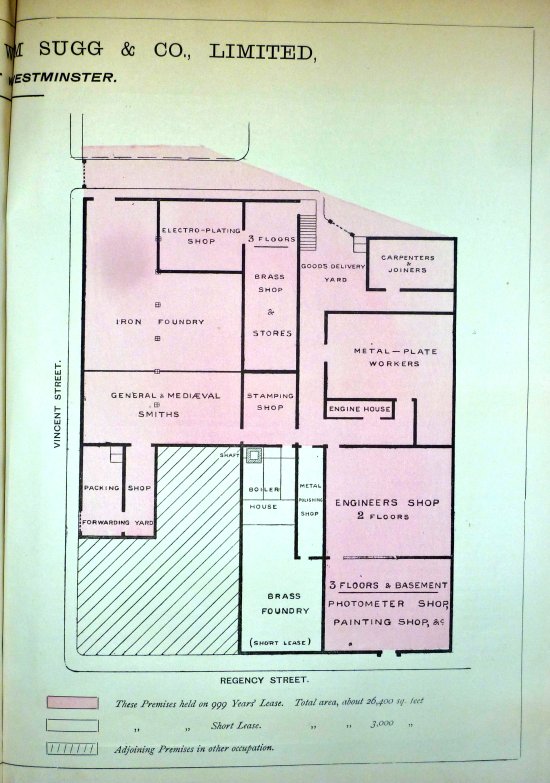
At the bottom of the drawing it states:
These premises held on 999 Years’ Lease. Total area about 26,100 sq ft.
Ditto on Short Lease. Total area about 3000 sq ft.
Adjoining Premises in other occupation.
(I believe the adjoining premise to the left was a pub although without the exact date of this document it could still be houses!)
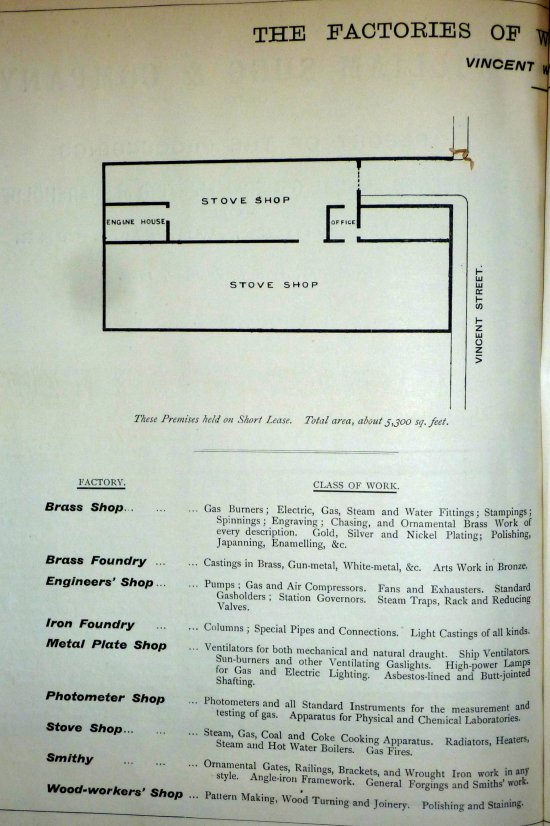
INTERNATIONAL GAS & ELECTRIC EXHIBITION,
CRYSTAL PALACE, 1883.
Even before the event there was much controversy stirred up by ‘a rival firm’ who considered that William Sugg had been ‘unduly favoured’ as can be seen in this cutting.
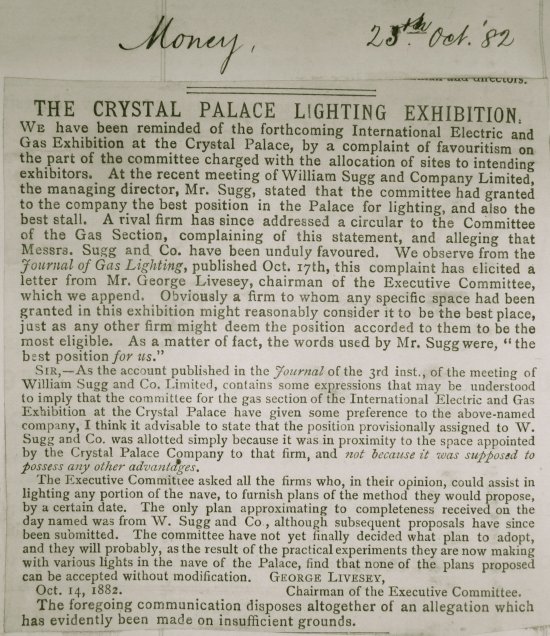
The following incredible 4 page promotional leaflet lists the vast range of equipment shown at the Gas & Electric Exhibition at the Crystal Palace in 1883 – not only on the stand but, significantly, all over the site including externally!
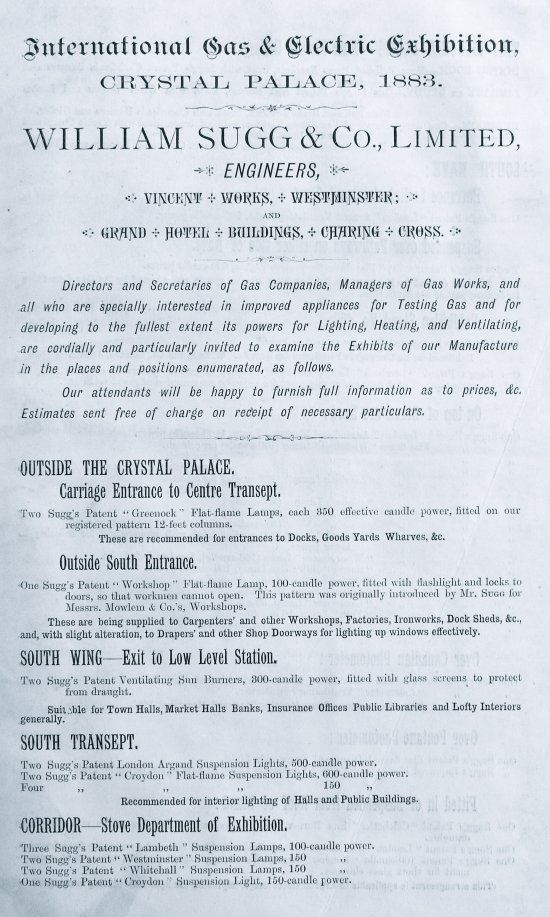
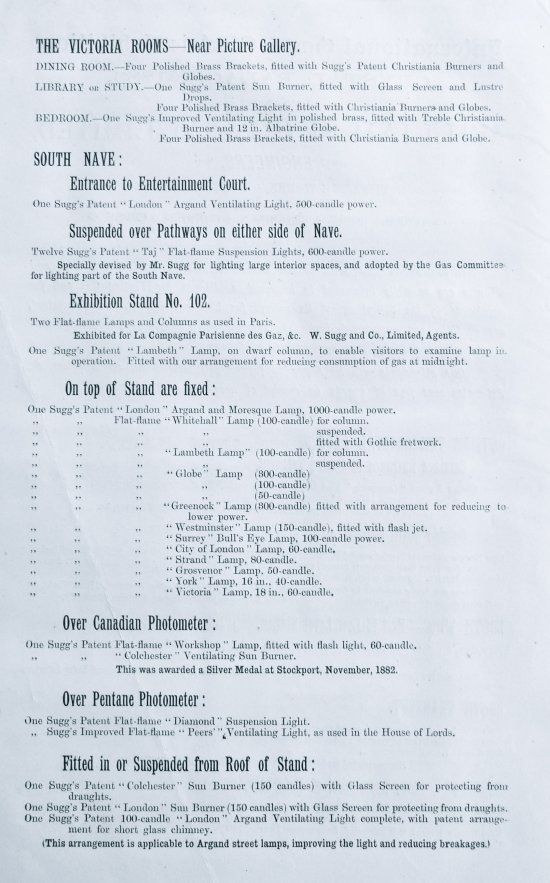
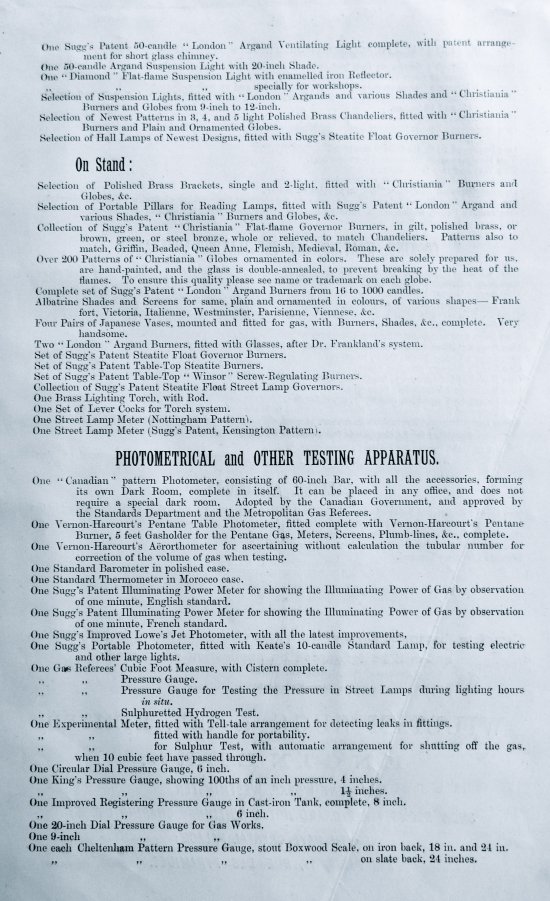
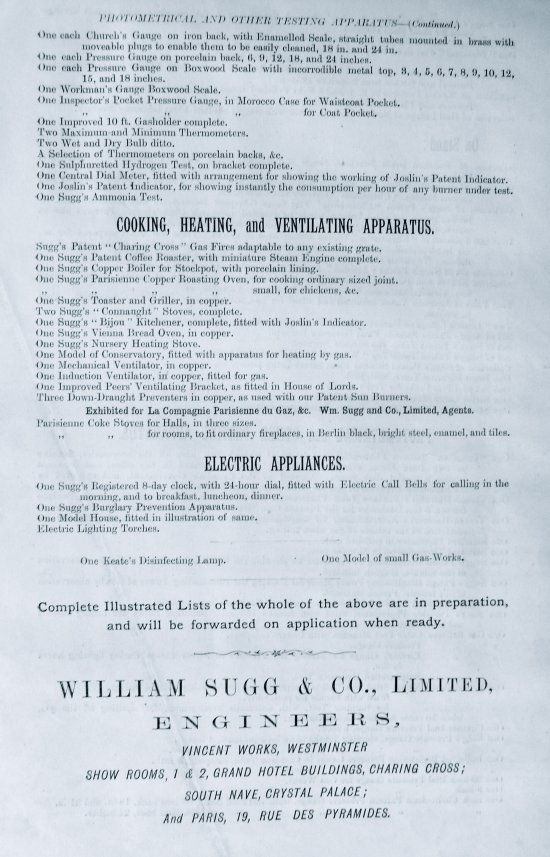
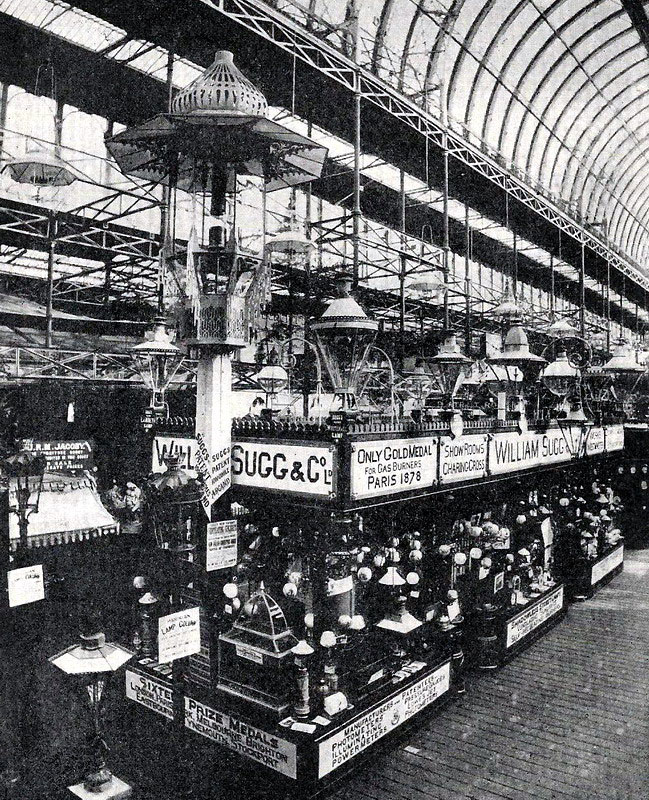
This picture is captioned with the date 1887 and clearly shows the huge array of products offered by William Sugg.
The British Library entry on the Crystal Palace and the Exhibitions states:
A mammoth iron structure covered with over a million feet of glass, the Crystal Palace was originally erected in Hyde Park for the Great Exhibition of 1851. With the exhibition over, the entire edifice was moved piecemeal to south London and re-erected. It opened in its new home on 10 June 1854, and was perhaps the world’s first theme park. Flower shows, animal exhibitions, photographic displays, musical concerts and military tournaments were all shown here – singly or together.
Between 1854 and 1884, the Crystal Palace had almost two million visitors a year, necessitating the construction of a railway line and station nearby. Every Thursday evening until 1935 was marked at Crystal Palace by a spectacular fireworks display from the local firm, Brock’s Fireworks. The Palace was destroyed by fire in 1936.
THE ENLARGEMENT OF VINCENT WORKS.
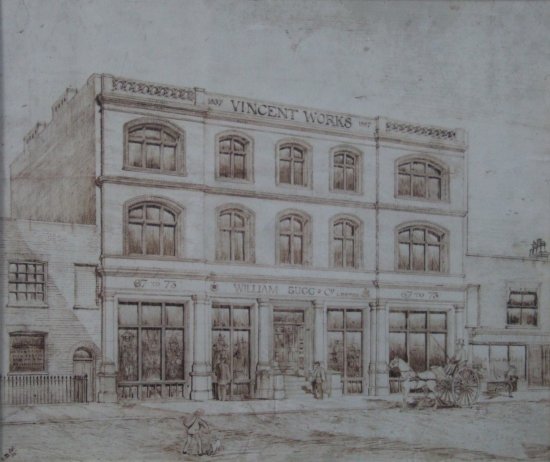
This wonderful pen & ink drawing of the newly enlarged Vincent Works was, I was always told, drawn by Berthe Francine Sugg, one of William’s daughters who was without doubt a talented artist. However It is dated 1887 and carries the initials BW. As Berthe was born in 1878 this would mean that she was only 9 years old when she made this drawing – a prodigy perhaps? The close-up below shows the detail of the front entrance with the postman arriving at the steps.
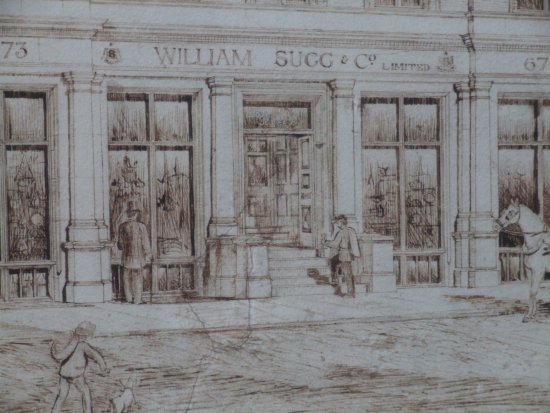
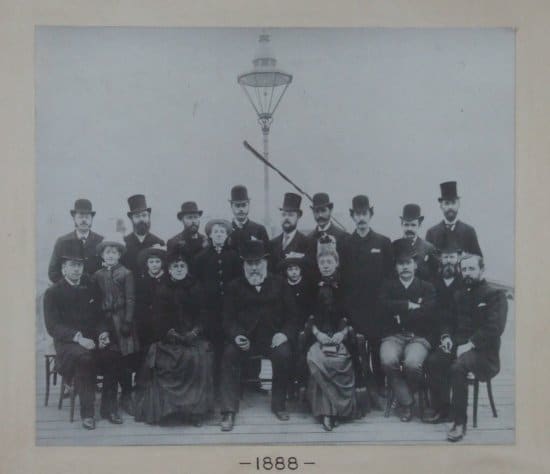
This photograph was taken on the roof of the newly re-built Vincent Works to mark the jubilee of the House in 1887. There are no less than 11 members of the family in this picture with a number of senior staff, as follows:
Back Row from the left:
Walter Stanley Sugg-Wright, Unknown, Unknown, Edwin Henry Sugg-Wright, Mr Barrett? Mr Ives, F.W.Abbott, H.Gray, H.J.Waller.
Remainder seated and standing from the left:
John Walter Sugg, Miss May Alberta Sugg, Miss Marguerite Eugenie Sugg, Mrs William (Marie Jenny) Sugg, Miss Marie Rose Sugg, William Sugg, Miss Berthe Francine Sugg, Mrs D.W.Sugg, David William Sugg, Unknown, W.S.Brown.
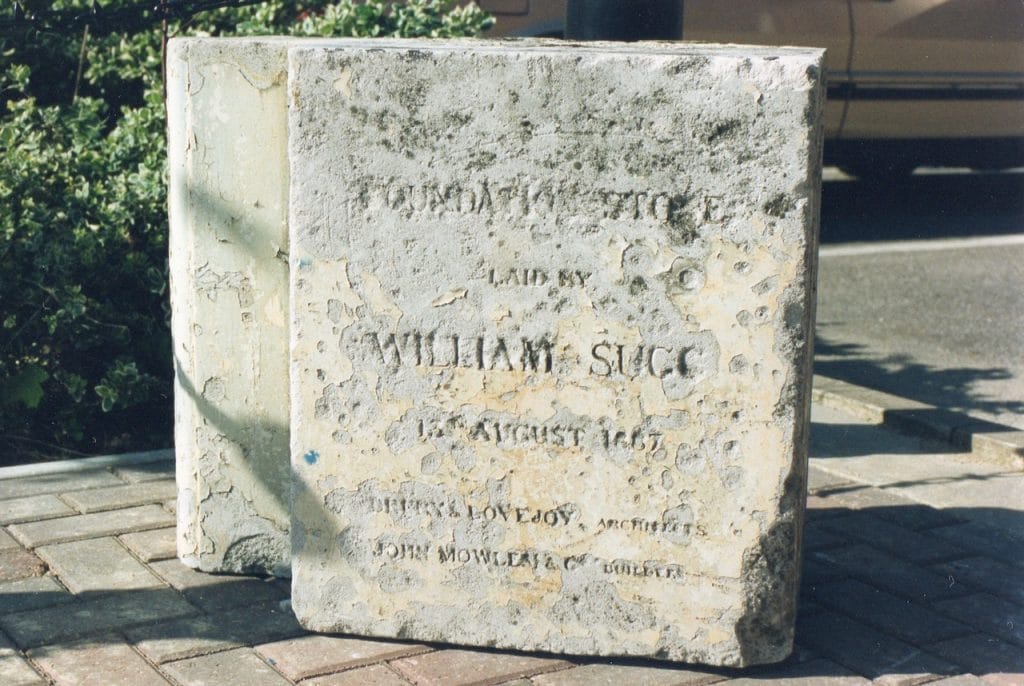
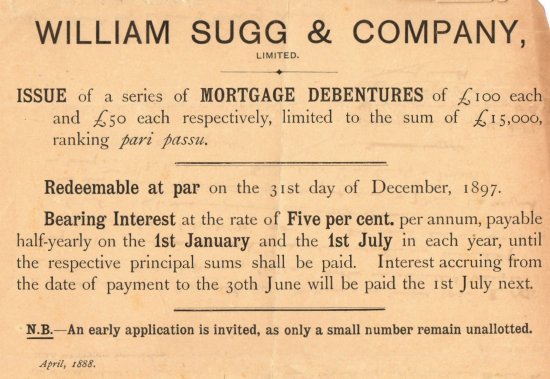
It is clear from this advertisement for debenture holders in April 1888 that, despite the flotation of the Company, the expansion of Vincent Works has still left the Company short of working capital.
Jack the Ripper!
As a reminder of the world and more especially the London of William Sugg in the 1880’s, many readers will know the name of ‘Jack the Ripper’ whose name struck fear into the minds of the population following several murders in the streets of London in the mid 1880’s and who was never brought to book.
In 2011 I was approached by one of a group of enthusiasts who have spent many years trying to uncover the true identity of this murderer. He had come across a document related to the case which included the signature of William Sugg and also his initials, against a list of names related to the case. (See below) It seems that there was a one Francis Tumblety who was under suspicion for these crimes and William Sugg was foreman of a Grand Jury in November 1888 which returned a “True Bill” verdict which paved the way for the suspect to be prosecuted at the Old Bailey on December 12th 1888.
Unfortunately it seems that Tumblety jumped bail and fled the country before the trial and thus he was never prosecuted and the ‘enthusiasts’ have been trying to prove the identity of Jack the Ripper ever since! C.S.

![Grand-Jury[3]](https://williamsugghistory.co.uk/wp-content/uploads/2014/04/Grand-Jury3.jpg)
In 2015 I was sent the document above that shows WT Sugg as the first name on the sworn Grand Jury list. David Orsam who found this document at the National Archive tells me the reference is CRIM 6/17.
Six years later, in June 2021 I received another communication from ‘David Orsam’ which he explained was his user name on an online message board. He had been reviewing some of his photographs of documents in the National Archives when he spotted another William Sugg signature on a petition, or memorial, presented to the Metropolitan Police on 22 October 1887 asking for action to be taken to prevent unruly meetings in Trafalgar Square!
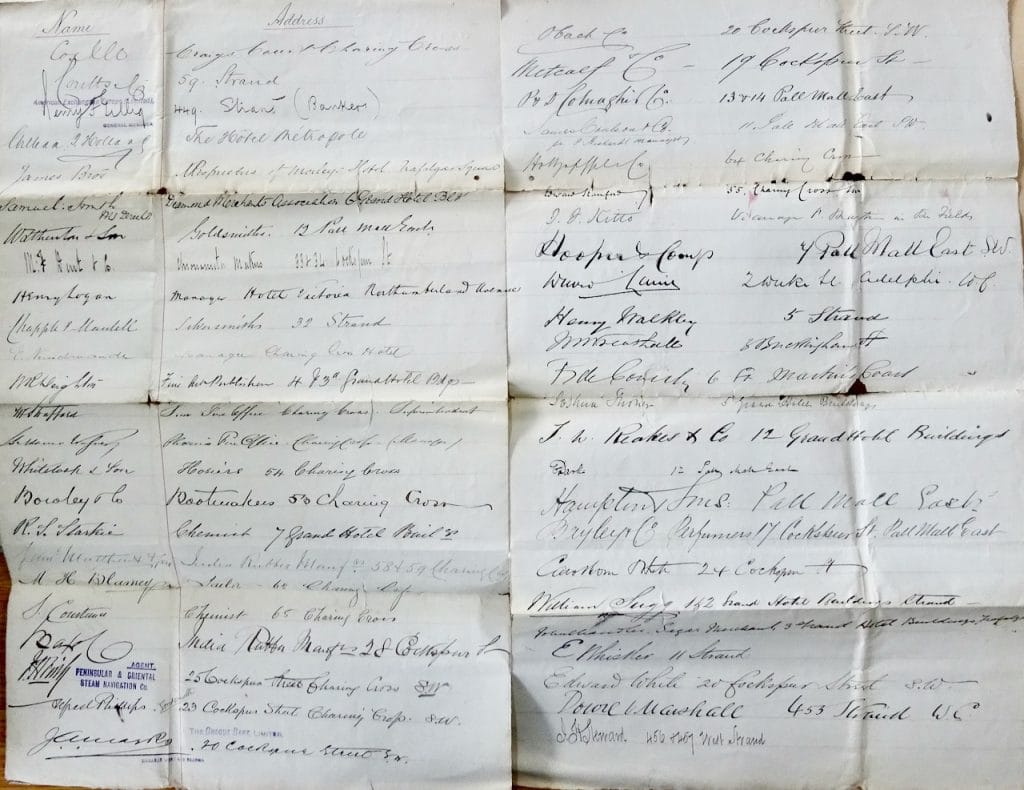
When I asked if there had been any result from the petition, David kindly responded as follows:
On 8 November 1887, the Commissioner of the Metropolitan Police (to whom the petition was addressed) issued a proclamation that no public meetings would be allowed to assemble in Trafalgar Square until further notice, so, on that basis, you could say that the petition was successful. At the same time, I don’t suppose it was the petition alone that led to the proclamation because the issue of meetings at Trafalgar Square was a huge one at the time, with debates on the subject in the press and parliament. But I would have thought your great grandfather would have been pleased by the outcome (although the socialists initially defied the ban which led to a violent confrontation in the Square known as “Bloody Sunday” on 13 November 1887, but, if his showroom was closed that day, it would have been okay!).
The National Archives reference to the file in which this document can be found is MEPO 2/182
SECTION ON W.T.S. WRITINGS.
Having spent the larger part of my working life investigating, experimenting and considering so many aspects of gas and its utilisation I always felt it important to give lectures and to follow these up by publishing the text to ensure that everybody in the Industry had the opportunity of following all of the developments. In addition I have written a number of modest books putting together much of the information in a more general form for the edification of a wider public and as a means of promoting the products. My wife, who is the daughter of a chef, also wrote an excellent cookery book on and entitled ‘The Art of Cooking by Gas’ which is liberally illustrated with suitable cooking appliances all of which we have used personally. (See the introduction to Cooking with several comments on Jenny’s book) CS
This review from the Gas press of ‘The Domestic Uses of Coal Gas’ gives you some idea of how one was received.
Journal of Gas Lighting, Water Supply, & Sanitary Improvement.
Dec 9th 1884
Review of: “The Domestic Uses of Coal Gas, as applied to Lighting, Cooking and Heating, and Ventilation” by William T Sugg, Assoc Inst C.E., M.R.I., Hon Member of The Gas Institute. London: Walter King 1884
Gas & its Uses
“Nobody can deny that Mr Sugg is a walking encyclopaedia in relation to gas apparatus. He has devoted the greater part of his life to the improvement of this class of commodities and if it should be said that this is his business, it may also be pointed out that there is a distinction to be drawn between a mere manufacturer of common articles for sale at market prices, and a maker who tries to impart additional perfection to everything that passes through his hands.”
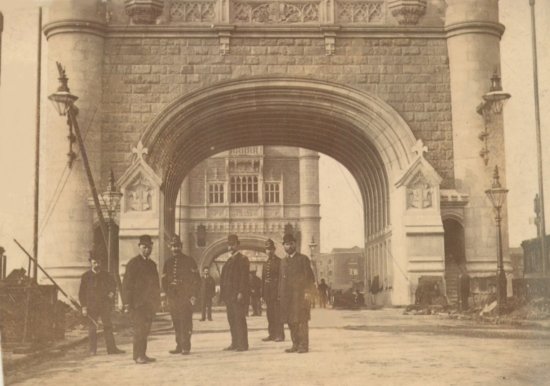
This wonderful picture was taken during the final stages of the building of Tower Bridge over the Thames in London in 1894, only a stones throw from the William Sugg factory in Westminster. The original is a tiny and therefore without doubt, an amateur, photograph on the back of which it states that the somewhat portly man with the bowler between the two policemen is the works foreman and the man on the left with the umbrella is the London representative!

This project was a huge one for the Company as indicated by the advertisement that was placed in Building News the day before the opening on 30th June 1894:
The text reads: Tower Bridge was lit “by means of upwards of 200 Sugg’s patent high-power flat-flame gas lamps. All the work of supplying and running gas and water mains and supplying and fixing lamps, ornamental lamp standards and columns, hydrants, tanks and hand pumps, wrought iron gates and railings has been carried out by William Sugg & Co.”
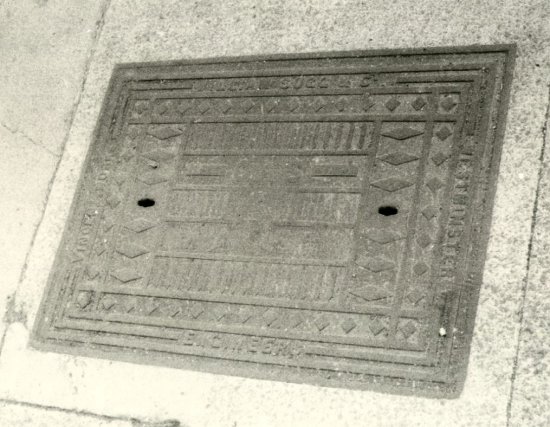
Even the personalised manhole covers were cast in the nearby Sugg foundry. This picture was taken late in the 20th century and shows a Sugg manhole cover still in place.
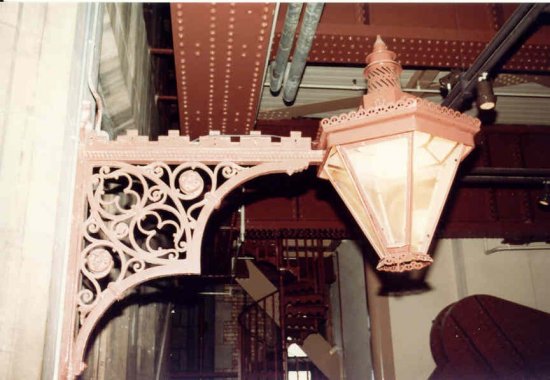
One remaining wall mounted fixture is preserved in the museum within the north tower as shown in this picture taken in 1983.
(Although there was insufficient time to visit the Tower on a trip in 2013 because the queue was up to 3 hours as it is now a major visitor centre, I was told by a guide that there was no longer a museum and the space has been converted to exhibition spaces and a gift shop! I was, however, invited to the launch of a new book celebrating the 125th anniversary of the opening of Tower Bridge in 2019. There I met several people including the Exhibition Development Manager from whom I learned that there are two original wall bracket lamps AND two post mounted original lamps.)
(Some 2013 photos have been added to ‘Location Pictures‘)
This fabulous project is the subject of a post being written at the 125th anniversary of the opening of the bridge in 2019.
Fire at Vincent Works
“SUGG’S BURNERS ALIGHT” (click to read cuttings.)
1st August 1896
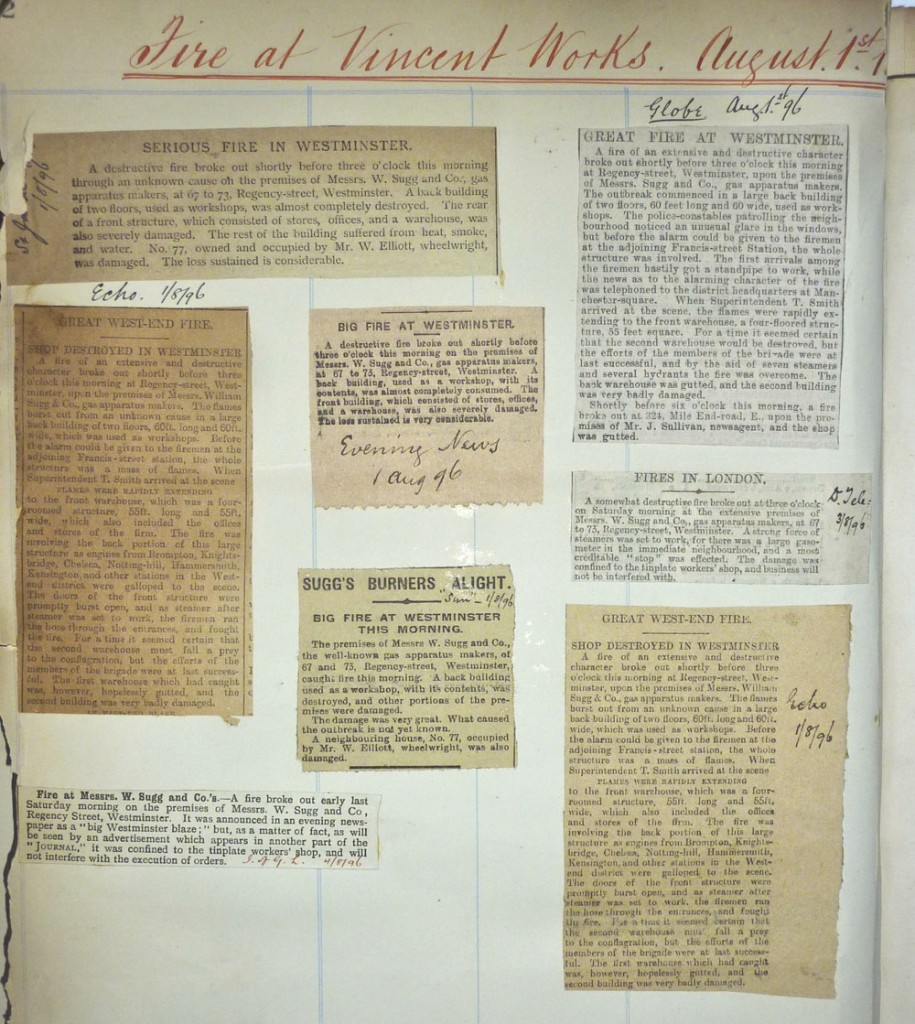
Note the description in the bottom right cutting of how the ‘engines from a list of stations were “galloped” to the scene’ and also ‘as steamer after steamer was set to work the firemen ran the hose through the entrances etc.’
Despite the fire, the following statement on the same day indicates that it did not interfere with the execution of orders
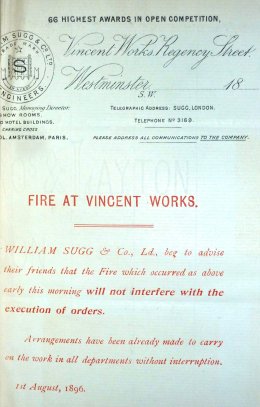
The 1900s headed paper looked like this
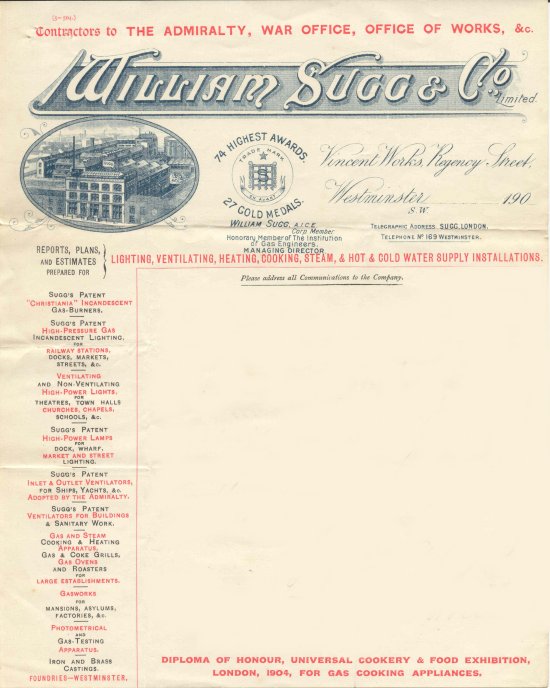
BUCKINGHAM PALACE LIGHTING 1901
The Centenary Booklet of 1937 described the order to light the exterior of Buckingham Palace in 1901 as a ‘Signal Honour’ and pointed out that these lamps “may still be seen in the same place today although the actual burners have of course been modernised from time to time.” That was in 1937 so it is even more remarkable that they are still in place in the 21st century as can be seen in the illustrations later.
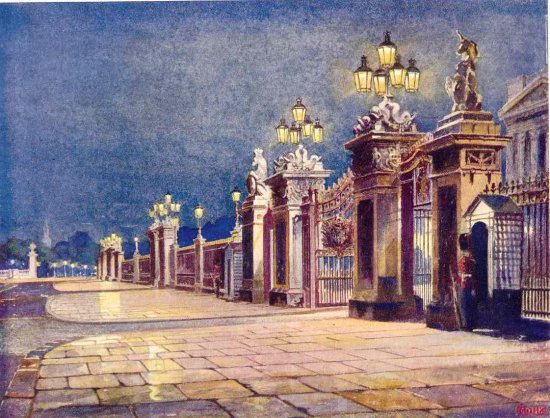
Water colour illustration by William Monk inspired by the photo below and used in a publication ‘Daylight by Night’ published by the British Commercial Gas Association Sept 1931
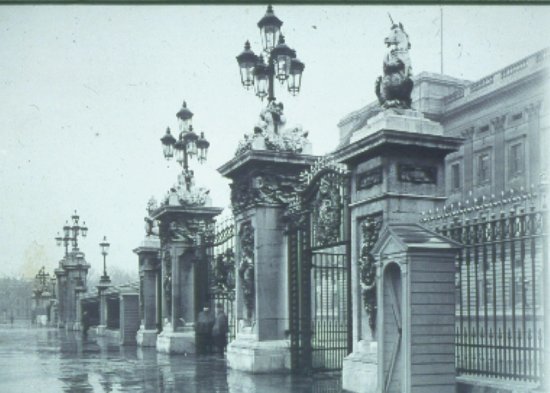
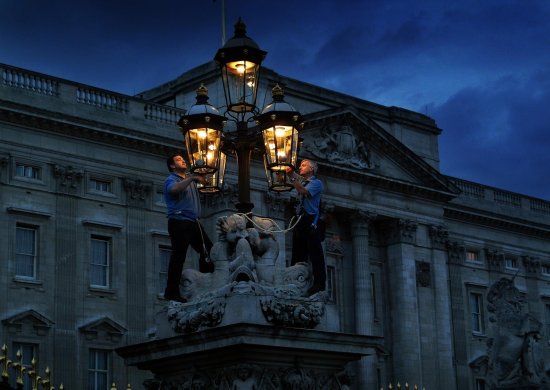
The Sugg Buckingham Palace Gas Lights are still in use as can be seen in this marvellous picture of the specialist maintenance provided by British Gas continuing in the 21st Century.
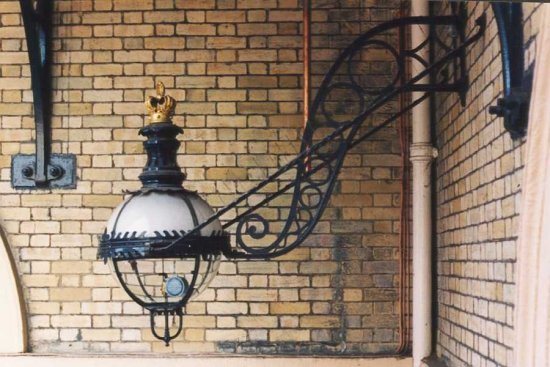
Not only are the original Sugg lamps still on the outside of the Palace and there are many post mounted fixtures in the gardens but this is one of several Sugg Globes in their original position in the inner courtyard. This particular one is mounted under the entrance canopy where there are also a number of suspended fixtures as shown below.
This Sugg lantern is one of several original Sugg gas lamps that still hang under the entrance canopy in the inner courtyard of Buckingham Palace
See also Location Pictures.
AND IN 1903 ON VENTILATING TORPEDO BOATS
(A new section on Updraught Ventilation has been added to the Sun Burner section.)
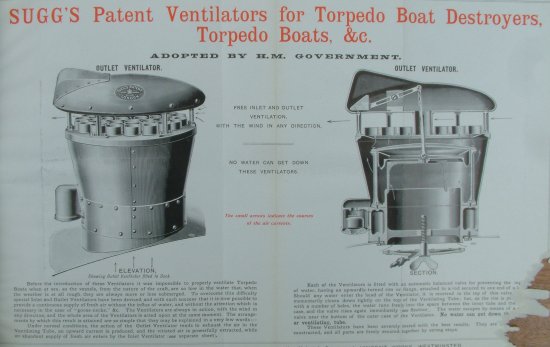
The text below the diagram says:
“Before the introduction of these Ventilators it was impossible to properly ventilate Torpedo Boats when at sea, as the vessels, from the nature of the craft, are so low in the water that, when the weather is at all rough, they are always more or less submerged. To overcome this difficulty special Inlet and Outlet Ventilators have been devised, and with such success that it is now possible to provide a continuous supply of fresh air without the influx of water, and without the attention which is necessary in the case of “goose-neck”, etc. The Ventilators are always in action, with the wind in any direction, and the whole area of the Ventilators is acted upon at the same moment. The arrangements by which this result is attained are so simple that they may be explained in a very few words:-
Under normal conditions, the action of the Outlet Ventilator tends to exhaust the air in the Ventilating Tube, an upward current is produced and the vitiated air is powerfully extracted, while an abundant supply of fresh air enters by the Inlet Ventilator (separate sheet)
Each of the Ventilators is fitted with an automatic balanced valve for preventing the ingress of water, having an upwardly-turned rim or flange, attached to a rod secured to one end of a lever. Should any water enter the head of the Ventilator, it is received in the top of this valve, which momentarily closes down tightly on the top of the ventilating Tube; but, as the rim is perforated with a number of holes, the water runs freely into the space between the inner tube and the case, and the valve rises again immediately (see section). The water escapes by means of a relief valve near the bottom of the outer case of the Ventilator. No water can get down the inner, or ventilating, tube
These Ventilators have been severely tested with the best results. They are substantially constructed, and all parts are firmly secured together by strong stays.”
The Inlet Ventilator is very similar except that the incoming air is fed in through a ring of holes in the underside of a top spun section reminiscent of a gas lamp. It has the same lever arrangement and the nice little float chamber which allows any water in the space between the inner tube and the case to drain out. I really like the final touch of the substantial wing nut and closure plate for manually closing off the whole device should this prove necessary!
1905 ARSON FIRE
Former employee, Joseph Inwood, made an arson attack on Sugg’s Westminster works
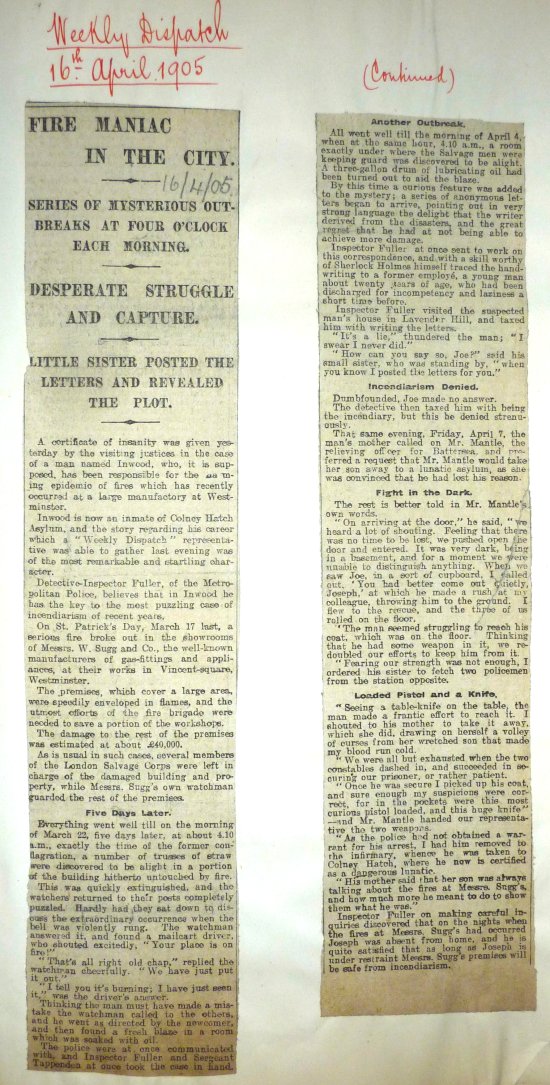
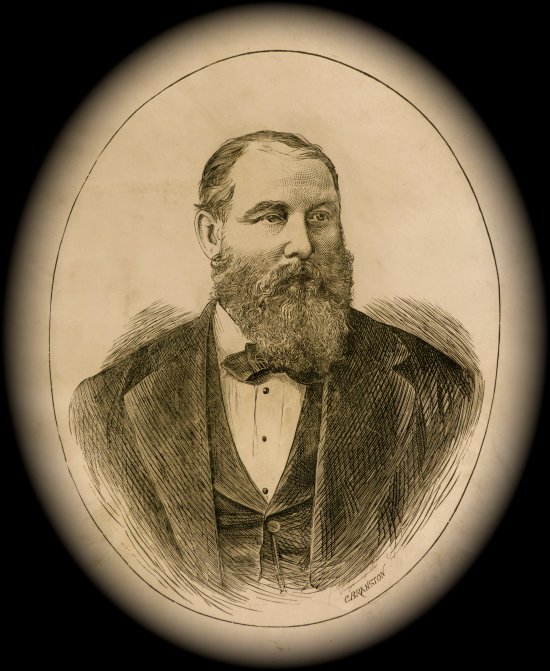
THE DEATH OF WILLIAM THOMAS SUGG 28th FEBRUARY 1907
Towards the end of my life I contracted a debilitating illness which prevented me from taking a full part in life. As you can see from the last letter that I wrote to the President of the Institution of Gas Engineers I was unable to walk any great distance for some considerable time. It did not stop me attending the office, however, until Tuesday 19th February 1907 after which I did not return.
——————————————-
William Thomas Sugg died at home in his bed at ‘Morningside’ just 9 days later on the 28th February 1907 in his 75th year.
June 26th 1906
Reprint of letter from W.T.S re his illness
“Dear Mr President, – I am very sorry that I have been prevented from coming to the meeting of the Institution of Gas Engineers, and that I shall not be able to come to the Conversazione. Since the Gas Exhibition (where I got cold upon cold), I have had a long illness, and the weather has been so generally bad and changeable that I cannot get myself quite right. The last cold weather gave me a bad cold, which I have not got rid of yet; and the weakness caused by this long illness has affected the nerves of the legs, so that I can only walk a very short distance. I am obliged to give up the idea of going with you to Boulogne to serve as one of your interpreters I am very sorry; but I wish you and all the members of the Institution a fine and happy day, and hope you will all enjoy yourselves.
I am dear Mr President, yours faithfully,
William Sugg
Obituaries
Born in Westminster – he always referred to with gratification; and his close connection with the ancient city was unbroken, for at the time of his death he was a Churchwarden of St.John’s.
His father established in 1838 a gas meter and fittings business in Marsham Street, and under him as an apprentice, and in the works of the South Metropolitan Gas Company, under the late Mr Thomas Livesey, he acquired a knowledge of the manufacture of gas and the construction of the appliances used in its distribution.
In 1858 he joined his father, and on the death of the latter in 1862 acquired the business.
He had previously turned his attention to the improvement of gas burners; and had made the first argand steatite-top burner.
He also made in1858 the first burner which might be considered as the standard burner used for the testing of gas in England.
1862 in conjunction with Dr Letheby an improved form of this burner, which became known as the Sugg-Letheby standard burner for 14 candle gas.
On Sept 5 1866 he took out what appears to have been his first patent for “an apparatus for regulating the supply of gas”.
In 1868 another patent was obtained for a similar purpose; and in the following year, one for “improvements in gas burners”.
Lots more!!
Ending__
Mr Sugg was twice married, and he leaves a widow and several sons and daughters. The funeral takes place at two o’clock today, at Streatham Cemetery, Garratt Lane, Tooting; the internment being preceded by a service at the church of the Ascension, Malwood Road, Balham, at one o’clock
ALSO in Gas World an even more personal tribute which will be recorded more fully but ends lyrically
“He was a man, take him for all in all, we shall not look upon his like again”
“Farewell! Good workman, genial soul, kind heart, open hand. Well hast thou earned thy rest. Thy remembrance will not perish with thee!”
Probably the last photograph of William Thomas Sugg with his wife, Jenny, surrounded by 10 of his children. Philip Henry who eventually became MD is 3rd from left standing.
For those who would like to know who is who in the picture above, these are the names by which they were known with their other name or names in brackets and their age at the time of this photo. Unfortunately we do not know for sure when this photo was taken, however my guess is not earlier than 1905. William died on 28th February 1907 and worked until 7 days before he died. As he said in his note to the Institution of Gas Engineers in the June before he died, recorded just before the obituaries above, that he was suffering from a long illness, my suspicion is that this picture was arranged probably by his much younger wife to bring as many of their family together for a last family photo.
From left to right standing: George (Allan) [30], May (Alberta) [30], Philip (Henry) [22], Berthe (Francine) [27], Anthony (Aincham) [23], (Jenny Lucy) Jane, [24], (Marie) Rose [31], Marguerite (Eugenie) [28]. Seated are (Marie) Jenny [55] with William (Thomas) [73]. Sitting on the ground on the left is Richard (Patrice) [17] and on the right Victor (Alexander) [18]. The only son missing is their eldest, William Francis known as Frank who would have been 32. They lost one son, Robert Pierre at 8 months. Naturally, if this photo was taken up to 18 months later, all the ages will be between one and two years older.
(100 years later, this website, in the inconceivable technology of the future, is dedicated to this man, William Thomas Sugg, whose remembrance did not perish with him and is designed to continue the remembrance, spreading it world wide for the interest and education of new generations for whom gas lighting is not even a vague memory. CS)
Section 4
20th Century growth of the Company, two world wars and finally the takeover.
I feel that now we have reached the year of his death in this record, it is no longer realistic to write from the perspective of William Sugg, whose life was so dedicated to the Company. Doubtless, if he is watching from somewhere unfathomable, he will have seen ‘his’ company grow and change and see products come and go over the subsequent century. Now it is up to me to continue to record what he would have seen for those of us looking back from the future.
————————————————–
Following the death of William Sugg he was succeeded by his nephew Mr Edwin Sugg-Wright who was appointed General Manager in 1907 and also Secretary in 1910.
Edwin was the son of Simeon Wright and Susannah Amelia Sugg, William Thomas’s elder sister, so it was ‘keeping it in the family’. At the end of 1910 he relinquished his office as General Manager and Secretary and was appointed Managing Director, a position which, unfortunately, he held for only seven months, before his death. He was succeeded by the senior board director, Mr S.E.Thornton, who retained this position until 1920 when he retired in favour of Mr Philip H. Sugg, a son of William Sugg.
What is not clear behind the bald facts is the part played by William Sugg’s wife, Jenny. As mentioned previously Jenny was half William’s age when they married which amounted to 19 years younger, thus she was only 56 when he died and still had several of their children at home. Despite the obvious disparity in their ages it would seem that William paid little attention to his personal finances and, in modern jargon, although he owned a large proportion of the shares in the Company, he was property rich and cash poor. It seems that he left his wife very much in the dark as she soon discovered that she did not have sufficient funds for every day living! What was worse it seems that many years before, William had borrowed quite heavily from a relation and had never paid this loan back, seemingly claiming that he did not owe this money. After his death the Company received a claim for the outstanding amount and the Board of the now Limited Company simply passed it on to Jenny.
Jenny Sugg was now of course the major shareholder of the Company and insisted on attending the board meetings. She was clearly a woman of some determination as she told the directors that she would not let her husbands name be dragged down by a financial situation and that she would find a way to pay off the debt. In those days the Company banked with The Bank of England but when she approached the bank they politely advised her that they never made personal loans. At some loss as to what to do she was advised to try her local bank which was Lloyds where she received a very different welcome and an immediate loan based on the enormous value of her shareholding, allowing her to clear the debt and provide funds for her family living. In due course Lloyds became the Company banker, remaining as such until the Company was finally taken over in 1969.
In her powerful position as major shareholder, Jenny knew what she wanted – one of her children as Managing Director! She was also quite clear that she was not going to relinquish any of her shareholding in the Company and that the family would share equally on her death. By the time she reached 69 her son, Philip Henry was Managing Director and one year later also Chairman!
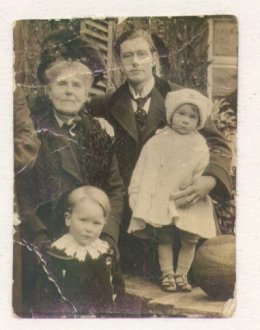
Marie Jenny Sugg with son Philip Henry before he became Managing Director
with his two eldest children Crawford & Monty.
————————————————
Workshops of William Sugg & Co Ltd During the Great War 1914-1918
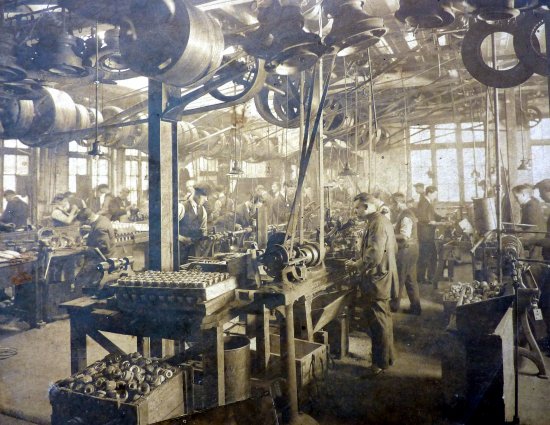
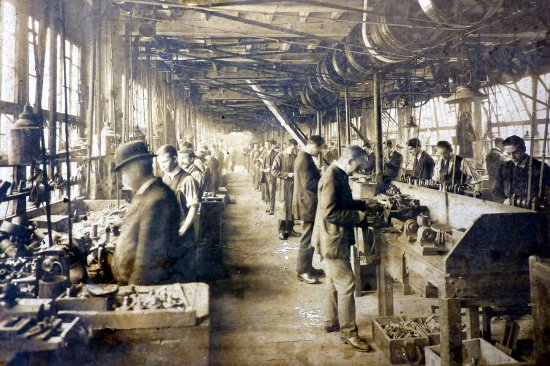
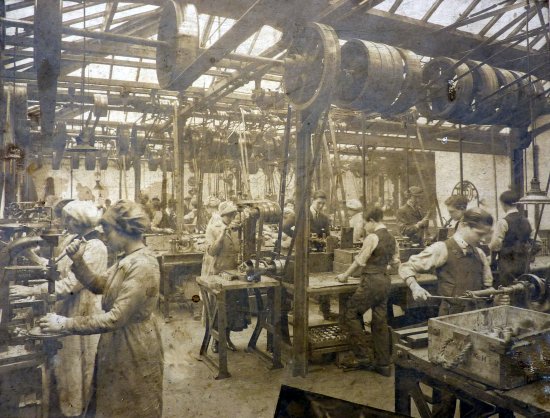
These 3 pictures illustrate wartime work. They were mounted on the display board shown below, doubtless to illustrate the major war effort of William Sugg & Co.Ltd. – perhaps to shareholders. The overhead shafting was driven by a steam engine in the basement, later replaced by an electric motor. The pure noise level of this amount of shafting and belts must have been terrific.
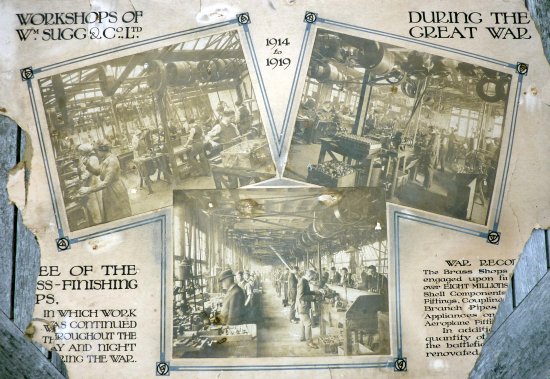
The text on the left states “THREE OF THE BRASS-FINISHING SHOPS. In which work continued throughout the day and night during the war.”
The text on the right states “WAR RECORDS. The Brass Shops were engaged upon finishing over EIGHT MILLIONS of Shell Components, Fittings, Couplings, Branch Pipes Appliances on —– Aeroplane fittings —- In addition — quantity of — the battlefield — renovated —-
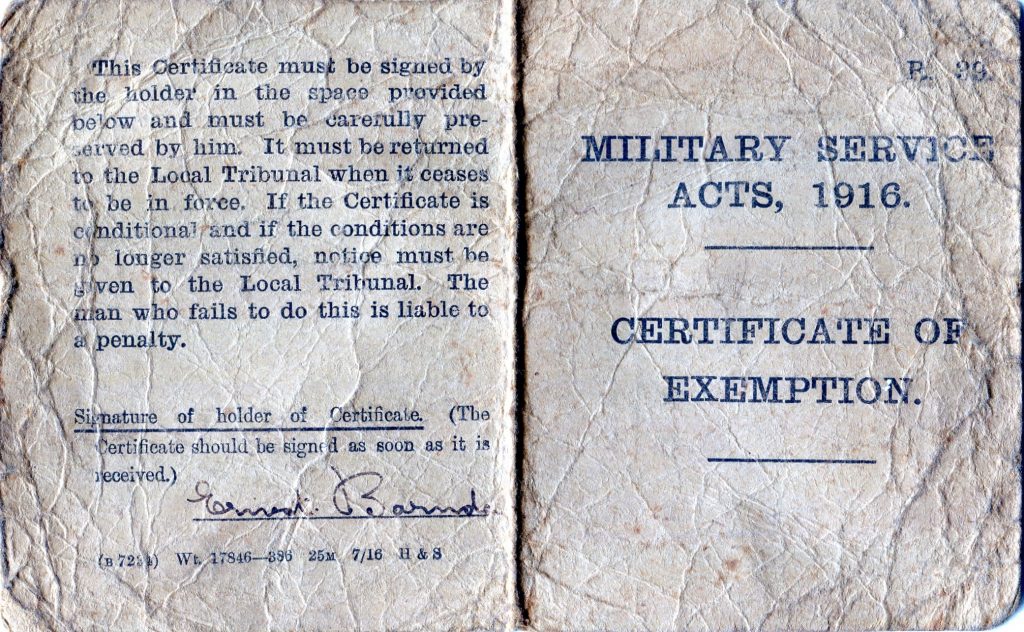
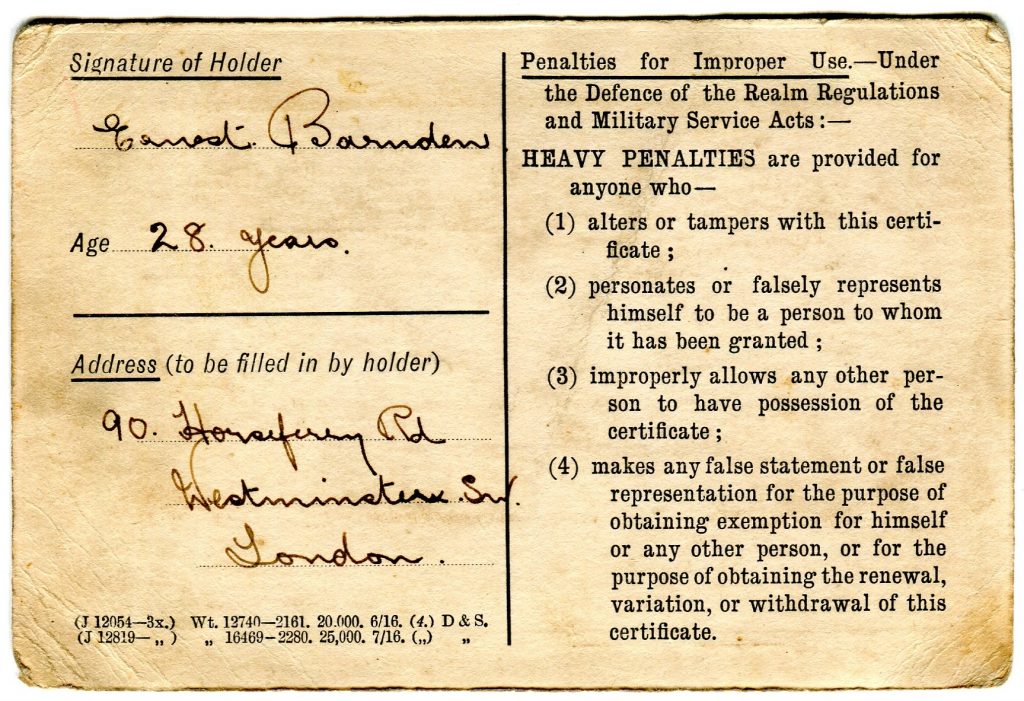
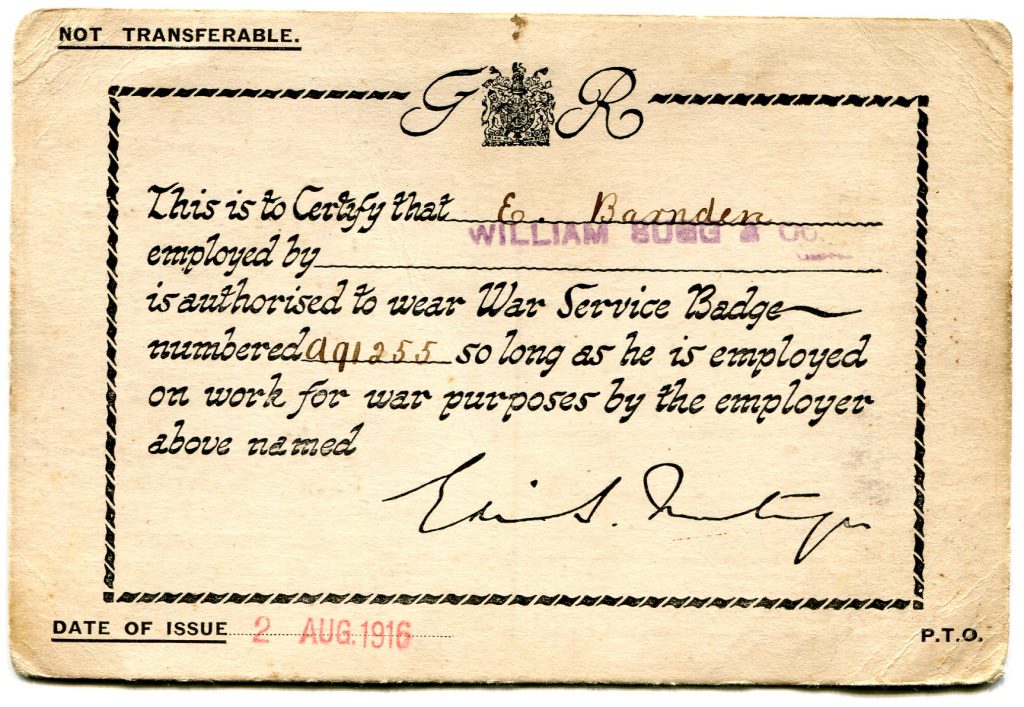
More historic information was detailed by J.W.Lofts who joined the firm in 1880 and thus knew William Sugg for a quarter of a century. He became Sales Manager and in due course was invited to take his seat on the Board in 1920. He resigned his position as Sales Manager in 1933 whilst retaining his seat on the Board and acted as Special Representative and Consultant until the end of 1936 when he retired. He followed his old boss in lecturing and printing lectures which survive and carry much useful information.
Extracts from Public Lighting by Gas by J.W.Lofts Nov 1924
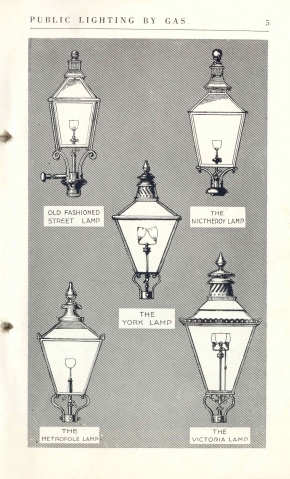
Lamp most generally in use in the 1850’s was of square shape carried in an iron cradle and was glazed in the roof as well as the sides with clear glass.
First improvement introduced by W.Sugg in 1865 was the Nictheroy (later called Camberwell). Square lamp as before but with opal glass in the roof acting as a reflector and in place of the cradle a neat frog.
| Nictheroy | Flat flame burner | 5ft/hr | 20cp (candle power) |
| 1882 York – 16” sq | Double flat flame | 10ft/hr | 40cp |
| 1882 Victoria – 18” sq | Triple flat flame | 15ft/hr | 60cp |
| 1884 – The Metropole an improved version of the Nictheroy shows the first introduction of the ogee top (and the use of oak leaf corners) | |||
| Dec 1879 – Lambeth hex 30” 38” | 20ft/hr 30ft/hr | 90cp 150cp |
|
| About this time Westminster octagon 44” | 50ft/hr | 250cp | |
| Journal of Gas Lighting March 29th 1881 Whitehall – forerunner of Grosvenor | 20ft/hr 30ft/hr | 90cp 150cp |
|
Carried a flat reflector annular in shape surrounding the conical porcelain reflector used in all previously mentioned lamps except very old fashioned square and the Nictheroy.
Then the Globe in various sizes from 50 to 400cp.
All the aforementioned except the two early square lamps were ventilated from the top, that is the air inlet was at the top of the lamp, passing over the heated surface of the reflector, thereby reaching the burner in a heated condition and so keeping the flame hot and not only so but being deflected by the shape of the reflector onto the glass panes ensured the necessary air reaching the burner without draught.
—————————————-
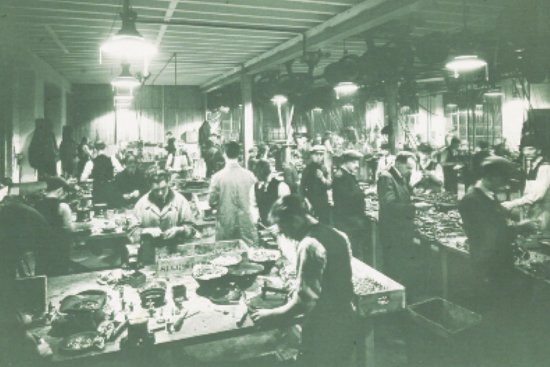
The ‘Long Brass Shop’ 1927, showing overhead shafting and belt drives to small lathes with staff finishing and assembling some of the huge range of ‘brasswork’ which was a staple of the Westminster Works to support the major lighting, cooking and heating equipment manufactured elsewhere in the building – as indicated in the ‘Work Carried Out’ list above.
(The preponderance of hats worn indoors is typical of engineering factories of the time. One reason is that the drive belts were liable to break and provide a nasty slap on the head if unprotected! The other reason may well be that the overhead gas lighting acts as a significant source of radiant heat which can be quite uncomfortable if working under it all day.)
I received the following letter from William James Smith via his daughter at the end of 2012 when he was approaching 94. I fear he has since died but he left behind a memorandum of life at Suggs from 1933 which includes names of employees and descriptions of the building and work. Interestingly he clearly worked closely with my father, Crawford Sugg in the construction of the triple mirror head device for optical measurements and other R & D work.
William James Smith
Memories of my time at William Sugg and Co.
My name is William Smith and I joined the firm of William Sugg and Co. at Easter 1933. I started work in the works office which was managed by a Mr Daniels, who I believe was the person who invented the DCD (or as it was known, the Distant Control Device). Also in the office were Mr Casford and Mr Burns.
Mr W Mattock was the first person to receive any daily orders and they were then passed on to Mr H Burns to go to the various departments who were involved. After Mr Burns had written them out it was my job to go to the ‘Shops’ and hand them over to the Foremen to sign. This meant I soon had the knowledge of the factory and got to know who was in charge of the departments.
Starting with the Entrance in Regency Street, the Time Office was to the left and WM Mattock’s office to the right. Then on the top floor was the Draughtsmen’s Dept., in the charge of Mr T Frampton, and also the R&D section supervised by Mr Crawford Sugg. The next floor down was the Tin Shop with Bob Clothier in charge.
I have tried to remember the “Shops” and the Foremen in charge:
Rochester Assembly Shop Mr Wicox
Con Sets Shop R Hubbard
Paint shop T Hurd
Joiners W Coghill (H) xx (xx common to the Smith list.)
Brass Machine Shop W Sweeney xx
Blacksmith Shop R Fuller xx
Automatic Shop W Squires xx
Brass Fitting Shop J Creed
Steatite Shop D Vanstan (J) xx (initial letter on the ‘scroll’.
Foundry Phil LeBrun
Packers (Lamps And Shipping Crates) W Clarke
Time Office R Dale (H) xx
Tin Shop R Clothier and then William James Smith!
Other departments were:
Plating Shop, Spinners, Testing Shop, Stores, Wages Office
I started my career at Easter 1933 and finished my apprenticeship in 1940. I was called up to the army and served until 1946; I then re-joined the company and was soon making Windsor Lamps.
I was called upon to make two triple-mirrored stands; one for the firm and one for Siemens, a very enjoyable and interesting task.
I also undertook a lot of R&D work for Mr Crawford Sugg.
I left the firm in 1960 when my family relocated to Southampton. When I handed in my notice, Mr Crawford Sugg came to see me personally to ask me to reconsider and offered me a pay rise but I had already secured housing and a job in Southampton and my family was set to move.
I do hope that this is of help to Mr Chris Sugg and as I am approaching 94 apologise for any inaccuracies or omissions as my memory is not as it used to be. I would have liked to have seen a copy of the firm’s lamp collection brochure to remind me of my time. I have seen the pictures on the computer and they look very interesting and bring back many memories.
Best Wishes William Smith
December 2012
Received 4th Jan 2013 in sequence of emails from Lesley Hurrell.
Since adding the section on ‘People’ https://williamsugghistory.co.uk/?page_id=2911 I have received a picture of Bill Smith from Lesley and have added this to a copy of the letter above and to complete the story linked it to the Technical section where you can see the triple mirror device two of which Bill made for PCS. https://williamsugghistory.co.uk/?page_id=167
THE CENTENARY DINNER
The Centenary Dinner was held on 29th October 1937 at the Holborn Restaurant, London.
The menu was bound to match the Centenary booklet that you can see on the Home Page and no expense was spared with 7 courses, drinks to match, 8 pieces of music by different composers and 5 artistes.
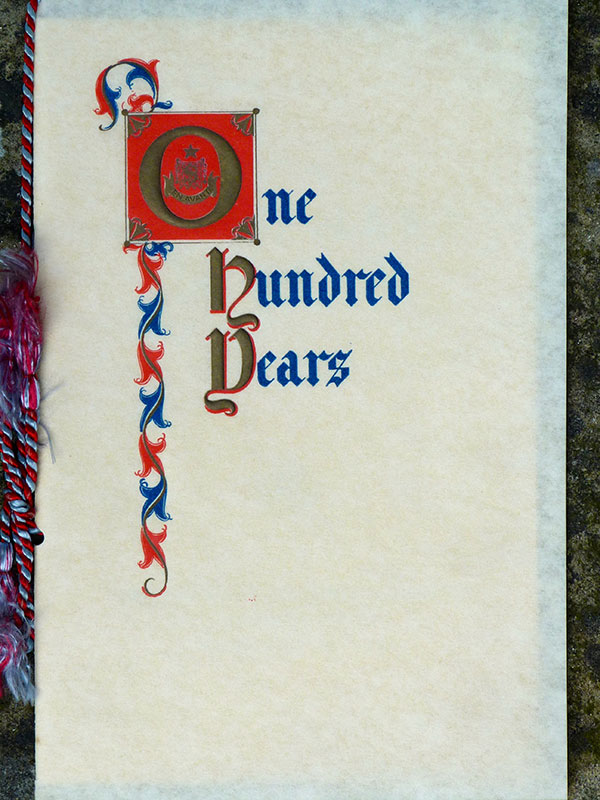
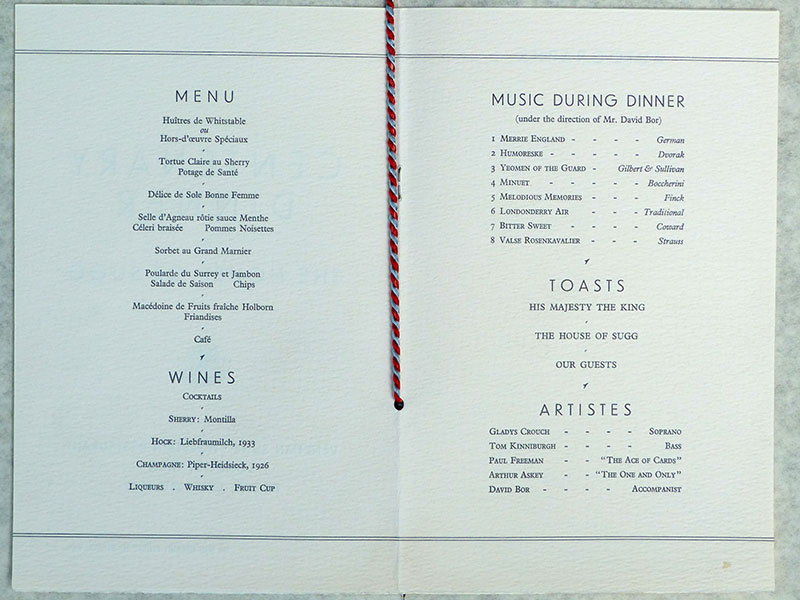
P.H.Sugg is standing at the centre of the top table in both pictures.
This is the List of Guests – with some alterations!
And this is the bill from the Holborn Restaurant below. (122 dinners at 10/6d (52.5p) = £64.05)
Development of the Lighting laboratory by P.C.Sugg is detailed under Light Measurement in the Technical Section
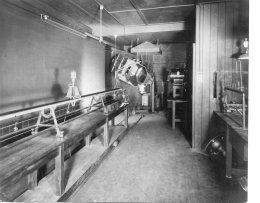
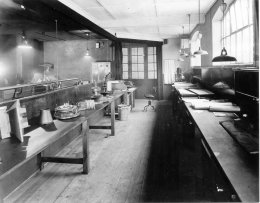
——————————————————
The Second World War Years
William Sugg & Co. Ltd had been located in the same area of Westminster close to the seat of power ever since its founding whilst the city grew around it becoming the ultimate target for the wartime efforts of the Nazis.
Inevitably, the blitz in the relatively early years of the war resulted in a direct hit on the Sugg works, fortunately at night when the buildings were empty. The photo below illustrates the significant damage to the blacksmith’s shop and the machine shop to the right. What it does not show is the obliteration of the drawing office which, as the business grew, had been moved into a building erected on the flat roof of the factory. After the war this resulted in a huge re-drawing task by Eric Petty who joined the company after a war spent in the RAF. The older and therefore out of use drawings were naturally considered of little importance in the scheme of things so were consigned to the wastepaper basket of history – only literature illustrations remaining to help future generations reconstruct the past. (Eric much later joined the follow-on company of Sugg Lighting as our first draughtsman, for a few years prior to his retirement and told me that they had collected every print from the factory floor that they could lay their hands on and his first task at the Company had been to spend months re-drawing all the relevant drawings. This explains why no original early drawings exist and a large number of pre-war product drawings have early post-war dates with the initials EP!)
Bomb Damage in the Blacksmith’s Shop and Machine Shop to the right.
The following pictures of the same bomb damage came to light in 2015 starting with the same picture but with slightly higher view
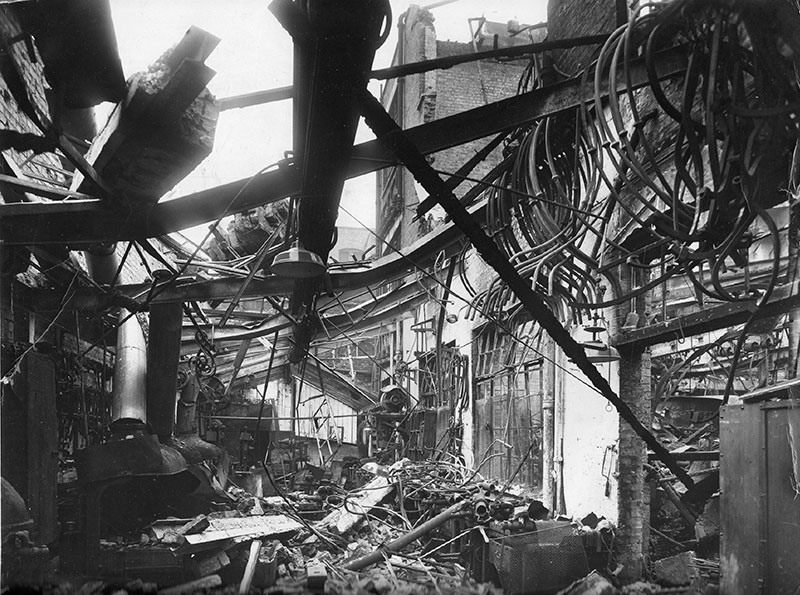
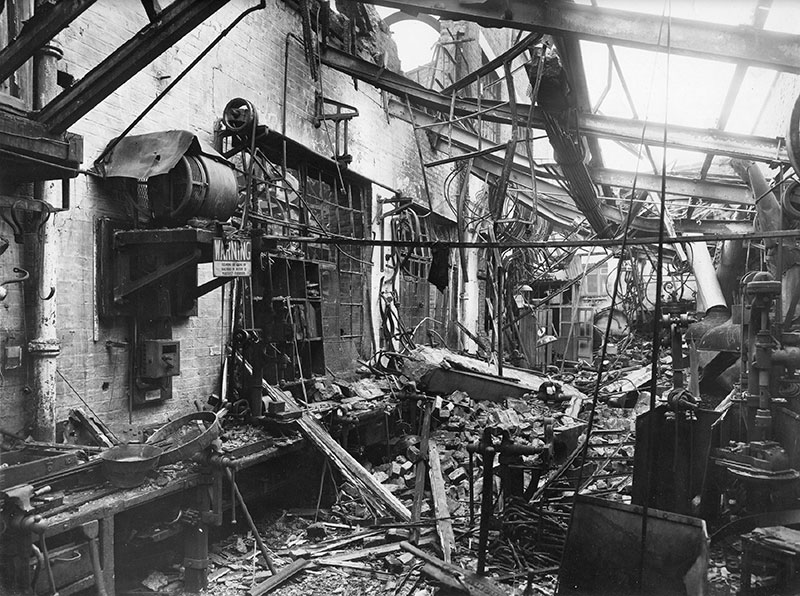
The next view below is the ‘rooftop’ which has collapsed completely
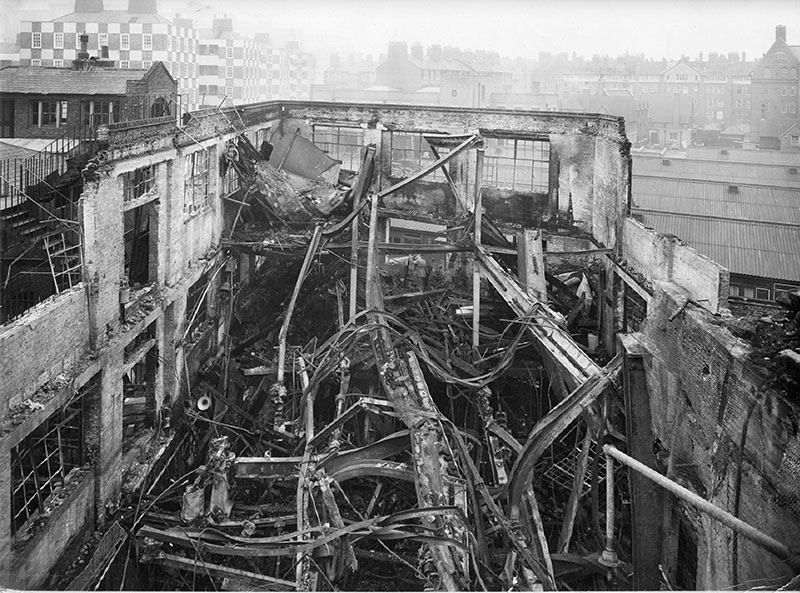
The view below is one floor down which has also collapsed.
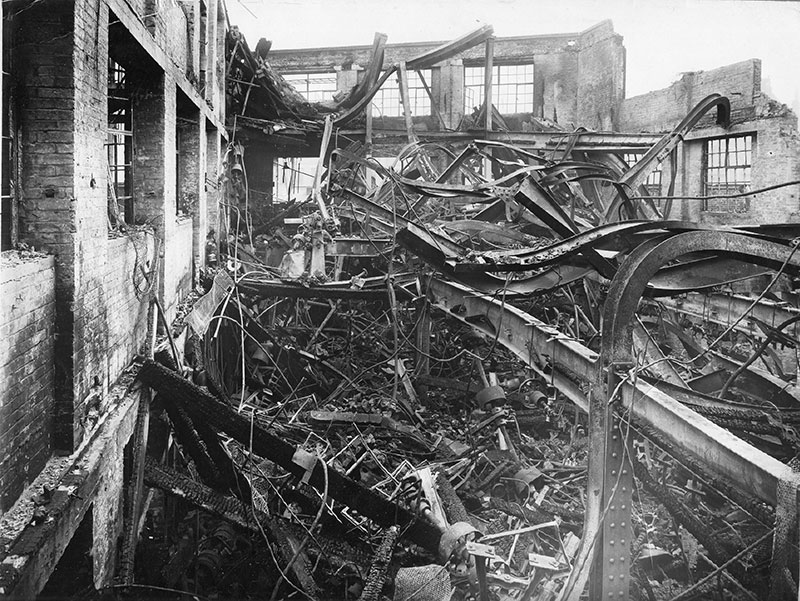
The next picture shows a press that has been deposited in the Taylor lathes shop below. You can also see through the ‘window’ one of the Gas Board vans from the gasworks which was directly behind the factory.
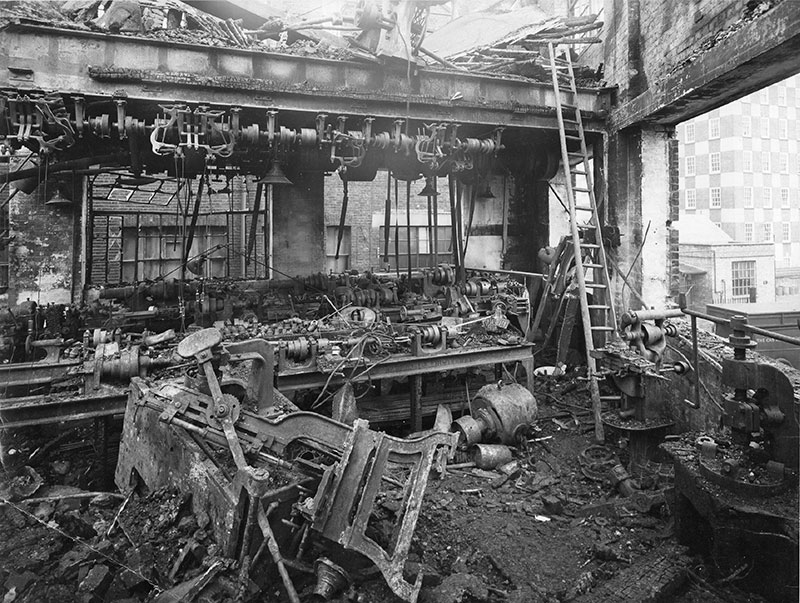
The Automatic’s shop shown in the last two pictures below only lost one machine, irreparable, according to the report by William Mattock in the immediate aftermath.
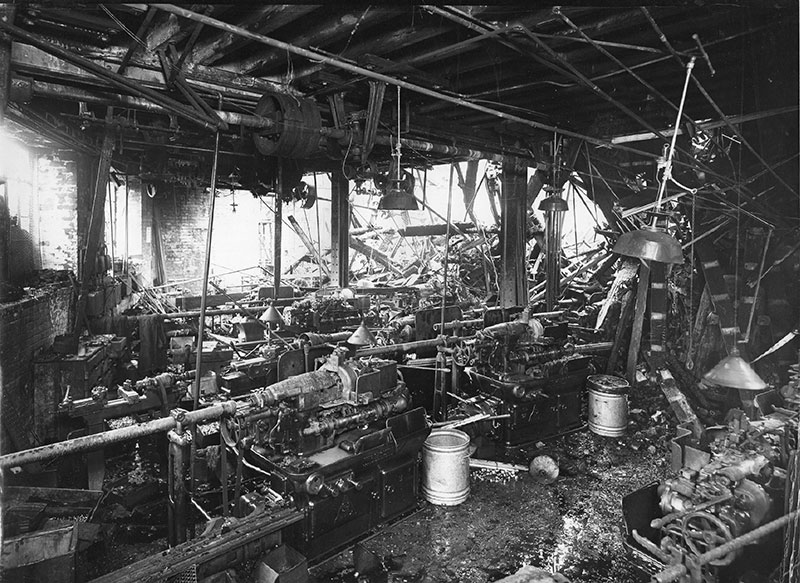
The three pictures below show the Edmonton factory, that had been used for cooker production, following a direct hit. It was never used again after this damage.
ALL THESE RECENTLY ADDED PICTURES ABOVE AND THE THREE BELOW MAY BE ENLARGED TWICE BY CLICKING ON THEM ONCE AND THEN CLICKING AGAIN ON THE TOP SYMBOL
The second significant aspect of the war was a huge amount of business in the production of armaments much as had happened in the First War.
The 1/4 millionth Fuze and part of one found by Colin Walton on the battlefield of the Somme in 2010. Carries a W Sugg stamp on the rim.
————————————–
Wartime as related through AGMs
The business was kept incredibly busy during the war years – manufacturing armaments. The 61st AGM in November 1942 includes the following report from Mr William Mattock:
“For several months of the year we have been working under great difficulties. We had the foresight in 1939 to acquire the property adjoining Vincent Works and to set out to build up an extension of the works; that was in November, and we were blitzed in the most important shop in December 1940. We transferred the builders workmen from the building of this new factory to the building that was destroyed by enemy action in order to enable them to pull down and rebuild this factory and afterwards proceed with the building of the new factory. That building has now been finished and is equipped in the basement with the Automatic Shop. Each machine is electrically driven, there is no overhead shafting and the shop is very pleasing to those who have to work in it. On the ground floor we are manufacturing Fuse parts and women are doing exceedingly well here. The floor above is occupied by Inspection and Gauging and the top floor has not yet been occupied but is being used by the Home Guard.
It is pleasing to know that quite a number of our employees have joined the Home Guard attached to this Company and are giving their services freely in the evenings in spite of their very heavy duties during the day.
There is a spirit of co-operation throughout the works and I think perhaps I might mention it, Mr Chairman, that a bonus was given to them last year which represented nearly a week’s money.
In the new building we have the basement portion as an air raid shelter which will carry approximately 450 persons.
On the floor above we have the tool room and turret shop. These turrets are all new and they are all electrically driven with no overhead shafting. The next floor is for inspection and on the top floor we have built a very fine and up to date canteen to seat 300 people. It is fitted with the best up to date plant and we are hoping to get it running early next week. I am sure this canteen will be very much appreciated by the works generally.
The foundry has been doing exceedingly well on all Government work and there are quite a number of women working there, which was at one time considered almost impossible.
I think we have more women and girls working than men and boys and they are doing very well indeed.”
The report on behalf of the auditors by Mr RW Young states that the financial position of the Company is stronger now than it has ever been in its history.
To give some idea of the effort being put in at this stage of the war I quote from the report of Mr Tom Mattock who as General Manager “was the leading force in the reorganisation and re-establishment of our bombed works”.
“My father mentioned about the Home Guard and I would just like to enlarge upon this matter because I would like the shareholders to realise that, while these men in the factory are working on Government work, they are also giving up much of their time to Home Guard. For instance, in the factory they work from 7:30 in the morning until 6 o’clock at night, on Friday until 5:30 p.m. and on Saturday and Sunday until 5 o’clock, but over and above all that, they find time to put in two evenings a week on the Home Guard. We have approximately 200 male employees in the firm which is I think a very good proportion because a very large number are already in other Home Guards throughout the country.”
The report from Mr William Mattock in the immediate aftermath of the bombing in 1941 illustrated in the photographs illustrates the effort put in to re-establish production:
“As soon as possible we had all our men engaged in clearing away the debris and as each machine was rescued a gang of men were put on to strip it down, recondition it and pass it over to another shop where it was got running”
“I may add that many of the representatives from the different Ministries who visited us congratulated us on the way in which we were tackling the job and the promptness with which we again got into production”
“I am pleased to say that we have most of our automatics running. I think only one was too bad to re-condition and we are now in full production!”
The Chairman indicated in the 1941 AGM that there were 92 of our people serving in the Forces and I know you will be interested to know that we have a little fund which we call the Comforts Fund to which the staff and works subscribe weekly according to their own individual ability. This enables us to send the men serving 5/- about every nine weeks to help him to buy cigarettes or whatever he wants. This fund is entirely voluntary and is, I understand, very greatly appreciated by them. The shareholder will also be interested to know that 5/- a week is being paid to every serving man out of the shareholders’ own money. This is entirely different from the Comforts Fund and I am sure you will think it is not too much. It has been paid to the men since the commencement of the war and those who joined up before the fund was started received it retrospectively. This 60th AGM was also the 21st year of the Chairmanship of William Sugg & Co Ltd of Philip Sugg.
In the 64th AGM in 1945 the Chairman confirmed the numbers of employees who left for war and other services was 144 and, “of these we have had back about 12 but we are hoping that most of them will get their release papers shortly.”
He also asked Mr Tom Mattock to report on the products that had been produced during the war and on which nothing could be reported previously for reasons of national security.
“Over the five years of war we have turned out what amounts in value to nearly £2,000,000. For the Ministry of Supply we have made over 3.000,000 Fuzes of various types, over 3,500,000 Fuze parts. We did quite a lot of work in the development of rockets, a great deal of the experimental work was done by us.
For the Ministry of Aircraft Production we made over 2,500,000 aircraft parts for direct contracts and 5,000,000 parts for various sub-contracts.
For the Admiralty we made 30,000 deck tubes for carrying electric cables and we were also honoured by being asked to make a special counter-mining pistol which was ultimately used for blowing up the concrete emplacements on the Normandy coast before the invasion and we had a letter from the Director of Contracts Admiralty thanking our work people for working seven days a week and many, many hours overtime, in order to get this pistol ready in time, which was six weeks.
We have also made about a million Niphon plugs, electrical plugs and switches; 450 tons of castings in the foundry.
Then we were called on to make some fresh water stills. You will probably have read something about them in the papers. We made over 2000 one-gallon size and over 400 of the four-gallon size.
Naturally the cessation of this work caused a huge drop in business and the urgent need to re-establish the nature of the original business. Sq.Ldr P.C.Sugg on returning from 5 years in the RAF was appointed Director Research & Sales, an enormously challenging position. In his first report at the AGM of 1945, Crawford Sugg indicated that only two of the total pre-war staff of 16 remained but was upbeat about the prospects as he had attended the conference of the Association of Public Lighting Engineers immediately following his discharge from the RAF in September at which 1000 Councillors, Delegates and Engineers were present. He reported considerable interest in our street lighting products, particularly in the more recent types and that our prestige remains high as ever despite our virtual inability to effect deliveries during the war. He even indicated an interest from Europe and the Far East.
In so far as development work was concerned which was considered as the essential basis of continued sales, here again they were faced with depleted junior staff, the programme was very full and was divided into short and long term sections of which so far “it has been possible to deal only with part of the former” “However, I face this responsibility with confidence having gained further experience in such work under the testing conditions of the Air Force where, it was my job, amongst others, to light the way for both the air and ground forces engaged in the invasion of Europe.”
Comment in 65th AGM 1946
When discussing the problem of attracting labour after the war it is clear that there has been a lot of pressure on wages to attract staff. In 1944/5 we paid them 4.1/2% bonus which was equivalent to just over a fortnight’s money. This year we are paying about 2% bonus which is about one week’s money. In future the Board have agreed to pay 10% of our profits annually for distribution to the workers so it is up to the workpeople to make them as large as possible.. They have other facilities such as a Social Club. They also have a non-contributory pension scheme whereby an employee who has been in the company for 30 or more years and has reached the age of 65 years is given a pension which varies between 15/- up to, in some cases 30/- per week for foreman. So they have a lot to thank the shareholders for. The Chairman reinforced the point that this Pension and Benevolent Fund is the entire property of the shareholders and is a reserve upon which we can draw should things ever become serious. It is non-contributory and is thus your entire property.
——————————————————
The following description of the two William Sugg factories in 1947 was written in 2005 at my request and, as it turned out, shortly before his death, by Basil Raymond Sugg. Ray was the youngest brother of Philip Crawford Sugg, both of course grandsons of William Thomas Sugg and it describes what he found, on joining the business to assist his older brother with the development of products after the war. (See also Warm Air Heating.)
1947 – The two Sugg Factories
“When I arrived to join Sugg’s on a cold January day in 1947, I reported to Ranelagh Works, Chapter Street and I think a description of the place will help to set the period and the scene:- Ranelagh Works had been built mainly to be a warehouse arranged round a parking area for vans and cars, and the front and left hand blocks had ground floor raised to lorry loading level. There were several steps leading up to the gateman’s office on the right of the arch, which was occupied by Robbie and had been for many years. Beyond his office, a dark panelled passage lead to the offices of PHS, AAS, their secretary, and the Board Room.
(PHS was Philip Henry Sugg, MD and father to both Ray & Crawford Sugg and AAS was his brother, Anthony Aincham Sugg who was Company Secretary)
Going back into the archway and up the left hand steps lead to an entirely different pair of modern offices for Crawford’s secretary, Betty (surname?) and Crawford. Through the archway, the left hand block had a basement completely full of cooker castings (mainly commercial patterns) salvaged from the Edmonton fires. The ground and first floor were also stores, containing incinerator castings, small cooker parts and gas fire spares. No one worked there.
The right hand block had only two stories with an outside iron staircase. The lower floor had been a lamp assembly shop but was now empty, and the upstairs floor was the pre-war photometer and technical department. I think the triple mirror head had already been sold, but the photometer bench and total light box still remained. as did most of the pre-war staff – Les Vivian, Harry Towell, George Hart jnr, Terry (surname?) and at least one more, (name?). They were quite busy dealing with incinerator installations and railway lighting enquiries, but there was a “Last Chance Saloon” atmosphere and all of them had departed within about two years. Len Stockton and Bill Rose provided the practical assistance with exhibitions, trials and prototype work. Len was very skilled in all forms of gas supply control and Bill was a very versatile craftsman who was used to working from sketches on fag packets.
Len Stockton had very severe lung problems, which I believe resulted from the 1914-1918 war. He lived just off Clapham Common South side within a few yards of the old family house “Morningside” in Cavendish Road, which was still quite evident at this time, although it was behind a petrol filling station. Crawford frequently took Len to his home in the evening as no detour was needed, and I always thought of him as a family friend. Unfortunately he died shortly after we started to work together.”
(In fact Len was related through marriage as follows. Alfred Leonard Stockton married Aline Margery Friedleben one of 8 children of Elizabeth Clara (Lizzie) Sugg and her husband Georg Friedrich Carl Friedleben. Lizzie was one of 3 children of William Thomas Sugg and his first wife Jane Emma Parker.)CS
“Vincent Works was much larger than Ranelagh Works and had an imposing façade. (See pictures above.) The entrance from Regency Street was raised by several steps and there was still a trace of security about it. One had to report to the office on the right before entering the main doors. This stopped soon after I arrived. Through the gateman’s office were modern offices for Tommy Mattock and his secretary,
Passing through the main doors, you faced the remains of a showroom, which contained an incinerator, an 8000 lamp on short pole, the model of the triple mirror head photometer and chunks of packing material, all very dusty. To your left was a door leading into the works office, occupied by Mr Paul and other progress chasers, Harry Burns, Works Foreman, and a couple of typists. Through the door at the back of this office there was a staircase on your right which went up to the general office, accounts office and drawing office, each occupying one floor. Tom Frampton was in charge of the drawing office, which at that time only had two other people.
Through a further pair of doors you entered the works proper and the tinsmiths shop, run by Bob Clothier. Their chief job was making Windsor lamps, but as copper sheet was only available on licence the only work was for the Ministry of Works, and the shop was nearly empty. In the centre of the shop there was still a large railed off hole down into the basement which I was told had once housed the engine which ran all the works. Throughout the works there were no internal staircases, and each floor was reached by outside iron stairs. There was nothing above the tin shop, but beneath it were the spinners, run by Mr Burrage, and the Works Engineer’s run by Fred Onslow, with facilities for welding, some blacksmiths work, and of course shafting and belt work.
The tin shop connected directly to the first floor of the left hand block, alongside Vincent Street. which was full of Ward 2 and 3 capstans, belt driven, and redundant. They had worked hard during the war.
Above this floor was the steatite shop, still with security notices on its doors, and remnants of its work scattered around. During the war it had been a main source of insulators for radar valves, it having been found that natural steatite “outgassed” less than porcelain under the power and vacuum conditions in high powered valves. Porcelain had caught up technically and good steatite was difficult to get from India, so no more work.
The ground floor (at Vincent Street level) combined the foundry, still run by Phil le Brun and the pattern shop, sadly no longer with my old friend Coghill who had taught me a lot about woodwork during various school holiday visits. The foundry produced very high quality brass and aluminium sand castings, largely on sub-contract work and had spare capacity.
The right hand block could also be accessed at first floor level from the tin shop and this floor housed the toolroom (name?) and test room for all gas fittings, run by a splendid Salvation Army musician (name?).
Below this was the working capstan shop, run by Bert Perrotton, and containing much more modern machines up to Ward 7D’s, the newest being self motorised This shop was fairly busy but still had idle machines. Just outside the entrance to this shop was the degreasing plant.
The second floor was the lamp shop (name?), not very busy because of shortage of copper, but producing almost entirely for railway contracts.
The third floor was the works canteen, very popular at this time because it was still heavily subsidised at wartime levels. The subsidy stopped shortly afterwards and the canteen reverted to tea and buns!
The most modern part of the factory was the central block, erected in the 1930’s I believe. This has four stories, with the basement occupied by Index 6, 12 and 24 autos, run by George Squires. With a huge potential output, this department appeared always to be busy, but this was largely sub-contract at this time.
Above the auto shop was the brass finishing shop, run by Mr Sweeney. This shop was busy as there was a good demand for small brass fittings from the Gas Boards.
Up the outside stairs to the second floor lead you to Eddie Quy and the light assembly shop which dealt with governors, incinerator timing devices etc and also did final assembly of the 3700 small incinerators.
The final climb took you to the part stores on the top floor.(name?)
The one department which I haven’t managed to fit in was the polishing and bronzing plant.”
(As you can see the business was in a pretty parlous state due to lack of development over many years and it wasn’t until PCS and his brother BRS tackled the development of what was to become the ‘Halcyon’ warm air heating appliance and ‘selective heating system’ that the business and the Gas Industry re-awoke to the second half of the 20th century. C.S.)
——————————————————
The Festival of Britain 1951
In the meantime, however, “The Festival of Britain” was launched in 1951 to showcase all the newest and best of the UK after coming out of the war and this picture is just to remind those who believe that gas lighting was ‘Victorian’ that here is PCS, (Crawford Sugg), the Technical Director of William Sugg & Co Ltd demonstrating some modern gas street lighting that the company has developed – in particular the Southport and the 8000 lamp (nearest to PCS) using the remote control switches he is operating.
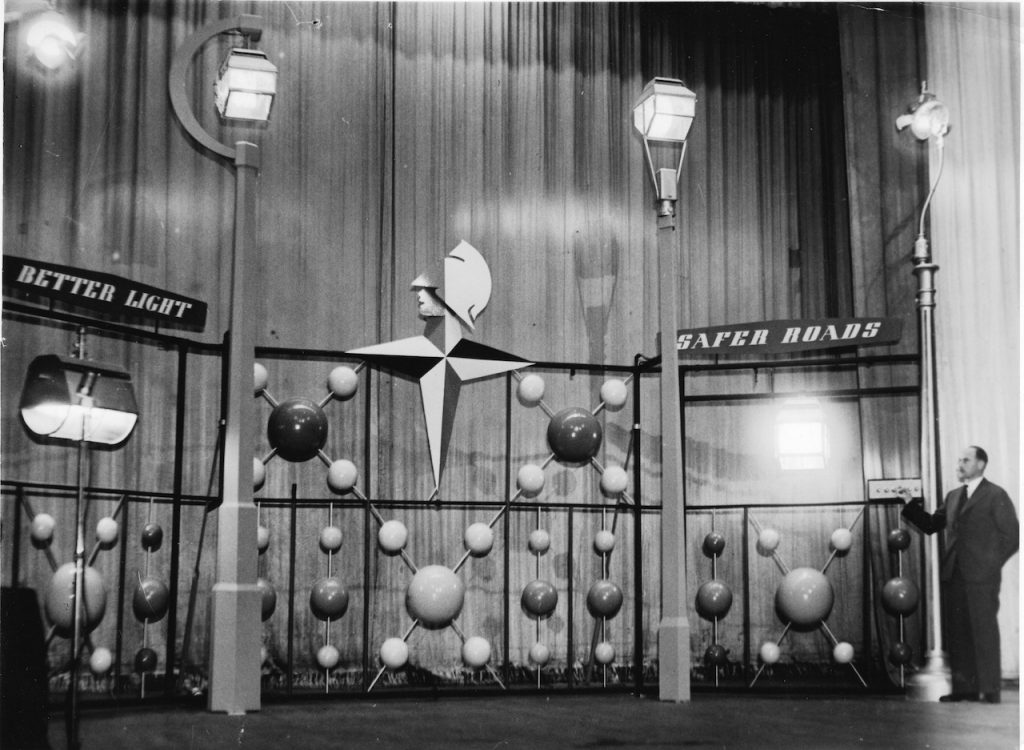
In addition, the Company decided to showcase its history with an exhibition of both venerable gas street lamps and a Victorian drawing room with interior gas lighting in Ranelagh Works, Chapter Street. Invitations were sent out to members of the press and gas boards and people were encouraged to visit from the Festival of Britain site on the South Bank.
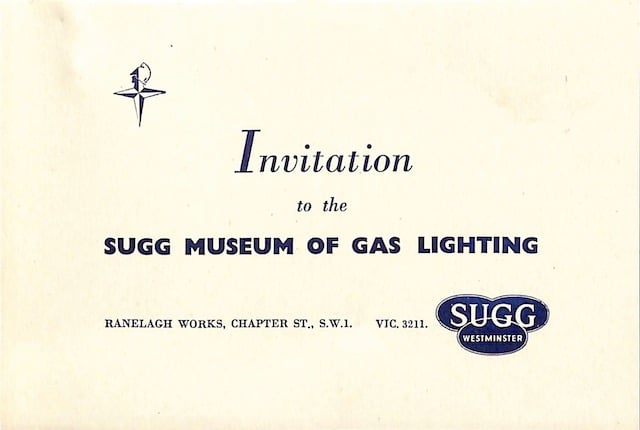
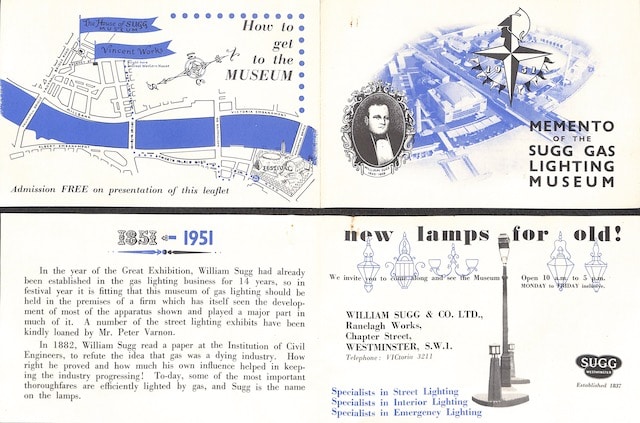
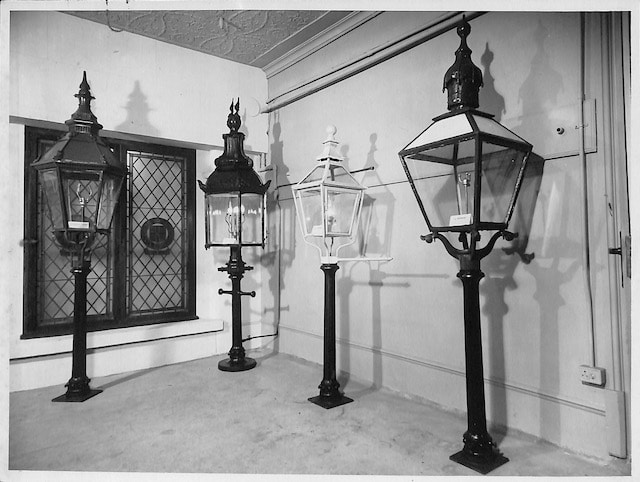
Notes from the 74th Annual Report, 30th June 1955 (Several important items introduced with this report including a comment relevant to the item above! CS.)
W.T.Mattock Chairman & Managing Director (First Occasion)
Philip H, Sugg (Retd Chairman remaining as Director)
R.W. Young FCA
P.Crawford Sugg B.Sc.Eng., A.C.G.I., M.Inst.Gas., F.I.E.S.
C.C.Penfold
Secretary W.K.Fox, A.S.A.A.
Must expect a considerable reduction in the manufacture of armaments during the current year. Hope that the use of our Crawley factory and progress in gas heating appliances will continue and so mitigate to some extent at least the diminution in armament contracts.
(So you can see that in 1955, the factory was still producing armaments 10 years after the cessation of hostilities of WW2. CS.)
—
Erection of Crawley Factory is now completed and production has already commenced on a limited scale.
—
New subsidiary company – Sugg Solar Ltd., – has been formed to whom an exclusive licence has been granted to manufacture and market the Mars Gas Turbine Engine in this country, Europe and the British Commonwealth (excluding Canada). The Solar Aircraft Company has subscribed for a proportion of the Capital of this new Subsidiary.
Planning layout in part of the Crawley factory for the manufacture of this engine. Several successful demonstrations, using American made engines have been held and a great deal of interest has been shown therein by potential users, both Government Departments and Commercial concerns.
Stress this is long term project – first British made engine to be available in 12 to 18 months – commence to earn profits in 2 years
Story of Sugg Solar – a classic White Elephant? – see below. CS. This article provides the basics and has been added here as it has been introduced in this 1955 annual report
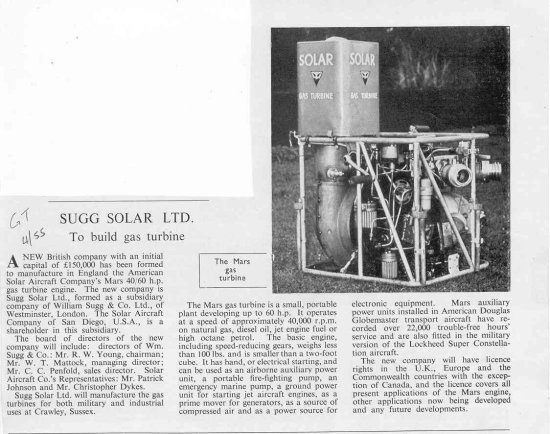
—
Acquisition of the entire share capital of Thomas Mattock & Co Ltd. “This is an old established Company which markets products similar to those of the Parent Company and which we hope can develop into a useful and profitable member of the Group.”
——————————————-
The story of Sugg Solar is a classic of its type. William Sugg had always been an engineering led business with products developed painstakingly – sometimes over years. Unfortunately after William Sugg died in 1907 this approach was steadily lost in the move to a financial led management. With two World Wars providing a huge amount of MOD business making armaments it would appear that the directors had no long term plan for products especially as the mainstay of the business for so many years, gas lighting, was suffering terminal decline.
As detailed in the story of the Halcyon warm air appliances and several other gap filling products, the two Sugg brothers, Crawford and Ray, grandsons of William Thomas, worked tirelessly on product development to provide a future for the business.
To some in the boardroom this was too slow and the words ‘gas turbine’ sounded both futuristic and, with the word ‘gas’ must be something with which William Sugg & Co Ltd., should be involved! Unfortunately it would seem the engineers were not consulted before the essential agreement detailed in the newspaper cutting above was rushed out. You will note that the directors listed do not include the technical director of William Sugg & Co Ltd., Crawford Sugg.
To anybody with a modicum of engineering knowledge, the difference between the production of gas appliances and that of a gas turbine engine is so huge that the first thing to consider is the manufacture. Nobody in the business would have had any knowledge and not one piece of existing equipment would have been of use. The levels of accuracy would have been unknown to a gas manufacturer and, despite the idea that the new factory in Crawley was to be the home of Sugg Solar it was painfully obvious to many that this product would never get off the ground – and it never did! The Halcyon – a proper gas appliance – progressively filled the factory and the Sugg Solar business was quietly extinguished.
——————————————-
And 10 Years Later
Chairman’s Statement in the 84th Annual Report for the year ended 30th June 1965
“On the 13th October 1965, Sir Henry Jones, K.B.E., the Chairman of the Gas Council formally opened the extension to our Crawley Works and Offices which marked the culmination of one of the major events in the history of the Company and began what we believe will be a new era of prosperity for the Company which has now left Westminster after nearly 130 years.”
(I had joined the Company prior to this as a production engineer with the task of laying out the new 100,000 sq. ft. factory as machinery came from Westminster and new plant was introduced to cope with the demand for the manufacture of the Halcyon warm air heaters. CS)
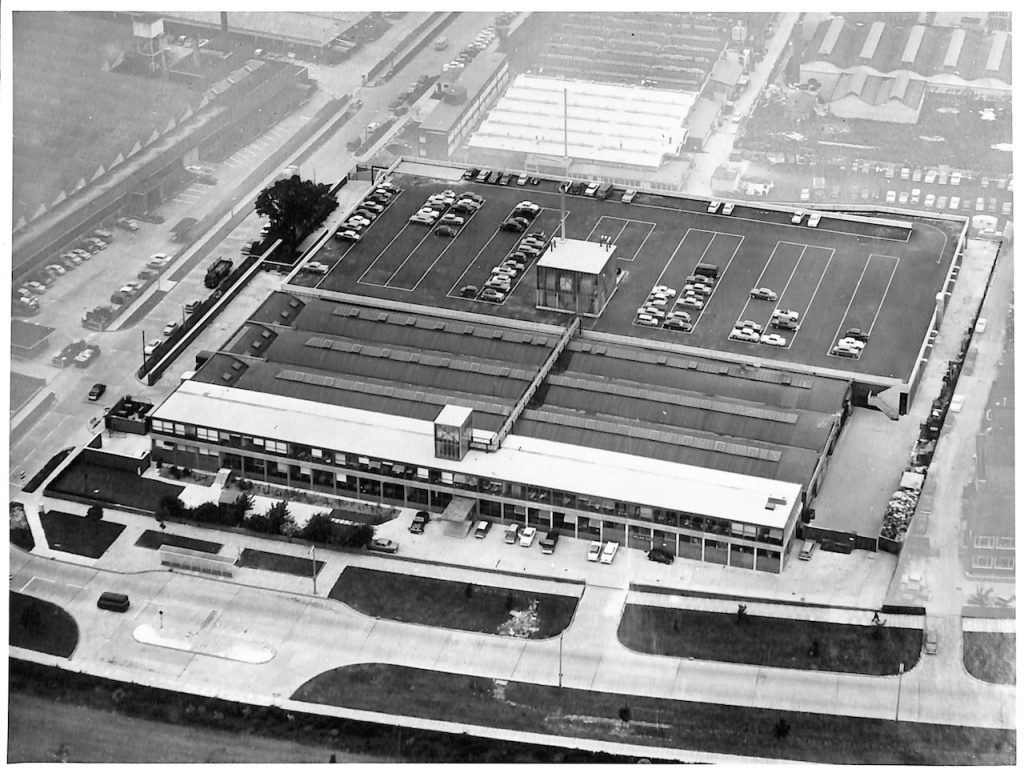
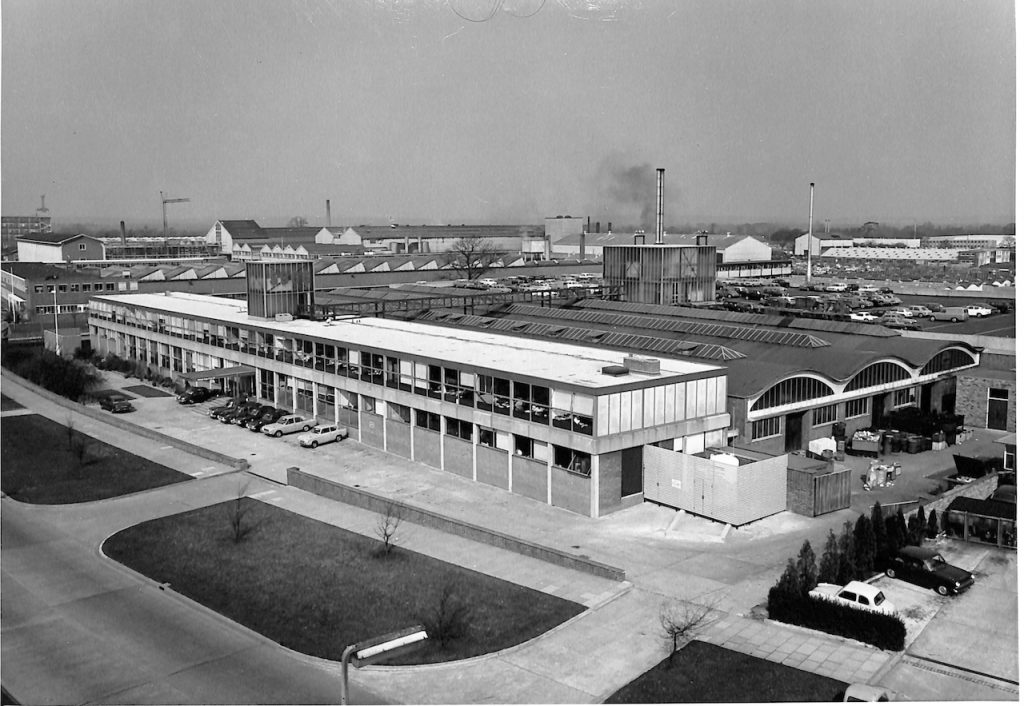
Aerial view shows unique rooftop car park over extended building and the second picture shows the later addition of a compound on the near front corner for the Natural Gas plant which was installed prior to conversion from Town Gas to enable testing of products and conversion kits in the laboratory.
The original Crawley factory was the section which can be seen with the barrel vaulted roof common to many of the earliest factory buildings on the “Crawley New Towns Commission Estate’.
William Sugg & Co Ltd., Manor Royal, Crawley, Sussex
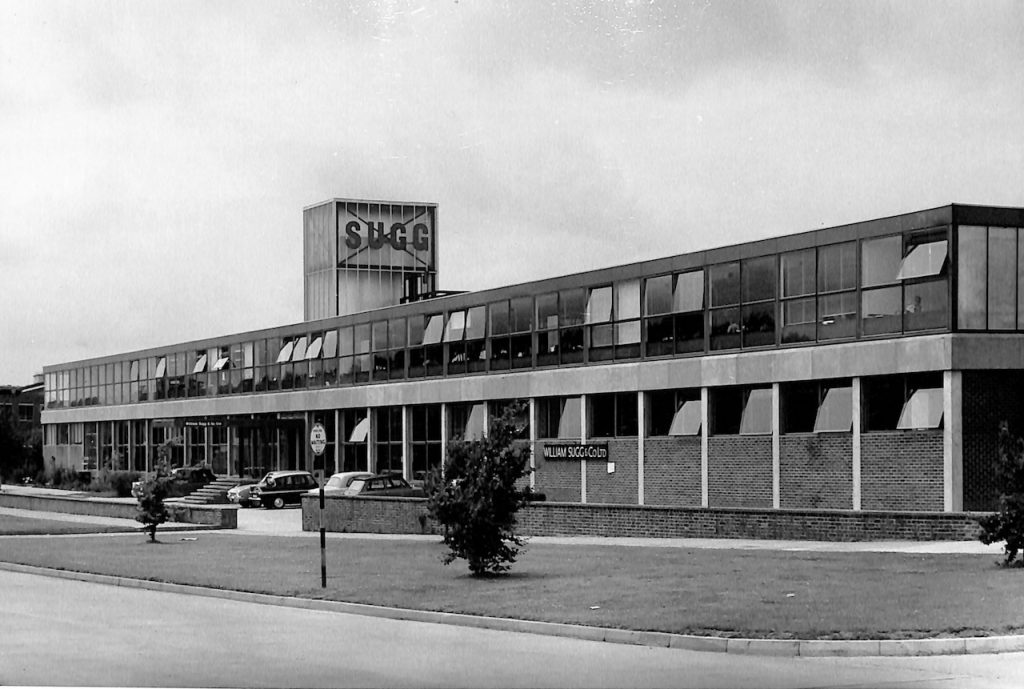
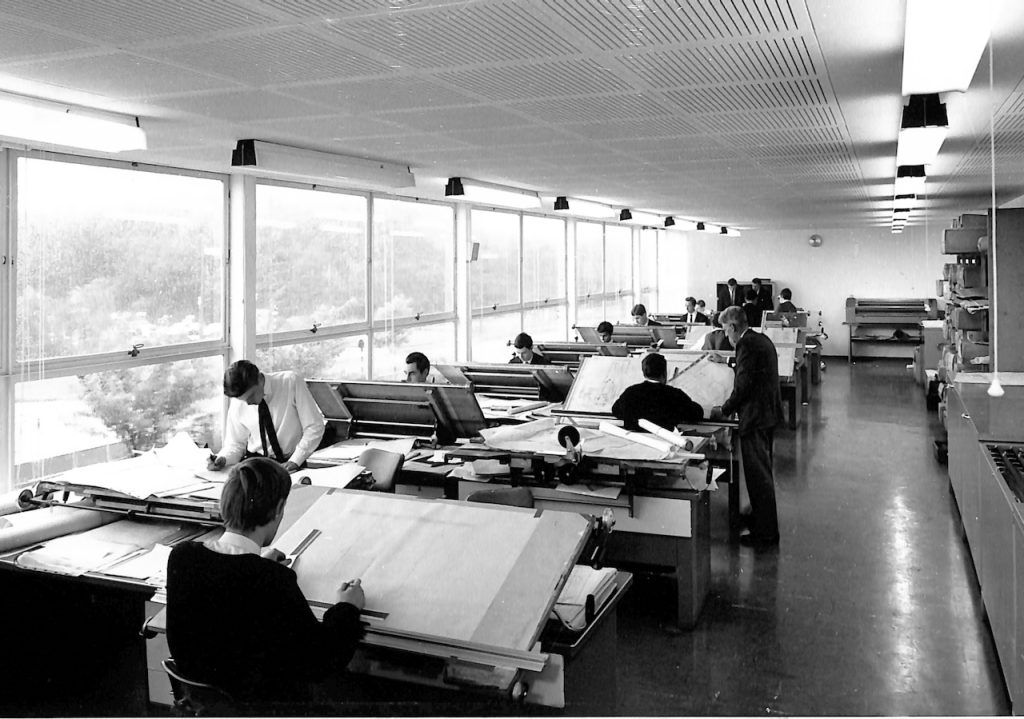
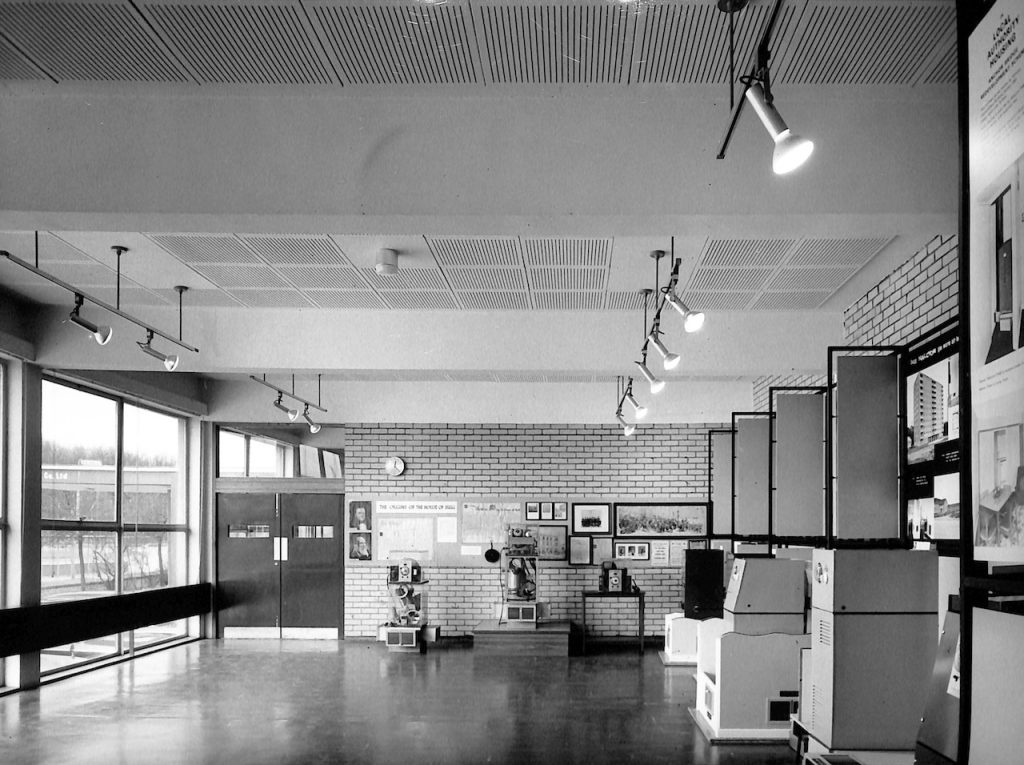
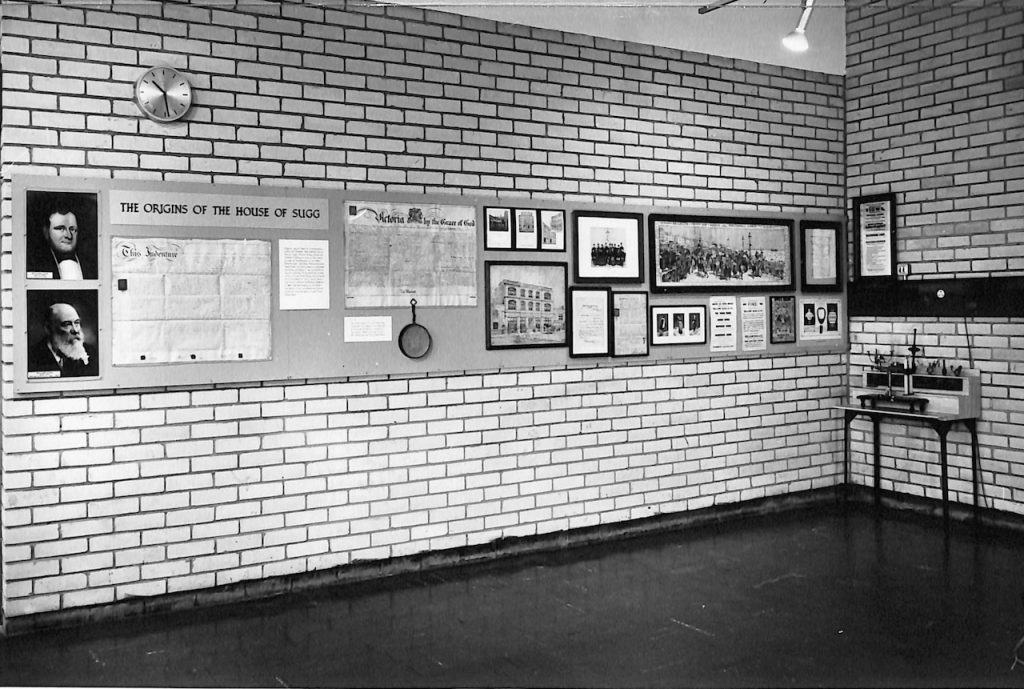
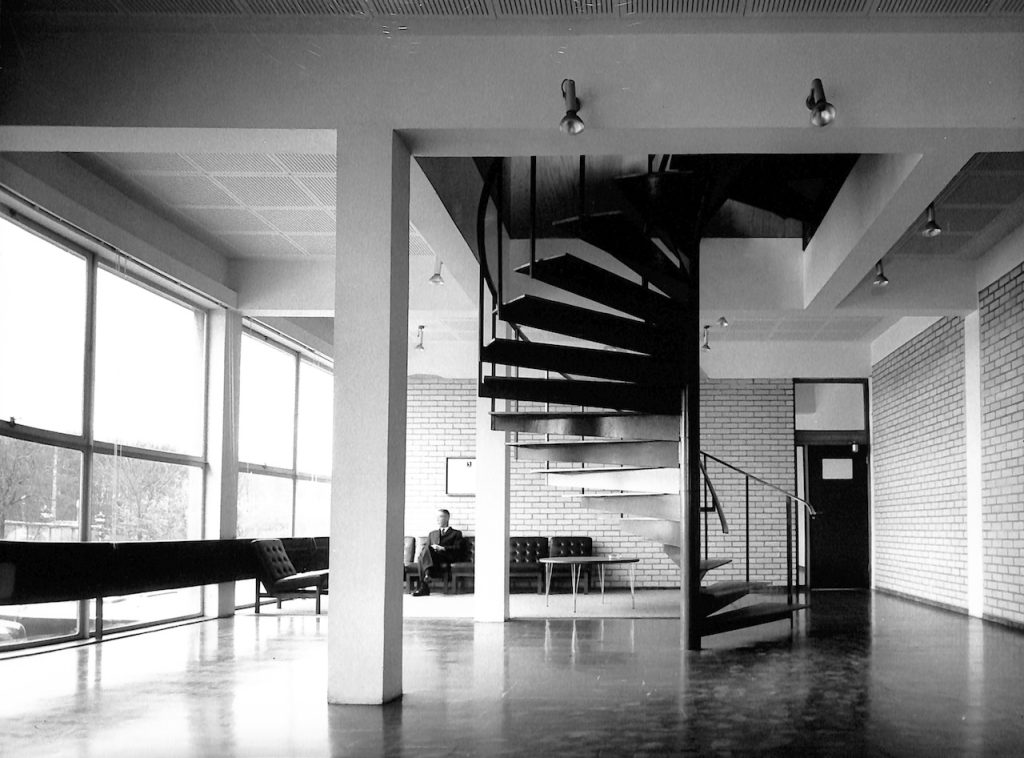
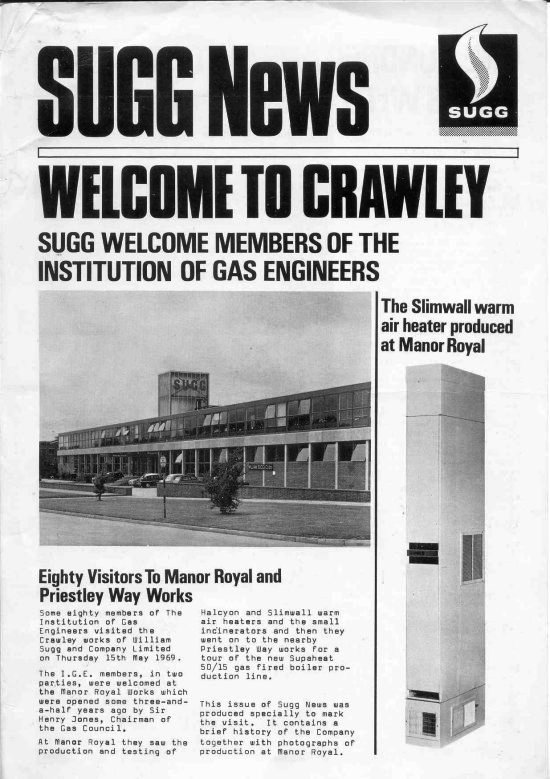
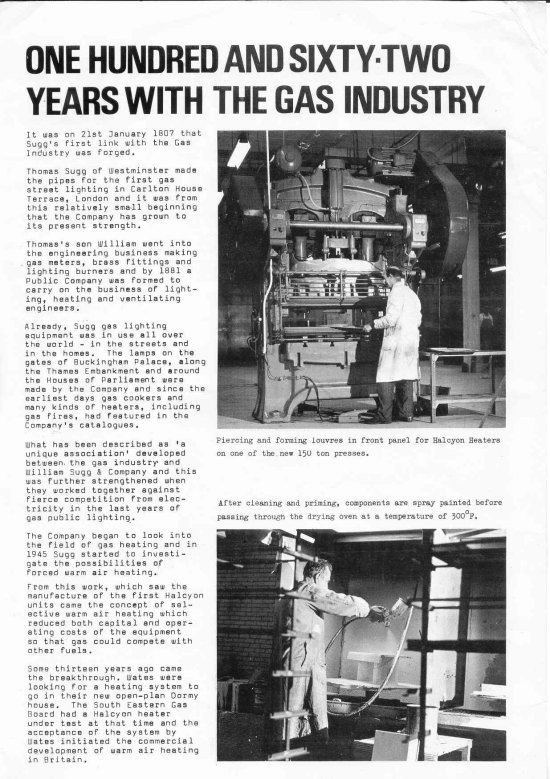
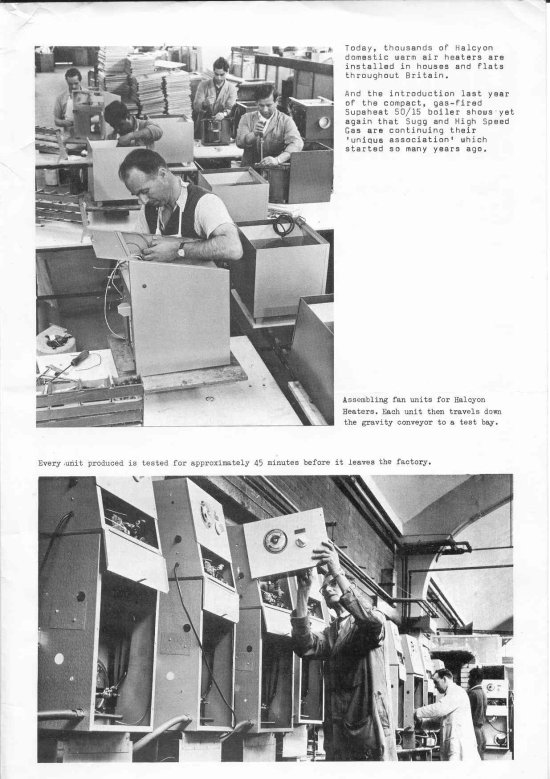
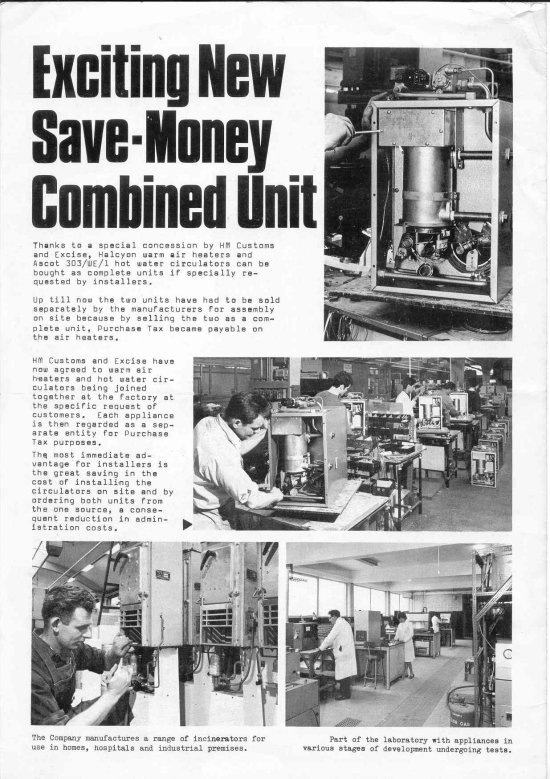
Having made the huge step from the Victorian factory in Westminster to the extended factory in Crawley New Town and achieved targets such as the production of 1000 Halcyon units in a week and the development of the first low water content boiler known as the Supaheat 50/15, the ‘New Era of Prosperity’ promised by the Chairman, R.W.Young was not to last for long. Within three years William Sugg & Co Ltd was the subject of a hostile takeover bid from Thorn Electrical Industries Ltd to which it eventually succumbed. Having then taken over International Janitor which was in part a Sugg competitor, the whole lot was put together in a new unit in Birtley Co. Durham with an office operation in Gateshead under the name of Thorn Heating. The Sugg name was consigned to history – or was it?
A tiny number of employees eventually moved to the north east but the vast majority considered it to be a step too far, took their redundancy money and found new employment or retired.
HOWEVER!
A small group of ex Westminster employees including the works foreman, Bill Gould with George Jacques, Jim Creed, Ron Lister and Ernie Clayton joined Chris Sugg and Keith Bouracier in forming a new company which eventually grew into Sugg Lighting Ltd. As a specialist lighting manufacturer with products still including gas lamps, the famous name was saved from extinction and continues today even gaining a Royal Warrant, to preserve, refurbish and re-make many of the best products of William Sugg. That’s another history but this is how it starts!
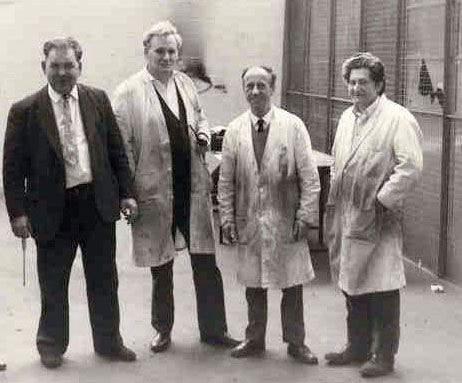
L to R Bill Gould, George Jacques, Jim Creed, Ron Lister.
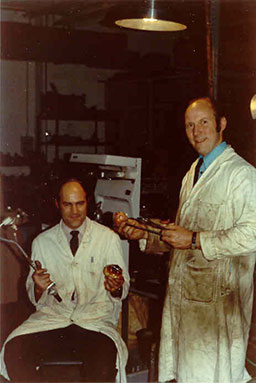
The founders, Chris Sugg, seated and Keith Bouracier, illuminated by the first new gas ‘Worklight’ designed for emergency lighting during the Miners Strike that resulted in the Three day week – and the reintroduction of gas lighting in 1973.
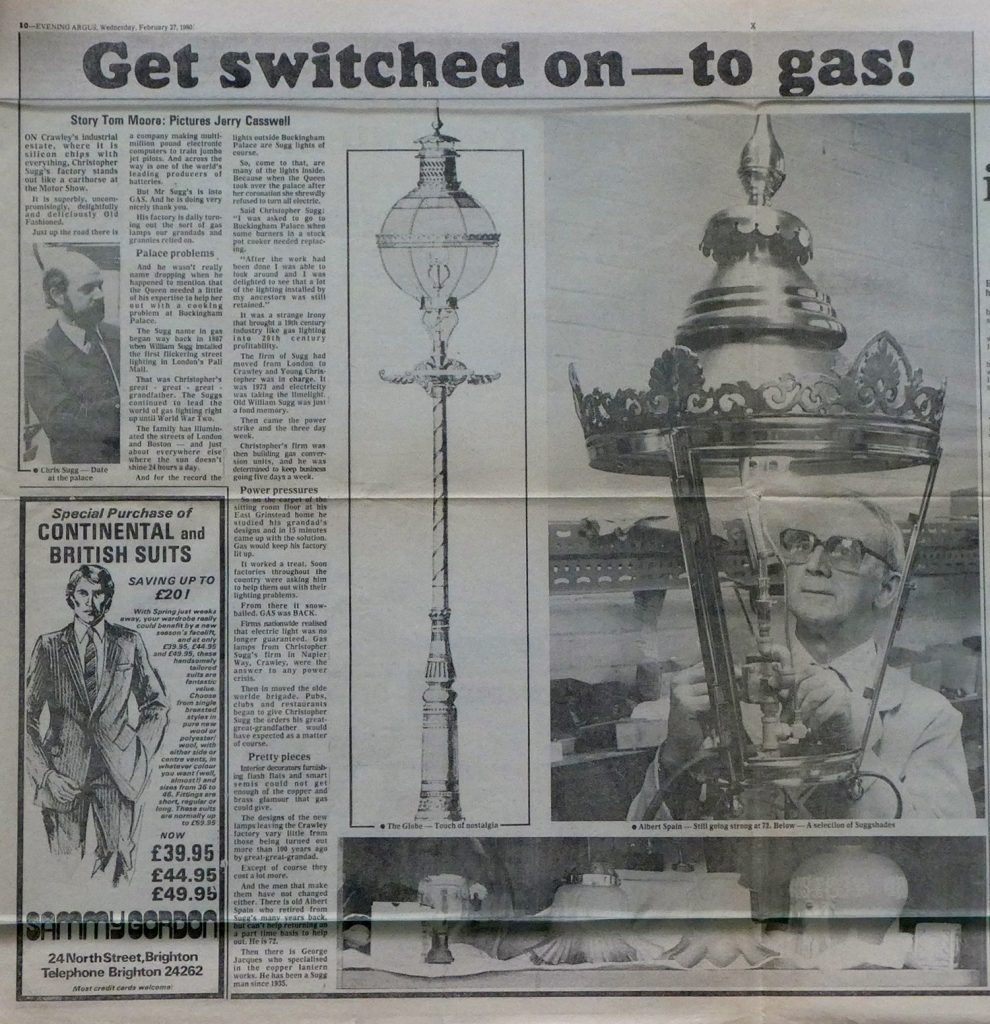
Centre page of the local Evening Argus Feb 27th 1980 (Click once and then again on the top cross to read.)
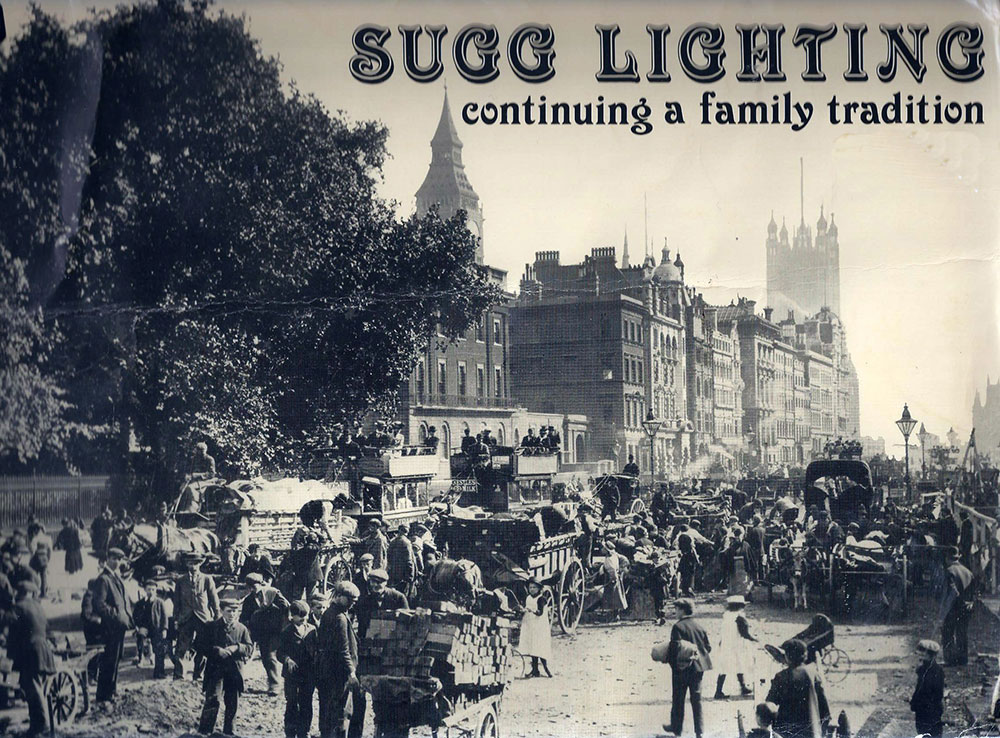
This wonderful picture of Whitehall around the end of the 19th C illustrates the replacement of the wood block road surface whilst traffic is still using the road. In clear view are the large Sugg Westminster lamps which by now look as if they have been converted to upright mantle but would have been open flame originally. If you click on the picture you can enlarge it further to look more closely at the detail. See the passengers on the top deck of the horse drawn omnibuses looking at the works! The picture is taken from somewhere near where the Cenotaph, War Memorial, is today. It was built in 1920.
UNDER CONTINUOUS ADDITION – PLEASE TRY AGAIN LATER
Copyright © Chris Sugg 2006-to current date

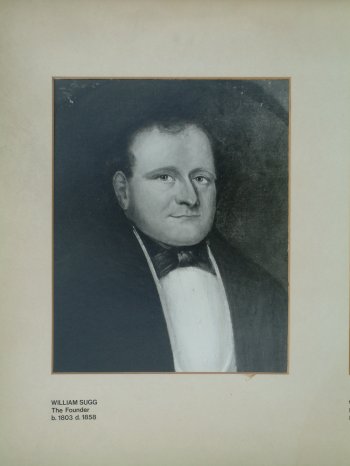
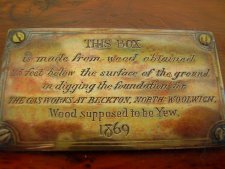
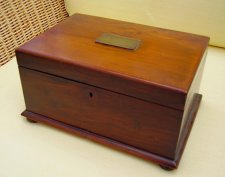
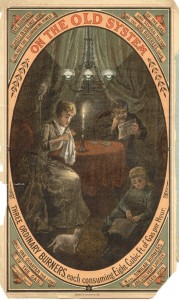
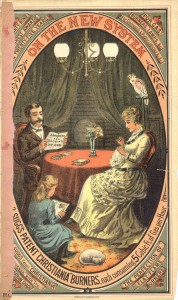
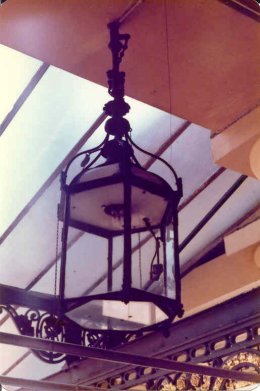
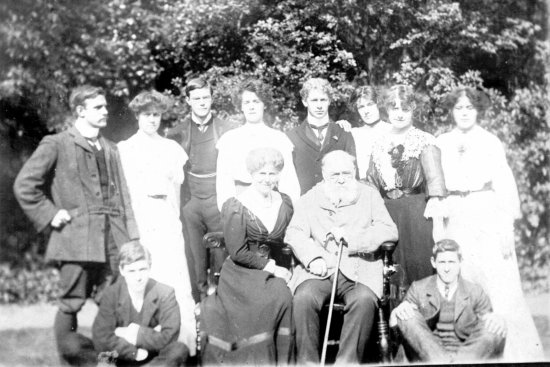
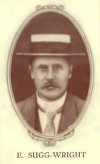
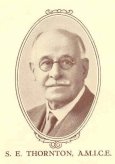
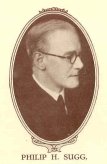
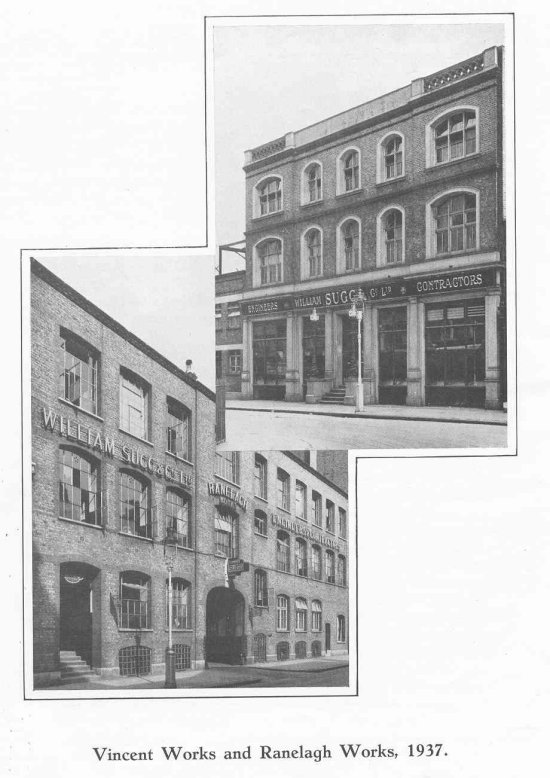
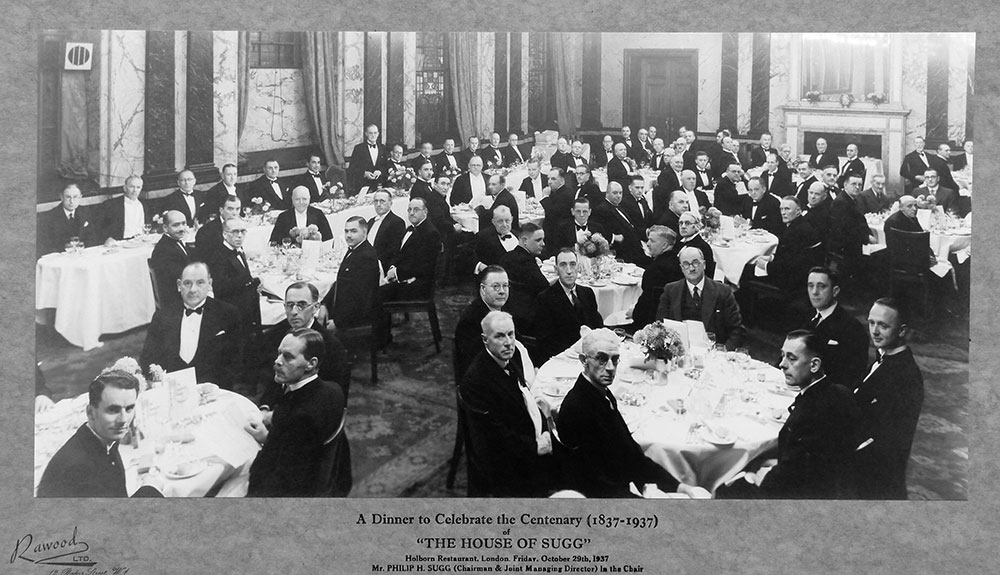
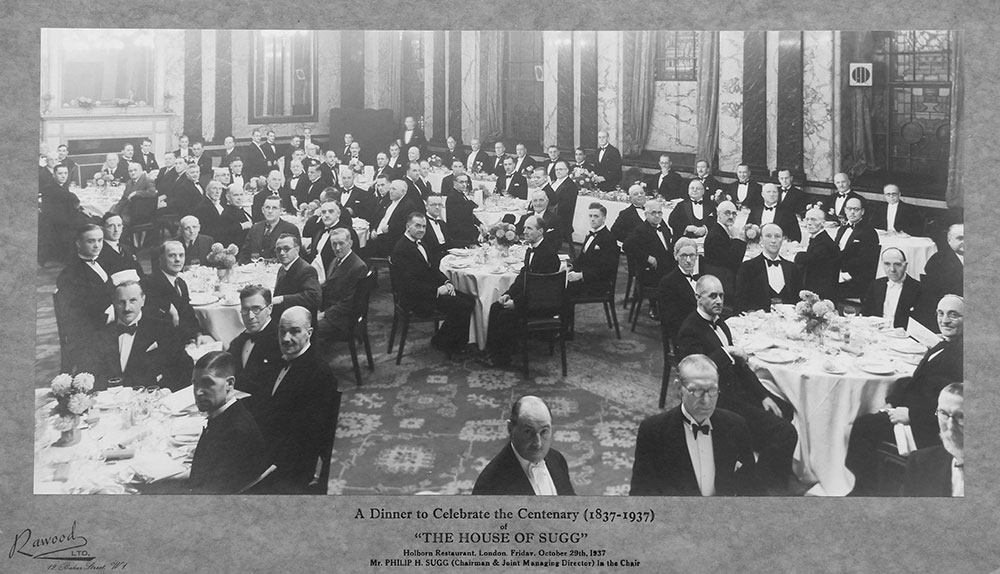
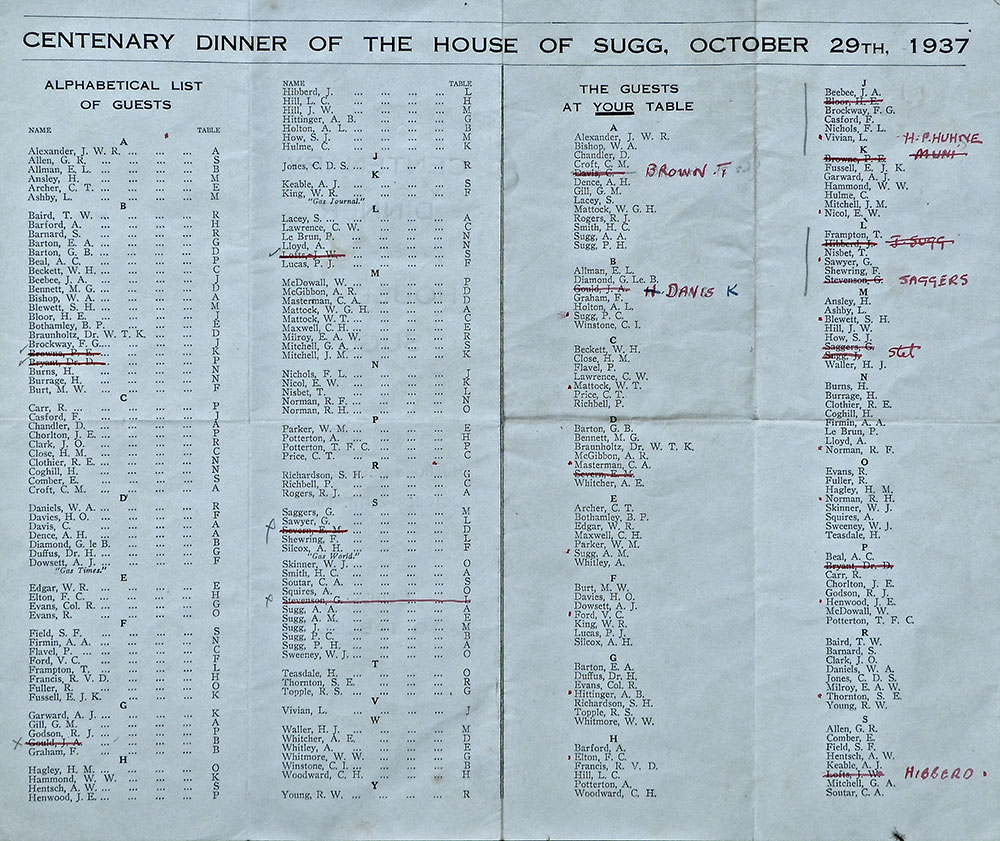
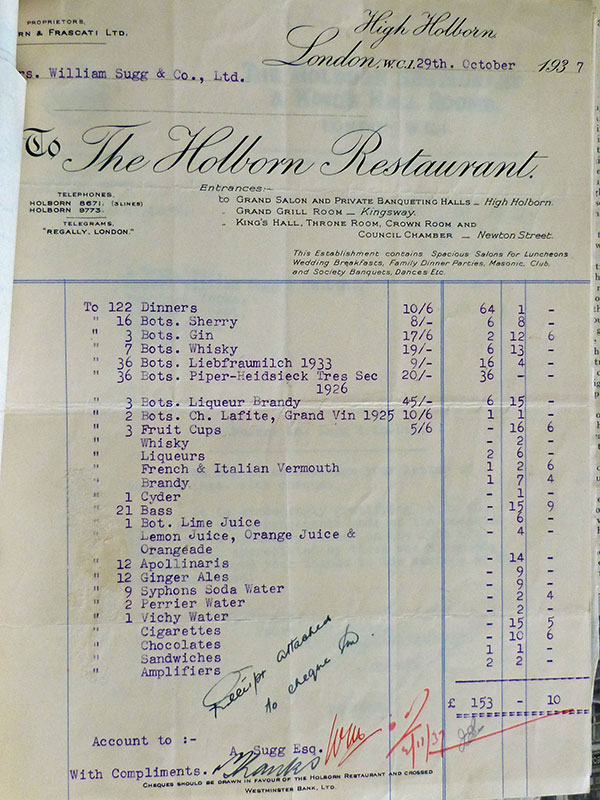
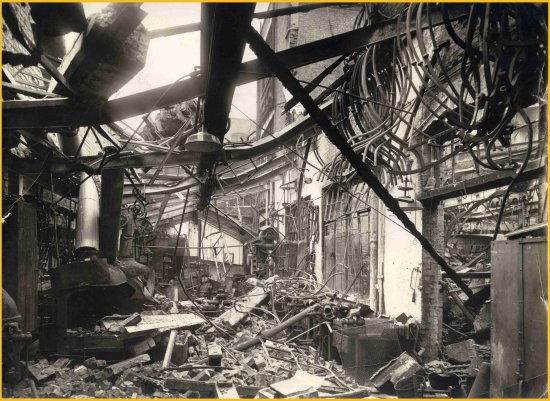
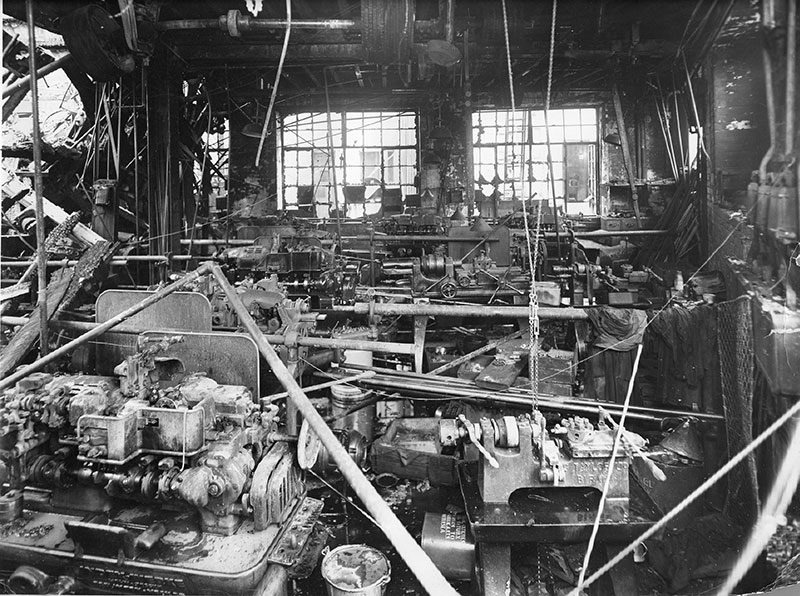
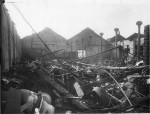
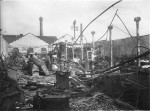
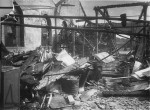
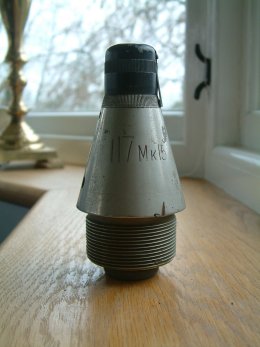
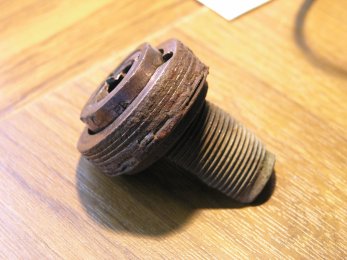
54 responses
My name is JOHN SUGG i am the son of JOHN WALTER SUGG and my grand father was ALBERT GEORGE SUGG born 1911 dublin IRELAND.My grand fathers father my great grand father was WATER JOHN SUGG BORN IN ENGLAND.I was born in DUBLIN IRELAND living in the USA now married with a son by the name of SHANE SUGG.
Hello John. I have lots of Sugg family information which I would be happy to share with you although probably better if we don’t clog up the blog! We are directly related and I have had correspondence with the Irish contingent in the past. William Thomas Sugg – the subject of most of this website – had 15 children (3 with his first wife and 12 with his French second wife) and they couldn’t all work in the business even if they wanted to! Several became involved with the gas industry in Ireland. Others with offshore lighthouses and at least one with Dublin newspapers. My contact from Dublin was Noel William Sugg who I have lost touch with. Walter John was WT’s 3rd son, born 5th Sept 1858. He had 11 children of which Albert George was his last, born 25 Feb 1911. He had 6 children of which John Walter was his 3rd born 16 Nov 1941.My record shows me you are the 3rd child of 6, born according to Noel Wm about 1970. Noel must be an Uncle of yours. Do you know what happened to him?
I would like to update my family chart if you are interested. Chris
Chris,I am the fifth son of Albert George Sugg, as far as I know Noel William sugg is still alive. If you look up,( Irish National Archives of Ireland),go to Clontarf East,you will see Walter John Sugg, 1,Conquer Terrace, Clontarf East, Dublin. I hope this is of some use to you, Bernard leo Sugg.
Thank you Bernard, good of you to respond. I see from the National Archive that Walter John was 52 at the time of that census, had 11 living children and had been married for 20 years. I will check that against my records and let you know by email, Chris
Loved reading the history. I read it as research of a lovely clock I purchased some years ago.
The clock is in a timber (probably oak) case measuring 14″ x 14″ with a beautiful white enamel face. It has a large movement with chain fusee, the clock face bearing the inscriptions “William Sugg, Gas Engineer” above a portcullis with chain with a large S in the centre. At the bottom of the face there is a further inscription’ ” Westminster”.
If you are interested I could forward photos.
Did you look at a fusee clock in the ‘Other Items’ section of ‘Technical’? If you put fusee clock into the search box it will take you to the top of that section and the clock is a little way down. The story is all there IF it is the same clock!! If not do please send me a photo and any information as I would love to include it. Thanks for your positive comments.
We are recording a book for the ‘Talking Books’ program at the Library of Congress about the history of cooking. It mentions William Sugg and we’d just like to confirm the correct pronunciation for our recording. I assume that it’s pronounced “SUG” to rhyme with “RUG”. Please confirm that for me, or set me straight. Thanks so much.
–Laura Giannarelli
Yes, Laura, that is quite right – SUGG rhymes with RUG! Of course over the years people have made many mistakes but the funniest is probably when they try to convert the 4 letters into some sort of Gas Company!
I have a copy of Jenny Sugg’s Cookery book which appears on this site if you need more information.
Dear Chris,
It is some time since we last corresponded and I’ve just looked looked at your vastly updated website. It was interesting to see my Mattock rellies’ positions on the seating plan for the centenary dinner. I believe there was supposed to have been some skullduggery associated with either W.G.H. or W.T. Mattock. Perhaps you can enlighten me?
Regards,
Dene
Hello Dene, I am glad you caught up with the steadily increasing ‘stuff’ on the website! As you say the Mattocks are mentioned quite a bit more and you can see them in the centenary dinner pictures. However, I don’t think this is the place to discuss ‘skullduggery’ even if it did occur, do you?!
Chris
I have learned of a great(?)uncle who worked for the company. His name was Harry John Waller. On looking at the seating plan for the 1937 centenary dinner he seems to have been listed on table M. The older members of the family seemed to think he was a director of the company, but I haven’t found any indication of that so far. Do you know if they were correct, or was he “just” one of the people in the office?
Hope you are able to help clarify this for me. Wendy Pearce
Wendy, Harry Waller is shown as ‘Cashier’ in the 100 years booklet of 1937. If you go to the flip book of this booklet set up on the Home page and click on the outer double arrow to the right you will find a photo of Harry at the top of the page wearing a bow tie. He can also be seen in the picture of the group on the roof of the newly rebuilt factory. When you click on the inner double arrows you are looking for page 14 which shows up as the two pages 14-15. Harry is the tall man in the top hat on the far right. I realise these will not be very clear pictures but if you would like me to send you a higher definition picture I can do so. Just checking I realise that the same picture is also in the History section 3 and somewhat clearer. Nearly all the people in the picture are named including of course Harry Waller!
Dear Chris
I have just purchased a wonderful Sugg Lantern light for my renovated Victorian house in Surrey. It will need some TLC to be operational. I read the history with interest and by coincidence my father worked out of Greycoat Street just across Vincent Square to the original Sugg’s works. I would imagine you have many examples of the lanterns but this one for interest bears the Patent mark – William Sugg & Co Ld Westminster – 13 – No 115_531. Much enjoyed the website and pleased to know the house will have a statement porch light (manufacturer as per Buckingham Palace!) Robert
Thank you for making contact and delighted that you enjoyed the website. It is good to hear of your connection with Westminster and your Sugg lamp purchase. It would be good to know what model you have. If it carries an original label it is likely to be a Windsor lamp as this is the one we see the most. If you would like to send me a photo I would be happy to add it to the website as another indication of the longevity of Sugg lamps! Chris
Hello Chris
Such an interesting and fascinating website.
In my attempts to secure information to the manufacturer of two Victorian brass fingerplates in my possession I came across your website.
The registration marks show the date of manufacture as 17 June 1855 but was intrigued by the impressed letters of:-
W.T.& S and wondered as to whether there was a connection to Suggs?
Kind regards
Tony Mallett
Hello Tony, the Company did of course have a foundry and cast thousands of items in many materials including brass over the years.The W.T.& S initials, whilst similar are not WTS which would be William Thomas Sugg and in fact if the date is 1855, the founder, William Sugg was still alive and running the business so I fear that you will have to search further. There are many sources of information and if you read the early part of the ‘History’ section you will see reference to several Post Office London Directories covering the date of your item. A visit to the British Library might help. Chris
Hello Chris
Many thanks for your reply and helpful suggestions.
Sorry that I was able to respond at an earlier date but suffered a failure of TalkTalks’ e-mail server.
With best wishes.
Tony
Hi
I was wondering if you could tell me if a lamp post that i have been given by my grand father is a Sugg. The lamp post came off the westminster bridge and is quite iconic. if you google westminster bridge lampost you will se the one i mean.Any infomation on this lovley lamp post would be greatly appreciated.
Hi Luke, The Westminster Bridge triple head posts are still in place so I am not sure how your grandfather managed to get hold of one. Can you send me a picture as it sounds like an interesting story. William Sugg certainly lit many of the Thames bridges in the days of gas but I will have to dig around to see if there is any comment about Westminster Bridge. Were there any lanterns with the post? Look forward to seeing a picture!
Can you send me your email address and I’ll send you a picture regards
Luke
Following receipt of a photo of Luke Wilson’s post I wrote:Hi Luke,
Well it certainly looks like the lamp posts on Westminster Bridge. This bridge in its current form was built in 1857 to replace an earlier bridge completed in 1750 and it is likely that the posts date to the construction of the later bridge. Interestingly, the previous Westminster Bridge was the first bridge and indeed one of the first instances of any thoroughfare to be gaslit in 1813. Clearly these lamps were replaced on the new bridge and in William Suggs book ”Modern Street Lighting” first published in 1871 he illustrates a lamp called the “Westminster” which he says is rather a modification of the hexagonal lantern than altogether a new pattern. He says that this lantern is the original Westminster as fixed in Dean’s Yard in 1868.
I somehow assume you can no longer ask your grandfather how he acquired the post? Did he have any connections with foundries as it is often necessary to cast more items than ordered to correct problems and even for other applications/locations.
This part of the post was the base to the triple head casting which would be a very expensive item to reproduce (not impossible) and then you would require 3 lanterns specially made. Even the base section is what I would call hefty and, should you want to mount a lamp directly on this section, apart from a means of adapting the casting to whichever lamp is chosen, you really need a BIG lantern otherwise it will look really puny against the post. One of the Sugg Lighting Westminster lamps – probably the biggest 30” version would work but the best thing to do would be to mock up a cardboard or timber model to the correct size and view the result.
You certainly have an unusual if not unique piece and I will be very interested to hear what you finally decide to do. The fact that your grandfather never did anything with it is perhaps a lesson!
Kind regards,
Chris
My grand father was a shot blaster and industrial painter years ago. He got the lamp post from a friend of his but that is all i know. I know the lamp post is pretty unique but could you give me a rough idea on what it would be worth ? I may find a gothic style large lantern to put on the top.
Regards Luke
I think that is a pretty good link to the post. A shot blaster would frequently be used to get surfaces clean on castings and of course they would then need to be painted. Maybe this was a spare or even imperfect casting – who knows. If it was cast at the time the bridge was built in 1857 it must have been lying around for a long time before you grandfather obtained it – but castings last a long time so —-
As for what it is worth you only have to watch one of the antiques shows on TV to realise that it all depends on where things are offered and to what market. There are of course architectural salvage of all sorts who collect lamposts from all over the place and stock them up until someone comes along. You would possibly get a better idea by simply asking one of the big ones what they would pay you for your post. Of course you might then be able to get more but you will be faced with possible transport and of course as it stands the only thing it might be used for is to hold a super flower basket. Chris
I will keep the lamp post as it is from my grandfather. I will try to kind a suitable lantern for the top I think.
Hi Chris my name is Wayne sugg I’m the eldest of Noel William sugg 3 sons ,he is still alive and kicking ,he was only talking about you to me the other day ,,I’m sure he would love an update and il get him to contact you soon,
Regards wayne
Hi Wayne, Thanks for getting in touch and I am delighted that your Dad is still alive and kicking – partly because he is the same age as me!! We communicated many years ago because he is also the same relation to William Thomas Sugg as I am i.e. Great Grandson. Please ask him to get in touch. I was in Phoenix Park about a year ago but, having had no contact for such a long time and having written to that address without response, I guessed he had moved or worse still, so I didn’t try to find him.
This website is really my on-going update and I am not sure that I had even started it when we first communicated. That takes it back before the turn of the century although I first started looking at the family history in the 1970’s which was of course really before the home computer came into use – especially for family research! Regards, Chris (He can email me direct on the William Sugg History address without going through the site if he wishes.)
Chris fantastic site to read as I wake up to go off and service gas boilers …….having just completed the family tree I’m pleased to find gggg grandfather and son were gas fitters around the city and east end and south of the river around the time your family’s buissnes was in full swing ….no doubt they would have used this kit. However my mind often asks who did they work for?. Were there sole traders in those days, were there ….small gas company’s employing men….. or did they have to be attached to a gas light and coke co….and would like today they only be allowed to work from the meter onward into said premises….I wonder if you could shed any light on this regards rob wood
Hello Rob, thanks for your comment and glad a bit of history can inform the future. I am also involved with CIBSE Heritage and they provide a lot of help to people who are dealing with ancient pieces of equipment that they know nothing about and we have some data or even someone who has worked on the item years ago! As for the role of gas engineers in Victorian times I have never looked at this but it is clear that all the gas works and gas related organisations must have employed thousands of engineers for installation and maintenance and it would seem highly probable that sole traders would also appear to offer their particular services. I just hope they were trained properly. This of course would relate to regulations and the development of standards which is where the organisations such as the Institution of Gas Engineers would come in. Almost certainly the first sole traders would do absolutely everything from digging the hole, erecting the lamp post, laying the supply and making the connections – all without machinery!
Hi Chris, I shall be searching your fascinating web site for details on lighting as I stumbled on the page ‘Special Street Lamps for Royal Premises & Other Locations.’ I’m writing a fiction book set around Windsor Castle at the turn of the century and wondering when these lamps would’ve first appeared, and if they would’ve been on at night?! Did they surround the castle? Who would’ve turned them on and off? This would be fascinating for me to discover and I shall dig further into the reams of info you have on your site. Thanks so much.
Hello Mel, Thanks for your interest. The section you mention was intended to give a space for what appear to be a whole lot of super-specialist individual designs that were clearly intended for Royal premises, particularly because of the crown. From your point of view the town of Windsor is what gave the name to the much more famous and widely used Windsor lamp which was introduced in 1898 as the first lamp manufactured by William Sugg specifically for the gas mantle. The earliest illustrations show this lamp with a lighting port and an upright mantle so they were clearly lit by a lamplighter using his ‘torch’. As the ‘Royal’ lamps have been retained in and on their original sites they will, however, have been updated with later technology as you can see. The magnificent lamps on the front wall of Buckingham Palace still running on gas date to 1901 (See History and also Location Pictures). Exactly how they were first lit is a matter of conjecture as there is no literature or written data on these lamps and any drawings that might have existed were lost in the Blitz when the factory suffered a direct hit. (See History) My guess would be that a lamplighter (or two) would have been retained specifically to light and extinguish all the lamps around the exterior and interior courtyards. They would also have been responsible for keeping the glass scrupulously clean so perhaps a ladder would have always been used. (I have other Royal premises lamp pictures to add especially from the time of refurbishment by Sugg Lighting prior to the Royal Wedding.)
Hi Chris I have enjoyed reading your fascinating history of the the Sugg Company.I note that you were in Dublin’s Phoenix Park recently. I am currently researching the Park’s history and I am particularly interested in the gas lights especially a Sugg light which has a series of small mirrors built into a part at the back of the lamp to project light onto an object. We have managed to have one restored – I was wondering when these were introduced and where else they were in use. I also met Noel Sugg many years ago and I am also glad is well as per Wayne’s communication.
Hello John, thanks for your comment. Do you have a photo of the one you have restored? The lamp with a great ‘scoop’ mirror that I remember well in Phoenix Park was a variant of the Rochester. It is shown on the Rochester & Littleton page https://williamsugghistory.co.uk/?page_id=344 right down the end just before the Restoration section. This version is shown in a photo of one of the gates of the Park but I don’t think I have included it yet but when I find it again I will add it! I am slowly working my way back through the collection prior to handing it all over to the Westminster City Archive which is located quite close to the original location of William Sugg & Co and I felt William would have approved! I have no other illustrations of this particular reflector anywhere else so all I can say is that it is almost certainly between wars, say 1930. Of course it may not be the one you describe so do send me a picture and I will also add it to the site as another demonstration of Sugg product longevity and collectability that you can also see demonstrated through the comments on this site!
Coincidence is everywhere about us and following viewing an episode of Salvage Hunters in which Drew Pritchards, much to his interest, came upon an item from the Suggs Lighting Company. His description raised my interest and subsequently I found the Williams Suggs History.
This I was quickly absorbed by and suddenly even more so when I fell upon the Beckton Gas Works Committee photograph of 1870. There on the right was a Wyatt who looked a ringer for some of my elderly relatives who had moved down to East London from Suffolk in the 1800’s.
Please excuse me for asking but did your original photograph contain any more precise information, as for example the full name of the individuals shown. It would be marvellous to tie this man up with others of the Wyatt family or indeed could he be a direct descendant?
With thanks and regards,
Russell Wyatt
Hi Russell, the picture of the Beckton group had the names on the reverse but nothing more. I recognised William Sugg of course on the left hand end and as I mention in the text a couple of the others. Mr Wyatt, however, will need a little more research – perhaps at the Institution of Gas Engineers and Managers.
My grandad is roger robinson brother of Francis Robinson I believe and he always talks about sir William sugg it’s great to see that history has not forgotten the robinson name so thank you
Hello Lewis. Thank you for reading through the Sugg history and coming across the Robinson connection. I mention that I actually met Frances in her home in Bushey Heath along with my wife and daughter in 1987. She died in 2005, making her 98. There are many connections with the Robinsons so I will send you an email with lots more details and you may be able to fill in the gaps down to your family and I will put them back onto the family tree. Chris
Hi Chris,
An excellent site and record of the Sugg history. I have been talking to my Uncle and getting him to recount his memories of H J Waller. I note that you responded to a Wendy Pearce in 2015 and I can shed some more light on H J Waller. The picture of the Centenary Dinner did include H J Waller (jnr) who was a Cashier. His father, H J Waller (snr) had died in March 1937 by the time that dinner took place. The 100 years leaflet unearthed by my uncle goes into some detail about H J Waller (snr) who joined Suggs as a Clerk in 1879 and ultimately became Secretary and then joined the Board until his retirement in December 1936. We also have a silver box signed by the board directors and a framed photograph presented to him by Suggs.
You probably have the 100 years booklet, but if not I can provide a scanned copy. It would also be useful to contact Wendy Pearce with this new information.
Hello Julian,
Thank you for enjoying the site and remembering the 2015 correspondence with Wendy Pearce. I have copied her original question and my answer plus your comment which of course also clarifies the situation for me as I had no idea that there were father and son HJ Wallers’! It is one of the major problems in any family history work and it nearly happens with William Sugg because the founder William died quite early and his son William Thomas decided to call himself just William Sugg to ensure that everyone knew it was his company!
What also interests me in your response is who is your Uncle and what is his or your connection with the company? Clearly you are related to the Wallers as you have the presentation items. Would it be asking too much for a picture of the silver box with, perhaps the framed photo behind it or in the same picture. It would be a really nice thing to add to the section on ‘People” that I started relatively recently. I am currently working on an upgrade as Word Press have made some changes which affected the site so it would be a good time to add some more personal stuff!
The 100 years booklet that is now coming towards its own 100 years is on the site in the Home section but now requires a download to work. It’s this sort of thing that has to be sorted. In order to connect you with Wendy Pearce I have blind copied your address on the email so if she does want to come back and I have agreement you can correspond with each other – perhaps you are related? Kind regards, Chris
Hi Mr Sugg
I work at Tower Bridge as a Welcome Host and for my sins I also do a lot of the research with the archives. I am sure, if you have not done so already, our Exhibition development manager will be delighted to talk to you about Suggs contribution to Tower Bridge. You can email him at pe****@*************rg.uk. You may also be aware that most of the original gas lamps were moved in 1966 and are now at the Barbican Arts Centre – next to the city of london school for girls. I have very much enjoyed reading your website as it has given me a great in site into the work of your Great Grandfather. It will help me pass some of it onto our visitors.
Thank you for sharing, history like this is very important.
kind regards
Iain
Hello Iain,
I have replied at length to your kind comment and the connection of Suggs with Tower Bridge which is mentioned within the site but is now the subject of another of my occasional blogs once completed. I am happy to continue our correspondence!
Regards,
Chris
As a Post Script: You may also be aware that W Sugg & Co Ltd were allocated 15 tickets to attend the opening of Tower Bridge on the 30th June 1894 (recorded in the minutes of the Bridge House Estates grand committee – 11th June 1894).
kind regards
Iain
I have a Sugg & Co original cast iron lamp post that I have painted for an elderly friend who has collected vintage reclaims all his life. I have delved into every photo I can find online of the various models. I can’t find one the same anywhere. He would be delighted to find out where it originally stood and any interesting information connected to it.
Tania, send me a picture and i will see if I can help. ch***@*******************co.uk
I received a great picture of a very expertly painted ‘barley-sugar’ post with a cast label ‘Sugg London’ which is a bit doubtful because they always called themselves Sugg, Westminster. I might add it as an interesting item in due course once I get the OK!
With havin so much written content do you ever run into any issues of plagorism
or copyright infringement? My blog has a lot of completely unique content I’ve either created myself or outsourced but it looks like a lot of it is popping it up all
over the internet without my permission. Do you know any ways to help
protect against content from being ripped off? I’d really appreciate it.
This website is for information and to provide the history of a Victorian company that provided gas equipment all over the world. It is entirely written by me and nearly all the illustrations and photographs come from a huge collection left behind by predecessors. Yes, I see many of my pictures ‘re-used’ but not so much writing because it is often technical and detailed that only people who are really interested will bother to read. It is possible to add information on top of documents that make them less easy to copy but if you are trying to make money from your blogs you need to ask someone involved in e-commerce.
I am currently doing writing research on heritage gas lighting. Wondering if there is a way to communicate with you by email directly. Much appreciated.
Send me an email explaining your project to ch***@*******************co.uk
I am intrigued to see on your 1880 letter head a small vignette of William Sugg’s Illuminating Power Meter. I have owned one of these amazing looking instruments for many years but I know little about it. Who might have originally owned it, and during what sort of period might it have been used? It’s a very large and heavy – hardly what you would call portable!
The Illuminating Power Meter has a page to itself in the large catalogues. The one I have copied is from list 6 Dec 1909 which I have sent to your email address.
If you would like to send me a photo or two I will add it to the website to show how these remarkable pieces survive.If you include some familiar item for size comparison, that would be great. Send it to the email address I have used to you.
Regards., Chris
This site truly has all of the information I wanted about this subject and didn’t know who to ask.
I nip in and out of my family tree. believe I am directly descended from Lizzie Sugg.
My paternal grandmother was born Kathleen Stockton. My great grandfather, her father, Alfred Leonard Stockton married my great grandmother Aline Friedleben. Aline was the daughter of Lizzie Sugg, my great great grandmother. I think this makes William Thomas Sugg my great great great grandfather.
Hello Julie,
That sounds entirely plausible with the Stockton and Friedleben connections. I would need to check my records that takes a bit of doing but if you want to communicate by email we could soon see if your records match mine. Sorry about delay in replying but you can email direct to ch***@*******************co.uk
Kind regards, Chris
Hi Chris.
I hope you don’t mind me writing to you with ref to my own ‘Sugg’ wall lamp.
It has a makers plate in reference to William Sugg & Co Westminster. It is copper and has a fancy top rim. The odd feature is a round hole at the back which used to clip onto something ? It also has a strip protruding from the back. I have photos but no facility to attach them. The lamp is patented but doesn’t have any number. I presume it is a gas lamp from 1881 but what fits into the center ? Hopefully you may have catalogues or information on this.
Kind Regards.
Julian Hanwell.
Hello Julian, apologies for very late reply. I really do need a picture of your lamp to provide a realistic answer. You can snap a picture with a mobile phone and send it to me via mail or any other way. It is easy to attach a photo to an email which you can send to ch***@*******************co.uk
If in doubt why not ask a friend to help.Regards, Chris